-
Posts
232 -
Joined
-
Last visited
Content Type
Profiles
Forums
Gallery
Events
Posts posted by John Gummersall
-
-
Earlier I was commenting on how I was in a quandary over the simulated tar paper for the Hurricane Deck, Skylight Roof, Texas Roof, and Pilot House Roof. Instructions call just to paint them all black, but others have commented that cutting silk span in strips and painting them black gave a realistic looks of tar paper. No way at my skill level was I going to be able to make strips of silk span look anything like tar paper. Beside, silk span seem to be really hard to find and very expensive.
Cathead had suggested using overlapped masking tape strips and painting them black. That sounded like a neat idea and one that I could probably manage. Below is my attempt at applying the masking tape strips.
If you look closely you will see the overlapped strips simulating the tar paper seams. Once they are painted black I think they will be a good simulation of tar paper strips
Hurricane Deck
Skylight Roof with Texas dry fitted.
Texas Roof - You can see the outline where the Pilot house will be located
Pilot House Roof
Tomorrow I will get out the spray gun and a lot of black paint and spray away....
-
Started working on the stationaries... Stationary should extend above the boiler deck floor by 1/16"... In my case I felt it easier to make a little jig to insure they were all consistent. Below shows the jig. It really made it easier. Just placed the jig atop each stationary hole and inserted the stationary from the bottom until it hit the top if the jig. Also depicted in the below shots are the other jigs I used to insure equal spacing between the main and boiler deck. I would strongly suggest something like them. They take all the sport out of trying to insure a level deck.
On to the Texas. Instructions here call to do something similar to what was done with the boiler deck walls. Make a jig and slightly score the etched marks to make bending them. It also says not to wet them due to the wall would end up cupped in the drying process. With my skill,,,,, no way was I going to be successful scoring those walls and bending them into the jig without breaking them. I more skilled modeler could do it, but not me. Instead I really needed to soak the walls to make those bends, but did not want the cupping effect. The cupping effect comes because the jig they suggest using only supports the bend in three places. A full jig that supported the entire bend would prevent the cupping effect.
I found that a small juice can is very close to the proper bend that is required for these walls, and fully supports the entire wall over the bend. Thus I was able to soak the walls, bend them around the juice can, and let dry. The additional pieces of wood help support the wall over the bend.
End result is very close to the actual bend required.
At that point you can briefly soak the wall section and then use the suggested jig to get the required bend. Since the original bend was very close to the required size, the second bend in the jig has far less stress on the wood and thus not cupping as it dries.
End result is a pretty good bend and way better than I could have done it by scoring the walls.
Note I have also attached the 3/16x3/16 wood strips around the top of the Texas. I really liked them vs the suggested 1/16x1/16 strips. Much for forgiving and give a great gluing surface..
Since the Texas is a curved structure, one long strip will not do it. You have to break them into smaller pieces to more conform to the Texas curved top.
I attached this picture just to show once again that "you can never have enough clamps" 🙂
Here is a fun fact that a more experienced modeler would know (obviously not me). Never assume the instructions or diagrams are correct. Always verify 🙂
Below is a picture the the Skylight roof showing where the Texas is to be located. Foolishly thinking the etching was correct I happily glued the 3/16 square strips on to it in preparation for installing the Texas. Note below the etching is not in the center of the Skylight roof. After the strips were dry and I dry fitted the Texas, the problem was very obvious. The etching is 10mm from the port side and 7mm from the starboard side. Thus, time for the alcohol and pry up the strips and re-center the Texas location. Maybe it is just my model, but please verify before you glue down the strips
-
-
It has been some time (to say the least) since I last posted. Been out of town and away from the shipyard. I was able to take a few part with me to work on remotely. Was not able to take the hull due to it's size.
Completed the boiler deck structure walls. Not a lot to say about this as it is pretty straight foreword, but very very repetitive. You will go crazy with all those 1/32" vertical pieces on the walls and then sanding them down to 1/64". After the vertical pieces were stalled, the walls were air brushed white. Afterward the red doors were attached with door knobs.
Next took on the two boiler deck stairs. The forward stairs are is the larger on the and smaller steps goes on the aft starboard side. Only issue I had here was the fact that the step "runs" (on both sets of stairs) were a little short. Not sure it it was to do lack to skill on my part (in assembling the stairs) or were not sized right at the factory. Either way, they could not be used or there would have been a small gap in each step. There is plenty of 1/16" wood supplied with the kit and it was easy just to make new "run" steps and use those instead of the supplied ones. Still need some touchup paint, but they are more or less ready.
Finally took on the Pilot House. This also is pretty foreword. I ordered a 1/48 scale pot belly stove and ships wheel to add a little more detail, but they have yet to arrive. As for the window, I know some have split the windows to simulate sliding windows. Not sure I have the skill to do that. I tried to simulate that by holding up one window over the other to see what that looked like but I just could not get it to look very good. I may try again when I get to the ship yard, but at this time I am leaning just to use the whole windows. As for the foreword window, that one will remain open. Still need some touch up paint when I get back.
View of the foreword side
Back side view
View with Pilot House top on top. Not painted yet, just wanted to see what it would look like 🙂
On the topic, I am still on the fence as to the covering for the boiler deck, Skylight, Texas, and Pilot House. Kit calls just to paint it flat black to simulate tar paper. I know others have used silk span strips to better simulate tar paper, but I am having trouble locating some silk span. I found some at BlueJacket Ship Crafters, but it is $6.00 a sheet with $6.00 shipping. Not sure I want to go down that road, but I admit it would look much better than just flat black paint. Have to think on that some.
And below are the windows mentioned above. At this time they just have one coat of while paint. Again an airbrush makes this task really easy to get a smooth finish
-
Olha,
Oseberg has been on my list of future builds. The version of Oseberg from Pavel Nikitin looks really good. This may be my next build. Looking forward to following your build.
Excellent unboxing video. Really first rate.
john
-
As planking proceeds I guess it is time to air a little dirty laundry....
In regards to the boiler deck, the instructions call to glue the four pieces that make up the boiler deck into one solid piece and then attach it to the hull. That part is good... problem is since I was planning on planking the deck I felt it would be best to plank it after it was attached to the hull. My thinking at the time was that the extra glue and planking might make the deck stiffer and harder to attached to the hull.
There are two problem with that logic...
First issue is that since the vertical stationaries have not been attached yet, there is a lot of boiler decking in the front half of the boat without much support. And 1/16" planking being what it is,,,,, it could easily break when applying the planking if too much pressure is applied to the planks
Ask me how I know this 🙂
You can see from the picture below where a little too much much pressure was applied.... calling for a repair job. What you can not see is all the tears..
The second issue with planking the deck after it is applied to the hull is also related to the lack of support on the deck. That being the glue as it dries tends to bend the decking (that is not supported) upward. I don't have a picture of it, but with the decking curved up on both sides, the hull looked like a bird flying. Thus repair job #2 comes into play. Basically I wetted the boards that needed to be bent back into shape and added some (shall we say) persuasion to hold them down. To insure they boards did not bend too far down there are some 3/16"x3/16" temporary support posts applied along the side of the hull. They are not glued and just held in place by the pressure of the "persuasion".
Once the deck dry they will easily be removed. Disaster averted..
Had the same issue with a stern section but got creative with a clamp for the "persuasion".
So,,,, if you plan to plank the deck I would suggest you plank the deck before it is attached to the hull. The planks will tend to bend the deck, but at least you will have a flat surface to add some weight to hold the decking down until the glue dries. And in reality the extra 1/32" planking will not add that much stiffness to the deck and will certainly be easier than trying to deal with split and bent decking if you plank after the deck is attached to the hull. Dumb you get early,,,, smart you get late 🙂
Tomorrow I will do the same process to the other side of the boiler deck
-
Finally started the planking of the boiler deck.... I hate deck planking,,,, I really like the look, but I hate doing it. Way to tedious and the process gets old pretty fast. As before I used the 1,3,5,2,4 planking pattern.
Since deck planking is not fun enough I decided to take a break from planking and have even more fun with the 1/32" square battens on the boiler deck walls. Talk about getting old fast,,, wow..
Prior to planking I painted the walls just to get the first few coats on them. I then added the 1/32" square battens. After that I will just air brush to put on the final coats. Probably could have just waiting until all battens were installed, but I figured it would be easier this way. Once all is painted I will add the windows/doors that were painted earlier. Instructions call to sand the 1/32" battens down to 1/64" to look more realistic. When I first read that I thought that was some sort of designer joke, as no way (at my skill level) would I be able to do that. But when you think about it, after the battens are glued into place, a sanding stick easily trims them down to look more realistic.
Note in the stern wall section the battens (in red) do not go all the way to the top. This is to allow for the deck trim (added later) to not interfere with the battens.
In order to get a better connection between the side and bow sections, I added a piece of scrap wood. I plan to connect the side and bow sections together and then put the structure onto the boat. If I glued the pieces to the hull separately, I have a feeling that joint would not go together too well.
Looking ahead I noticed a little issue,,,, with next boiler deck ceiling (Hurricane deck floor). What is wrong with this picture?
Seems to be an issue with the smoke stack hole on part 123S. 🙂 Not a big deal, it will be awhile before I get to that point. I opened a ticket with Model Shipways and I am sure a new part will be here well before I need it.
- Cathead, Prowler901, Blighty and 1 other
-
 4
4
-
-
Brian and Cathead,
I mis-quoted earlier when I said the instructions called for mounting the bull rails on the 1st two posts. In reality the instructions just said to "mount the bull rails" - do not really say where to mount them. I got the idea of the 1st two posts from looking at diagram #2 .
Actually diagram #2 is old and really needs to be updated. Diagram #2 not only shows the bull rails mounted incorrectly(red highlight), it also shows part 39A extending forward (green highlight). Looking back at earlier build logs it was discovered (and reported to Model Expo) that 39A had to be trimmed back due to interference with the smoke stack covers. Model Expo took note of the exception and updated the instructions with the following comments.
Also note that parts 39A P/S will have to be cut away at the forward ends where they are in the way of the smoke stacks.
They did not update the fact that that the smoke stack covers also interfered with the bull rails causing them to be mounted farther back than on the diagram.
Anyway, not a big deal, but for newbie's like myself that foolishly follow the instructions/diagrams, I thought I would point this out. Bull rails do not get mounted on the 1st two posts due to interference with the smoke stack covers
-
Been awhile since I last posted,,,, Holidays and other stuff seems to have diverted me from building... Anyway I have not been completely idle. Started painting the boiler deck walls with air brush. There is defiantly a learning curve with one, but learning is pretty quick. All the window/doors have been painted, but not yet attached. Air Brush is defiantly the only way to paint those. Painting the window/doors with a rattle can or brush would be a challenge.
After bending the steam valve pipe air brush comes in handy painting it copper. I know the steam pipe does not go directly into the smoke stacks, but bending was a challenge to me and once I got to touch the support, I did not want to risk messing it up. There is a slight indent opposite the steam pipe to accommodate the smoke stack so I guess we can assume the steam pipe goes through the support and into the stack 🙂
Instructions call to mount the bull rails on the first two support posts in the boiler room. Problem is, even though the boiler support structure is inside the support structure, the smoke stack protrudes outside the structure. So bull rails need to be attached to the 2nd/3rd supports posts. I do not think is "builder error" and instead a design flaw, but knowing my skill, builder error may have come into play.
Below you can see the smoke stack bulging out just after the first support beam,
Also still need to get out the alcohol and do a little glue cleanup.
Earlier I glued the two front sections and two back sections of the boiler deck. I was planning on just gluing the two sections together when I attached them to the hull. But after thinking about it, why not just have the one deck piece and glue the entire deck onto the hull. I glued a few extra strips of wood over the joints to add a little more strength. That may have been overkill.
And finally boiler deck was glued onto the hull with some additional (shall we say) "persuasion" to have it conform to the hull curve.
- bobandlucy, yvesvidal, Cathead and 2 others
-
 5
5
-
-
It has been awhile since I last posted... Lots of non-model building activities had grabbed my attention. I should be back at it for awhile. 🙂
Even though the main deck is not quite completed I wanted to try my hand at bending the four boiler deck walls. The sharp angles of those curves to me just seemed like a great opportunity to break the walls in the bending process. Especially since they want you to increase the slots in the wood to make it even thinner... and do it dry instead of wetting the wood.
Anyway, knowing I would be breaking a lot of wood I wanted to practice those bends with some spare wood. I highly suggest you do that if you can. After breaking a number of test pieces trying to get the curve correct, I found a way that for me that worked well for someone of my limited skill level.
For the larger forward curves I did soak the walls but instead of initially bending them in the supplied jig I bent them around a 1 1/2" PVC pipe. The problem with wetting the wood and using the supplied jig is that the wood wavers between the three jig curved sections. If there were maybe 5 curved sections in the jig instead of just 3 then wetting the wood probably would not be an issue. Wetting and bending around a pipe seems to have solved this issue.
Once dry the final bend is pretty close to the required bend. Just a little off.
At that point only rub a little water (so not to cause the walls to warp) on the wall and then put it into the intended jig. Since the jig is only putting in the final bend it works great and no danger of breaking the wall section
End result is a curve that works and easily accepts parts 84A (top and bottom) to secure the curve
And dry fitting to the boiler deck - should be ready for adding the battens and painting
The aft bends are a little more difficult but the principal is the same. For these bends I used a 5/8" down rod to bend the wall around. That turned out OK but the bend was a little too sever. If you choose this method to bend you walls I might suggest trying a 3/4" or 1" dowel (or pvc pipe).
Even so, after drying, re-wetting, and putting into the intended jig, the outcome is the same. A pretty good bend for the back wall.
No matter how you choose to bend your walls,,,, practice, practice, practice on spare wood before actually bend the walls. It will save you a lot of tears.
- Prowler901, Cathead, yvesvidal and 1 other
-
 4
4
-
Brian,
Thanks for you comments on the alignment, but I think I have it..... or at least the alignment with the main deck and the boiler deck. I learned the alignment lesson the hard way on the King of the Mississippi. That was one of my earlier models and I did not think about alignment until it was too late. Paid the price for that lesson.
As for the cleats.... thanks for beating some sense into me... I had cleaned them up before mounting them, but I agree, they need to be painted. I should be able to paint them in place.
-
With all the main floor parts prepared and painted, started the assembly.
When I came to part 37B (the part above the main door way, it seemed to be a bit (1/16") off. Probably due to lack of builder skill, but I am going to rack it up as variations in the wood. Thus two 1/32" scrap pieces were added to each side of the piece.
Seemed to fit better at that point. Will add some paint and glue into place.
Also note I left the cleats unpainted. To me, I just like the look of metal cleats.... Not realistic, and I may paint them later on,,,, but for now, I need to think about that. 🙂
Assembly continues
As mentioned earlier, boiler system not glued in at this time. I wanted to dry fit the boiler room floor (main floor ceiling) just to verify the exact location of the boilers
When preparing the boiler room floor (parts 49 A/B & 50 A/B) it talks about turning them over and gluing some small strips of wood along bottom (main floor ceiling) to strengthen the seams. It also makes note to place them where they will not be seen or interfere with any of the main floor structures. Rather then doing that I choose to place the strips on the other side where I know they will not be seen and will not interfere with any structures. Hope I am not shooting myself in the foot here, but it seems like a good thing to do. Time will tell.
Finally, laying the boiler room floor pieces in place I can exactly place the boiler in order to correctly accept the smoke stack covers. Picture is not completely accurate as it seems the boiler moved between lining it up and taking the picture, but you get the idea. To me, with my lack of skill, (and variations on wood), there is no way that boiler would have lined up correctly if I just glued it in place where it was indicated on the plans. It would have had to have been off by a little bit. This way the stacks will line up and if the boiler is 1/32" or 1/16" out of place it will not be noticeable.
- Paul Le Wol, Cathead, yvesvidal and 2 others
-
 5
5
-
Brian,
Yes I used the 1.6mm and the 1.2mm rivets from Model Motercars. Below is the exact description
Item SKU
Rivet - 1.2 mm Head Diameter - Brass - RT12
Rivet - 1.6 mm Head Diameter - Brass - RT161.6mm rivets are great for the larger ones, but I might suggest the 1.0mm or maybe even smaller for the smaller rivets. As you can see on my model, the 1.2mm rivets kind of overwhelms the parts they attach to. I think smaller would be better for those.
As for the heads of the rivets, I cut off most of the shaft but left a little stub to insert into a drilled hole. In order to do that you need a .5mm drill bit. If you have one, then drill a small hole and with a touch of CA glue the rivet easily sticks into the hole. If you do not have a .5mm bit then you would have to cut off the head and attach with CA.
John
-
Brian,
Thanks for your comments,,,, as for the "added walls for the front of the machine room", I kind got the idea (or stole the idea) from your log. You built a really neat wall structure of cargo crates to help cover the opening. They look great and add a nice touch to the model.
-
Stairs are complete. The extra longer risers nicely closes the gap between them and the tread.
At long last all the compartment components for the main floor are complete and ready for installation. Below are the walls for the aft compartment. Horizonal strips (1/8" x 1/8") were added at the top of the wall (per instructions) to provide a better gluing surface for the boiler deck. In addition I added some vertical strips to provide a little vertical support in the event I am feeling strong and attempt to press down a little too hard when gluing the boiler deck to the main deck walls :-).
One additional feature I added was two partial walls at the front end of the aft compartments. The are circled in black. Instructions say to leave that open, but to me that is really a big opening. On the finished model, one looking into the model from the side could easily see the gapping wide open compartment and rough inside walls. The two walls do not completely fill the gap so it looks more like a small opening into the aft compartments.
Turn the pieces over and we have the finished walls. Again the two extra partial walls are circled in black.
Below are the foreword compartment walls. Still need to attach the 4 cleats to parts 37A. Other than that, I am ready to mount the walls.
Speaking of the cleats, I am not sure if the author is a comedian or I just do not have the correct skills, but in regards to mounting the cleats, the instructions say
"A professional modeler would likely drill and pin the cleats"
IF that is the case, then I am defiantly not a professional modeler. I have some small drill bits (.3mm) but no way would I even think of drilling and pining these cleats. Below shows the one of the small cleats (on the tip of my finger) to be added to part 37A. In my case CA glue will have to do.
-
I agree with others..... Your planking is really good. Ship looks great so far.
-
Brian,
Thanks for the tip on mounting the rudders. I was planning on mounting them now as I thought they would be "more or less" out of the way. But I did not think of potential clearance issues with the paddlewheel down the line. I like your idea of holding off until I see what sort of clearance fun I have with the paddlewheel.
As far as the stairs are concerned, I seem to have stumbled on a solution. It seems the risers and runners are about 1/8" by something really thin (maybe 1/64"). I had some extra 1/16" x 5/32 strips and if I remake the risers with these strips the steps seem to work out. As you can see the 1/16" x 5/32 strips are about 1/32" wider then the original risers (and a little thicker.
By just replacing the risers the steps seem to fit. The extra height fills the front gap and the extra thickness fill the gap in the bap. In the below picture the top two steps seem a little short, but I have a slight outward warp in the walls at the top of the stairs. When I bring them in, all will (or should) look like the third step. We will see what happens after the new risers are painted and put into place.
As long as we are talking about a little fudging,,,, there is supposed to be a 1/16" x 1/8" capstrip all around the edge of the boiler deck. Instructions talk a lot about how to bend the strips around the forward and stern corners. The two stern corners seem especially "fun" as those corners are really sharp.
Purest will roll their eyes on this, but to me it makes a lot for sense to bend two 1/32" x 1/8" strips instead of one 1/16" x 1/8" strip. After soaking them, they bend ready easy and at my skill level will save me a lot of headaches. I can see me breaking a lot of 1/16" x 1/8" strips trying to make those stern bends.
Below shows the strips drying around the four boiler deck sections. The two stern sections are in the foreground and the two bow sections are in the background. At this point you can easily see the two 1/32" x 1/8" strips laying back to back. But later on after the deck is planked and these strips are glued into place and sanded, the seems in between them will not be noticeable.
-
While waiting for layers of Poly to dry I started on the main floor stairs. Initially to me these looked pretty easy.... Especially if you know anything about building the circular stairs on the "King of the Mississippi". That was a real treat. Anyway I guess I am just have a thing for stairs as I seem to have made every mistake you can make (several times) with just the initial structure below, I put the two stringer fascia pieces (parts that hold the treads and risers) backwards, upside down, on the wrong side of the walls, walls upside down.... You just can not imagine how many time I had break then down and redo them. Fortunately pure alcohol is great for loosening wood glue. And as you can see below, with all the alcohol rubs and redo's the walls have become a little warped... I guess I will need to wet them again and press them back into shape.
I would say be careful and get the parts correct the first time, but I think most people would think this is a pretty easy thing and just my fun with stairs.
Completed the painting of the stairs steps and the main floor window, doors, and vents. Up until now I have only used rattle cans of paint, but I finally broke down and purchased and air brush. Not sure I could have painted these small part with a rattle can and not drown the parts in paint. Air brush did the job pretty nice and easy.
Next level of fun will be attaching the risers and runners to the stringer fascia pieces. Naturally after dry fitting a few of them, I realized some of the stringer fascia pieces are just a smudge longer than the risers and runners. So looks like they will not just drop into place. Will take some adjustments to not show a tiny gap between some of the steps. So much for me thinking these stairs were going to be easy..
Began working on the rudders. Not sure why, but I decided to cover the rudders with planking. I thought it would make them look a little more realistic, but after you paint them, not sure that was necessary.
After planking them I used some wood strips and covered the edges of the rudders... Again,,, why did I do this again?
One thing I did do that to me made a little more sense was to apply some extra wood strips on the outside of the rudders where the rudder shafts roughly where the rudder shafts were located. It kind of looks like they are there for extra support for the rudder shafts.
In reality they really are there to make a little box for the rudder shaft to be inserted. Without these walls there is very little surface to glue rudder shafts and a round dowel into a slit in the rudder just would not look right. This way a little glue into the box will make it much easier to glue the rudders into the rudder shafts in the hull, and kind of looks like it is supposed to be there. My opinion anyway,,
And the rudder posts sticking out of the hull that will eventually accept the rudders.
-
One thing I might add, but not really an issue... The instructions state to put in piece #57 right after the deck is laid. Then later on drill the holes for the rudder posts. As the picture shows below, with #57 in place, it is pretty difficult to get a small power drill into position in order to drill the perpendicular holes. Unless you plan to pin vise your way through the stern piece, attach a long drill bit to the very end of the drill. That way, even though the bit is barely in the drill, it should be long enough to drill through to the bottom.
I suggest you drill the rudder posts before you epoxy in piece #57.
Also, the instructions naturally state the holes need to be perpendicular to the hull and suggests using the supplied right angle template to help keep the drill plumb. Problem is, the hull is not vertical at this point. It is tilting upwards at the stern. So you can pretty much skip the supplied right angle template to help keep the drill plumb.
-
-
Juhu,
I did not make an attempt to match up the planking with the actual Chaperon. I just like the 1,3,5,2,4 pattern with planking so I went that. Since you are interested in being a authentic as possible, take a look at the 3D viewing of the Chaperon. It was sent to my by mbp521 (brian) and gives a real good look at the Chaperon..
3D virtual walkthrough of the Chaperon
https://www.jensmittelbach.de/steamboats/chaperon/index.htmlBrian, Thanks for the reminder on the fantail extensions. Since I epoxied them, I kind of forget about them.... But epoxy or not, I agree they need to be treated with care, or there will be some tears.
Planking trim and sanding have been completed. Plan to stain and add a couple coats of poly. Again,,,,, the real Chaperon had painted decks,,,,, but like the planking pattern, I just like the looks of a natural planked deck 🙂
Not sure if this will end up being good or bad, but note the below closeup of the decking. Earlier in the log I mentioned the fact that I was concerned about later gluing the 1/16" x 1/4" rub rail to side of the 1/16" deck. As such I added a 1/8" strip under it to provide a better gluing surface. After the deck was planked (1/32" strips) you have to cut out the notches for the later stationaries. Below you see the notches cut out, but instead of cutting the notch through all three layers of wood, I just cut out the notch into the planking and the actual deck. The notch does not go all the way through the added 1/8" strip. You can go through the strip if you like (and probably would have been easier), but this way I figured I would have solid base for the stationary.
Again, this is probably is the category of way overkill, but that is how my mind works,,,,, "Why do something easy when you can make it hard".
- Cathead, juhu and bobandlucy
-
 3
3
-
Cathead and Brian,
Thanks for your comments and suggestions. I really appreciate them.
As for the variation color, I think after a sanding, stain, and poly, they will look OK,,, No so worried about it any more.
I really like the idea of blacking the entire 24" strip and then only have to blacken the ends. As of today (pictures below) I have completed the main deck planking, but I will try that approach on the next boiler deck.
Still have to trim around the edges, but the planking of the main deck as completed. As mentioned earlier, the area's not planked are much smaller than what is called for in order to hide the none planked area if one is looking on from the side. I do like the Brian's idea of painting that area black instead of all the extra planking,,,,, but then again "dumb you get early, smart you get late". I will consider that suggestion when planking the next deck.
Despite my best efforts by the time the planking got to the edges the lines were not completely straight. There was about a 1/32" difference on a small section of the starboard side (top) and a little longer section on the port (bottom) side. Rather than try and squeeze in some 1/32" square planks I decided it would be much easier to put in a 3/32" plank and then trim off the excess.
On the port (bottom) side the picture got a bit skewed. In the picture that edge looks pretty curvy. It really is pretty straight.
Tomorrow is trimming and sanding day... and perhaps stain too if all looks good.






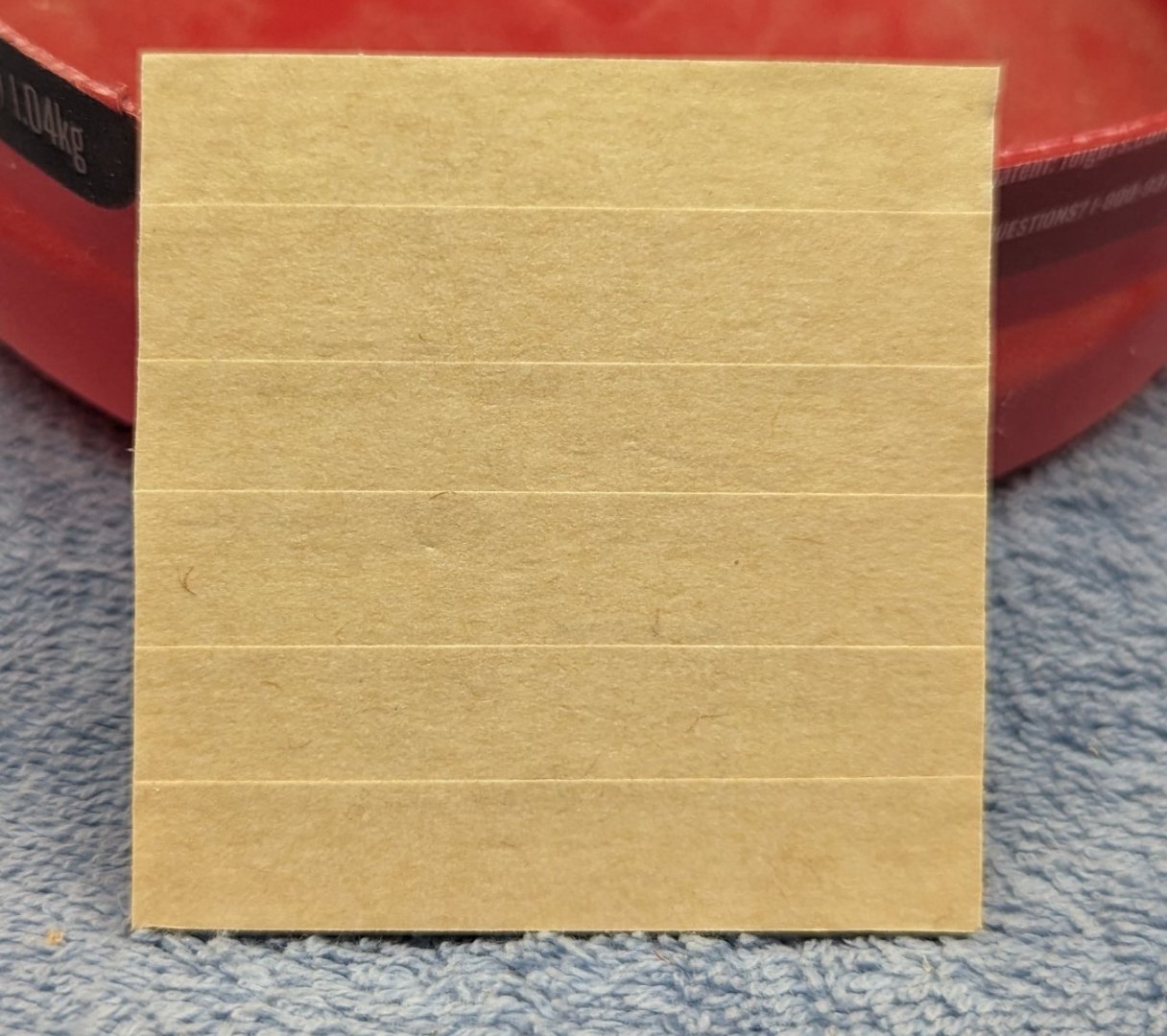
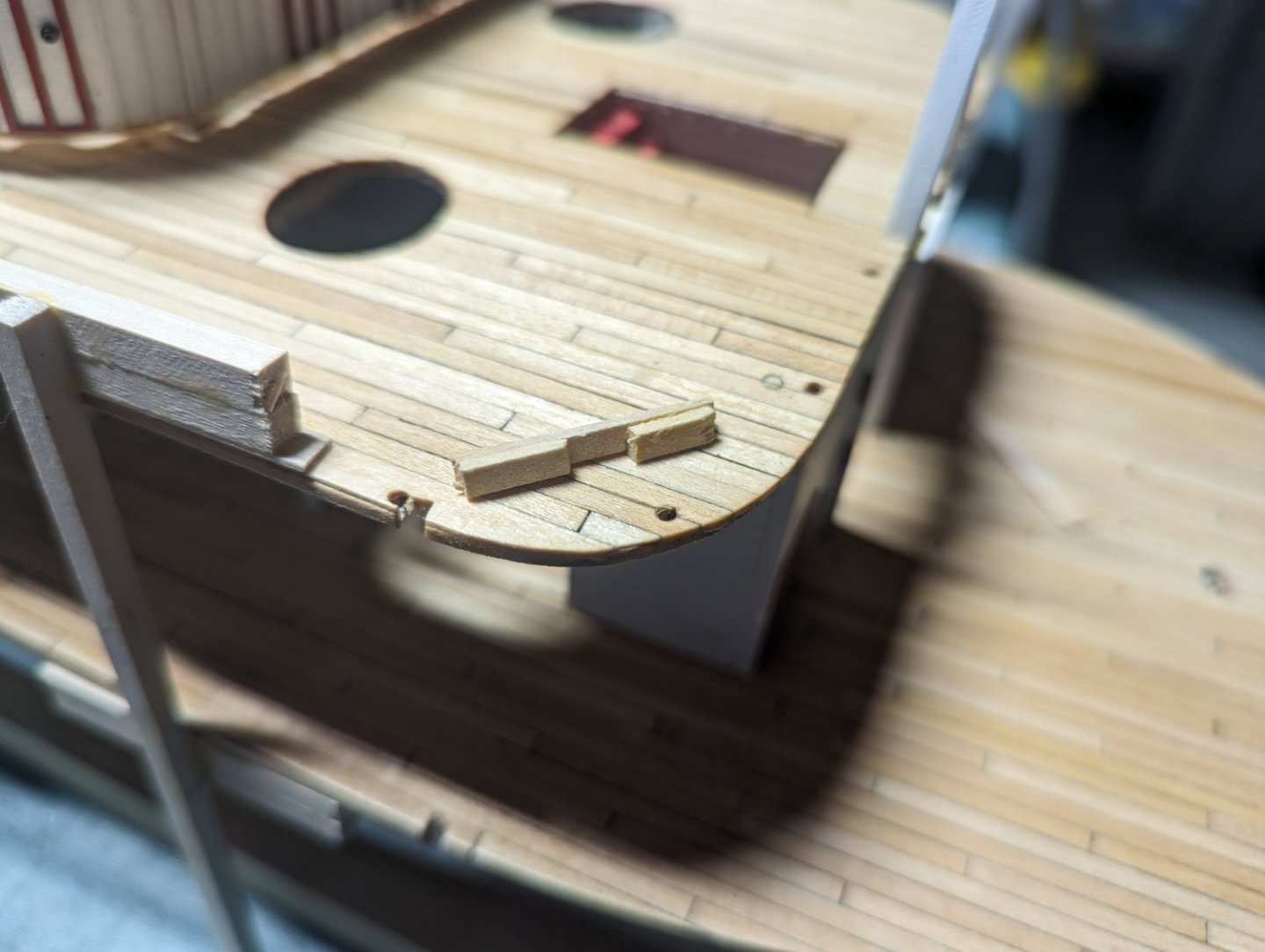
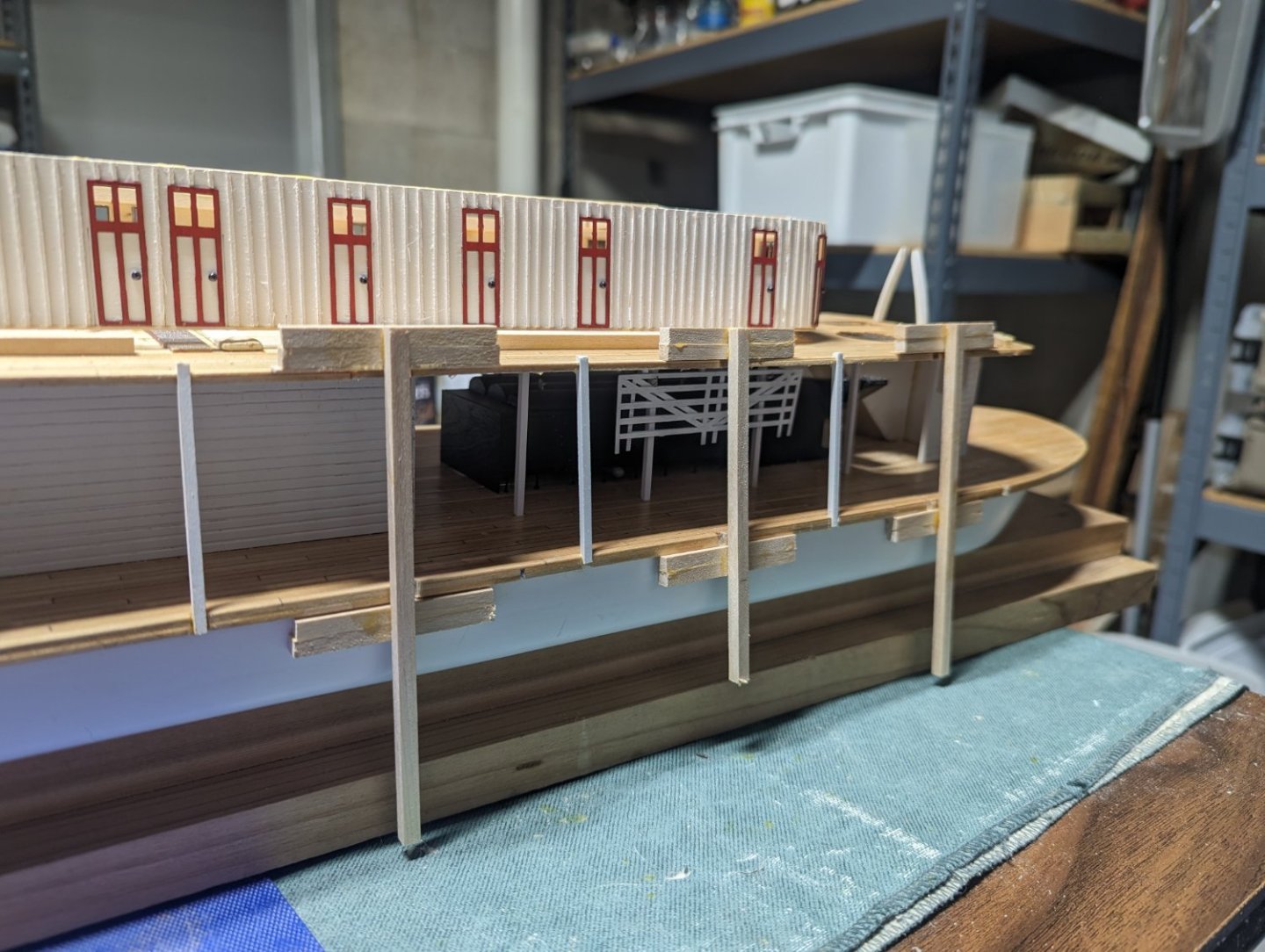
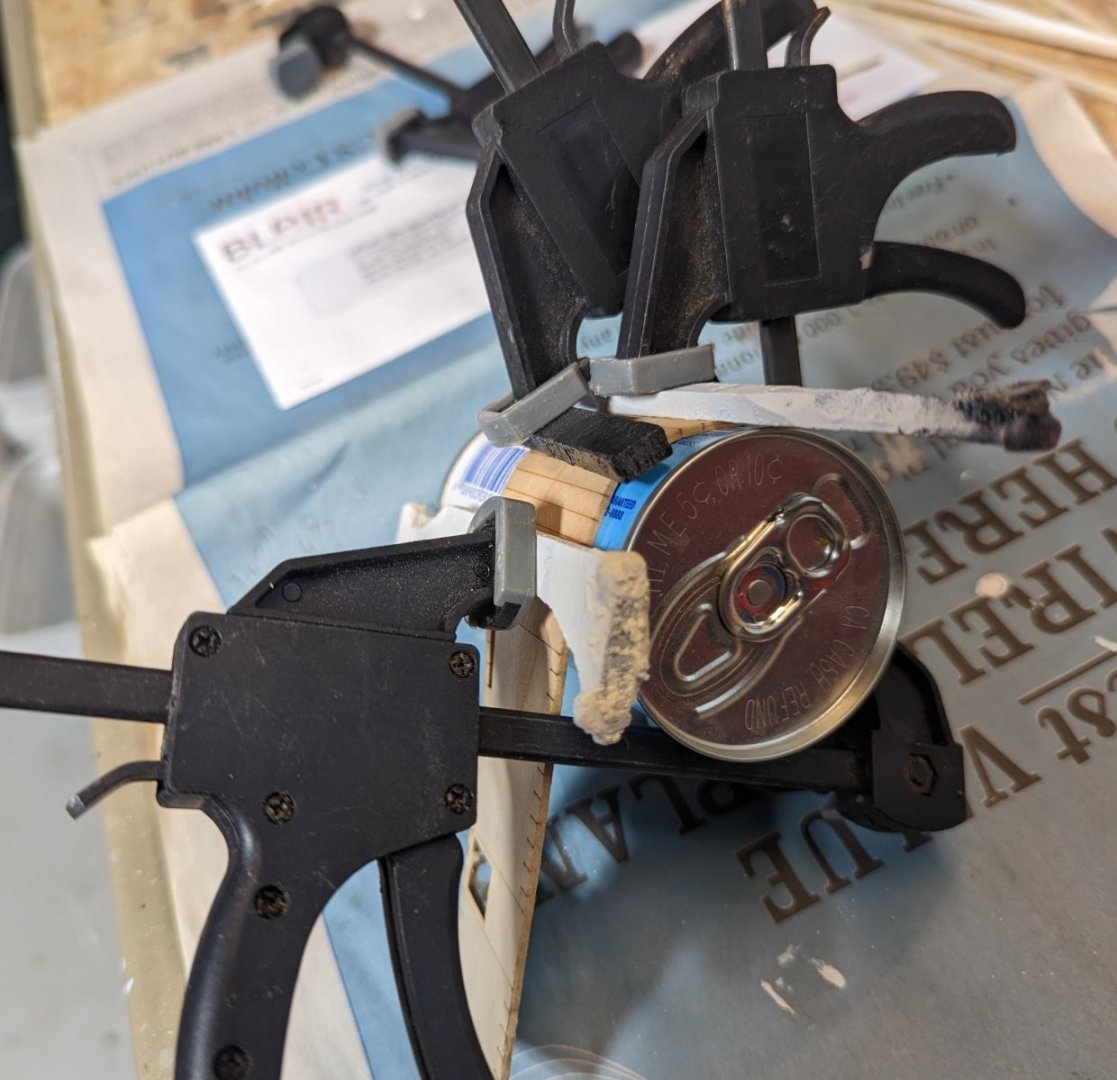
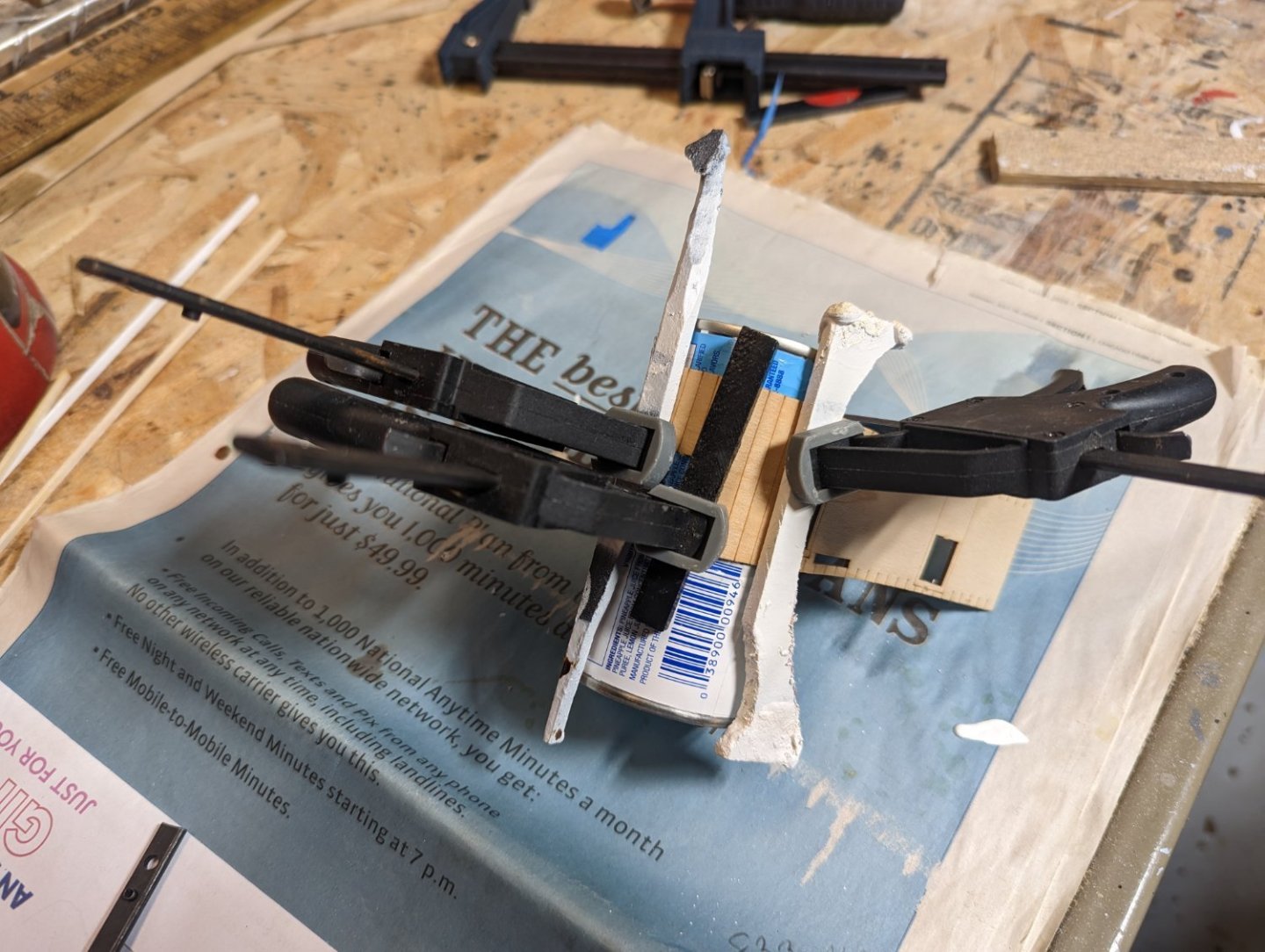
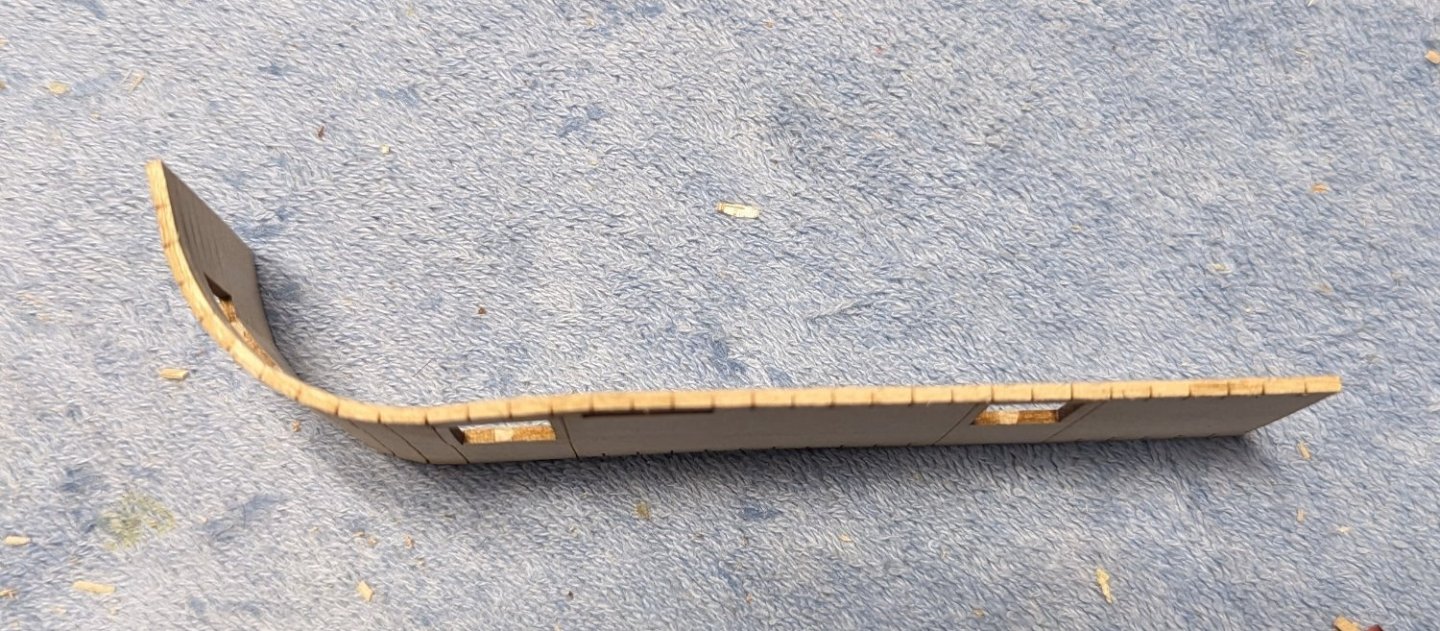
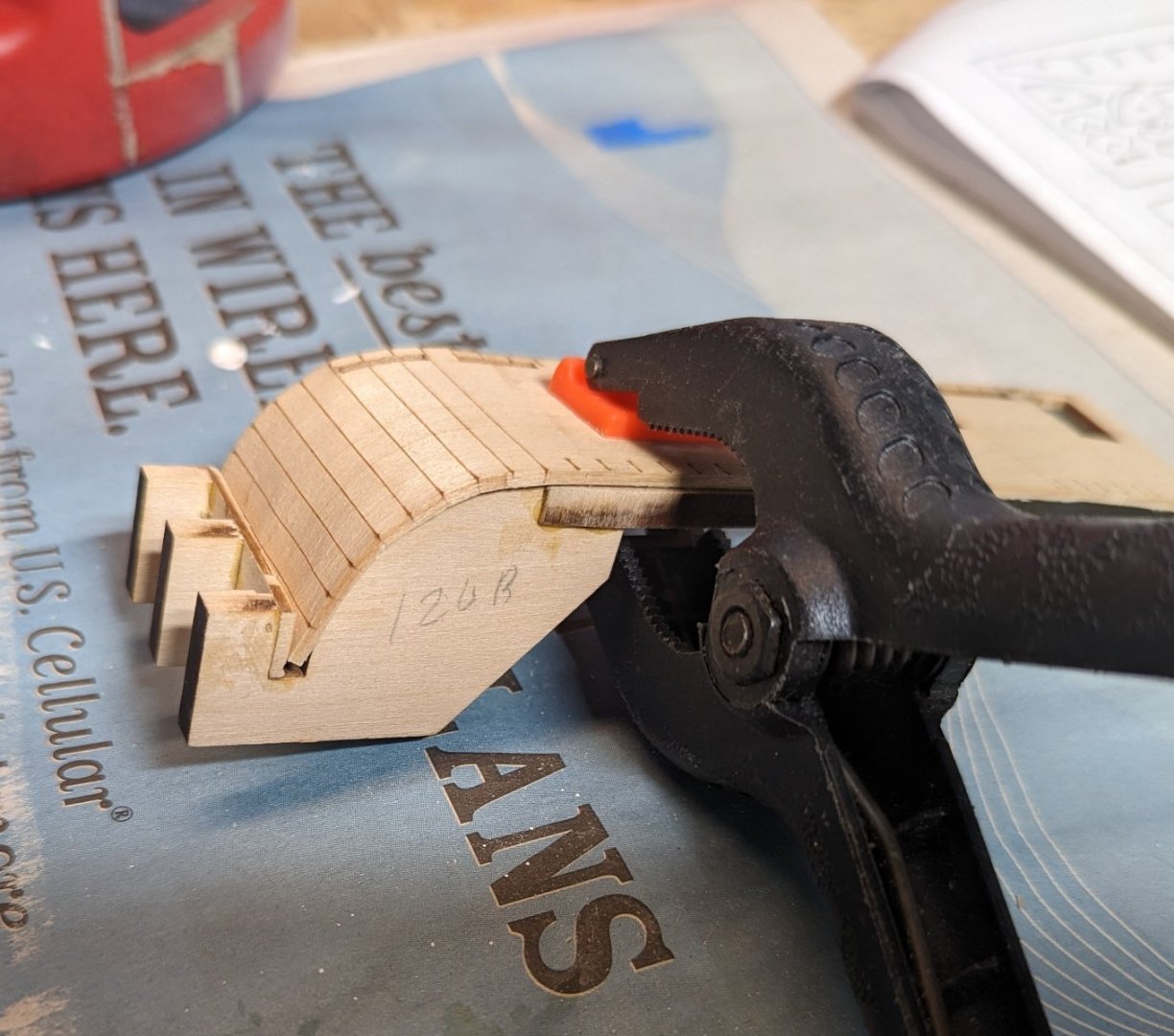
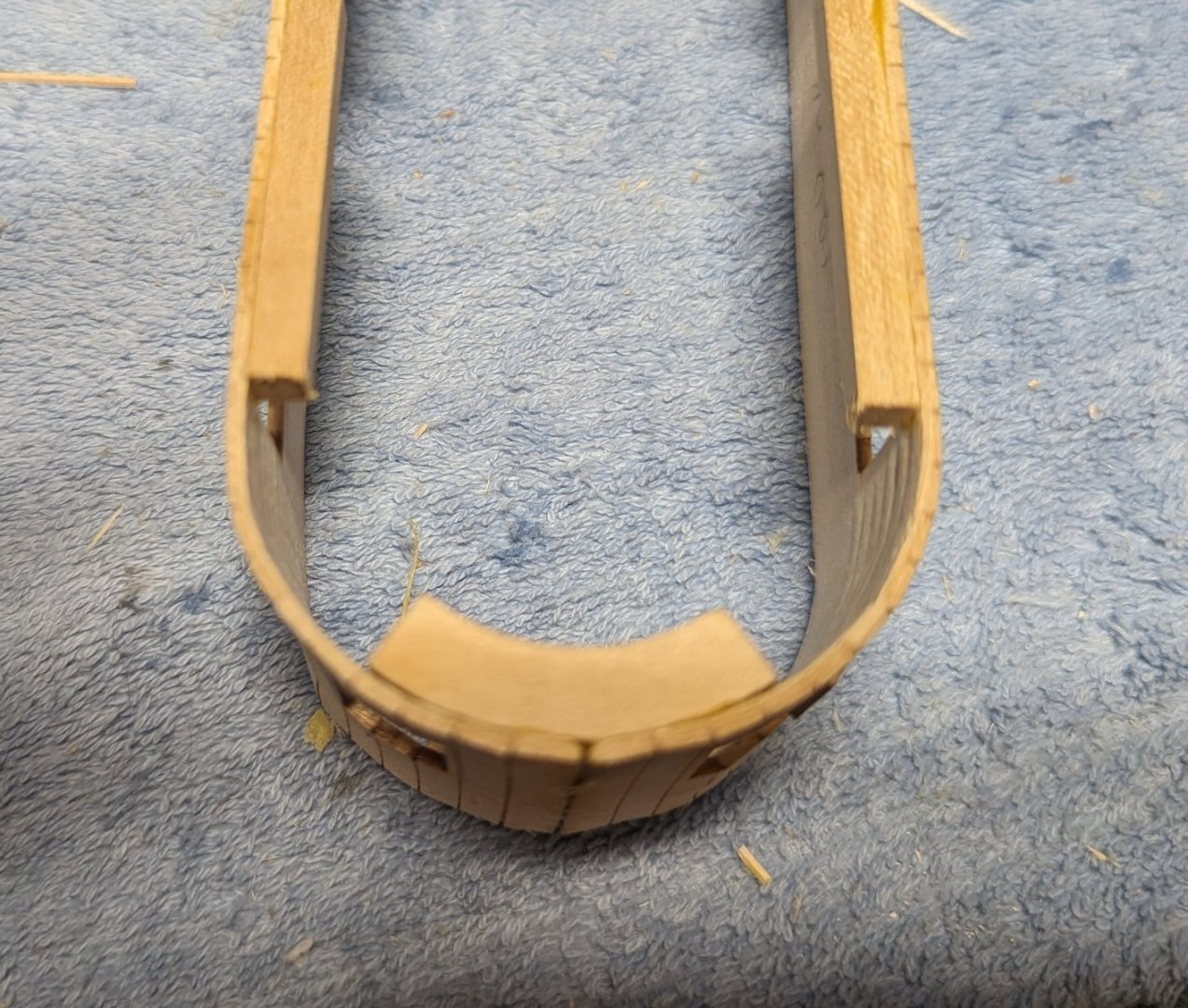
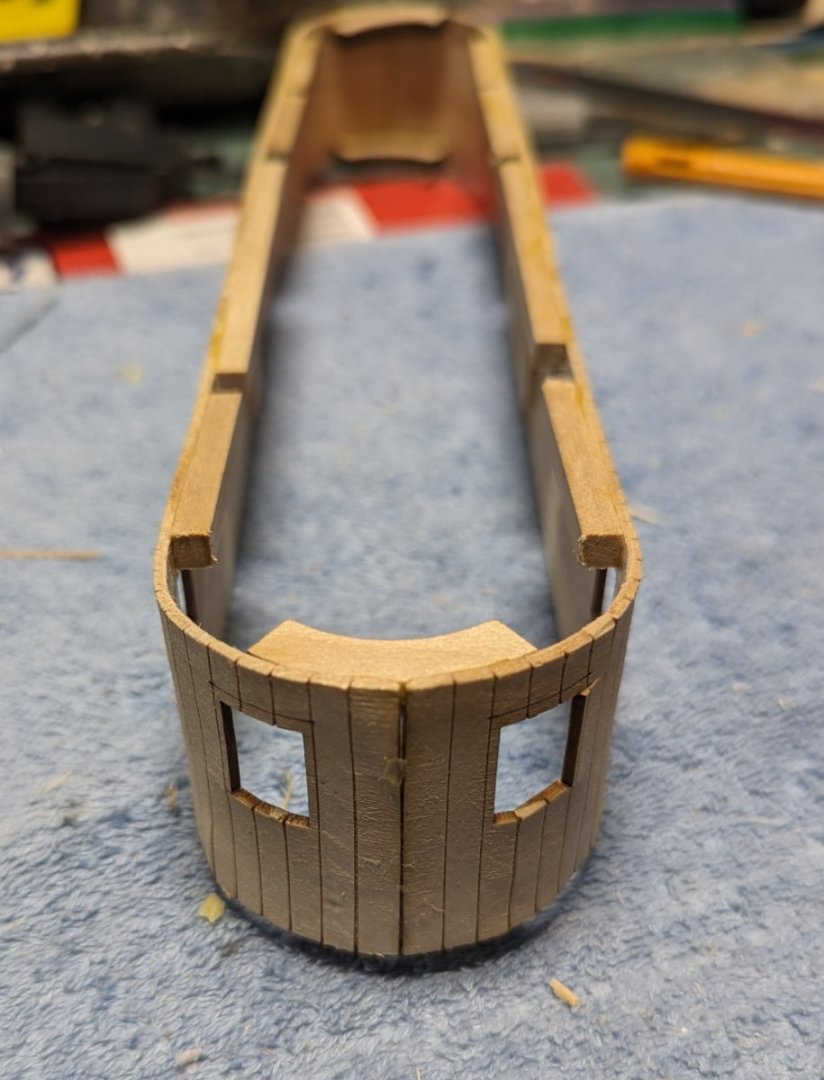
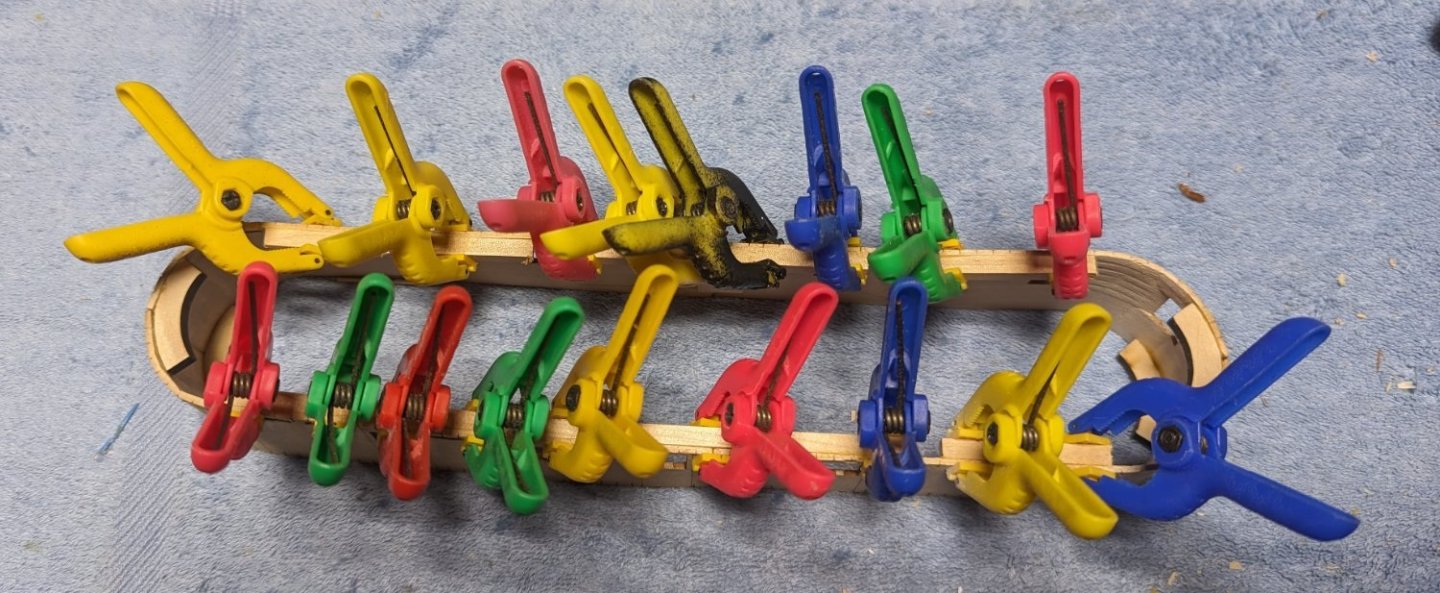
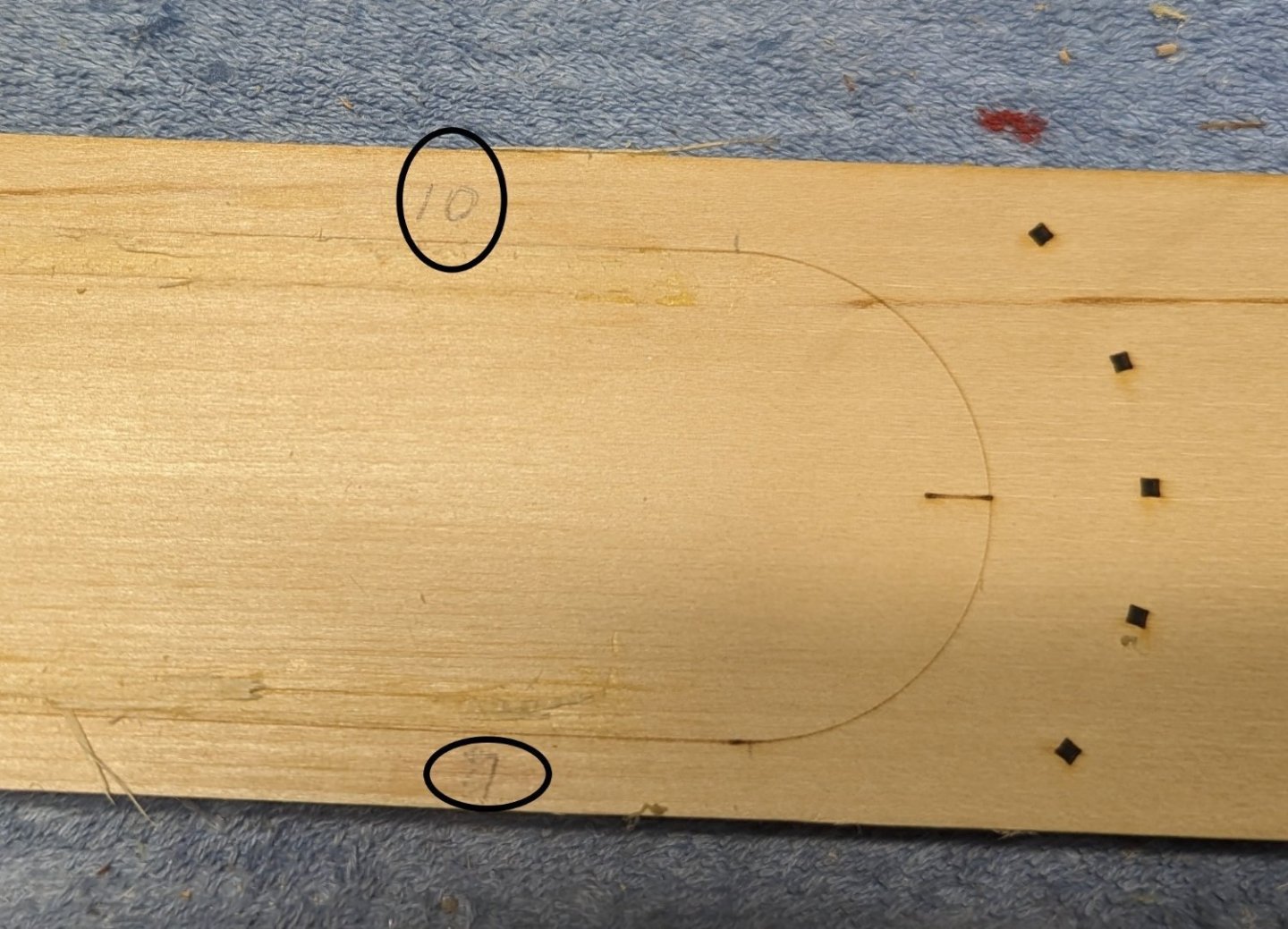
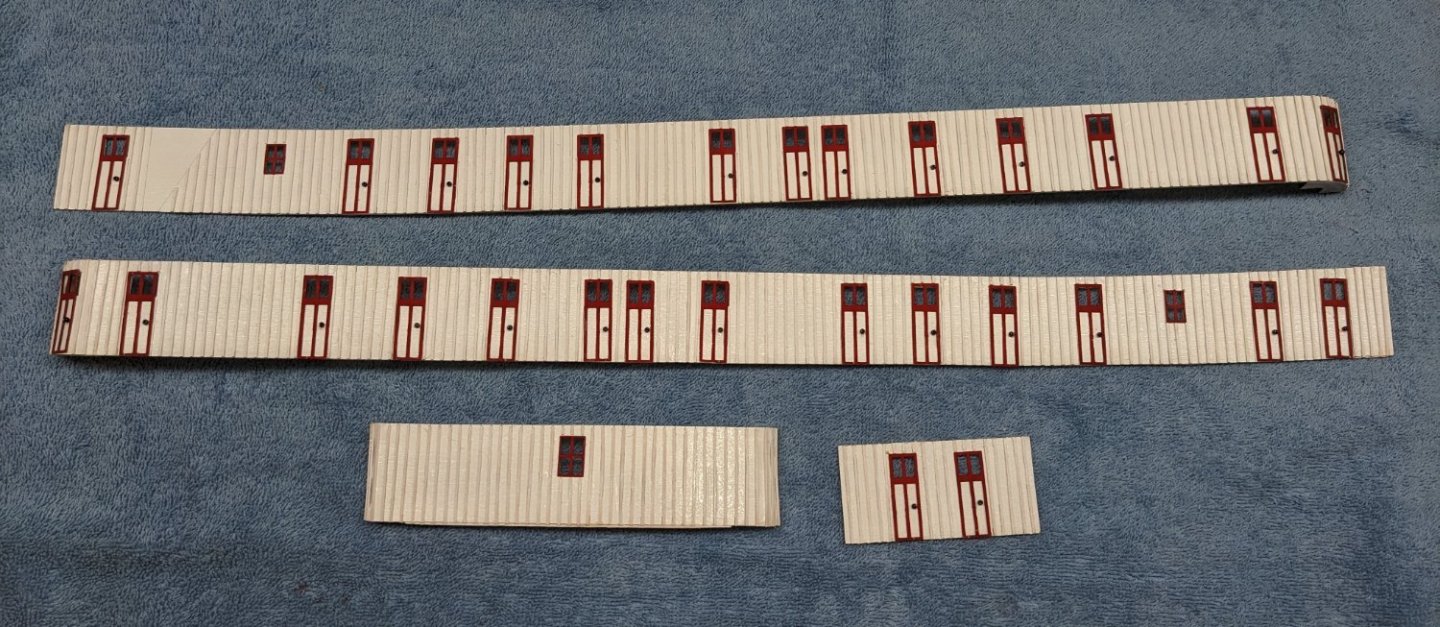
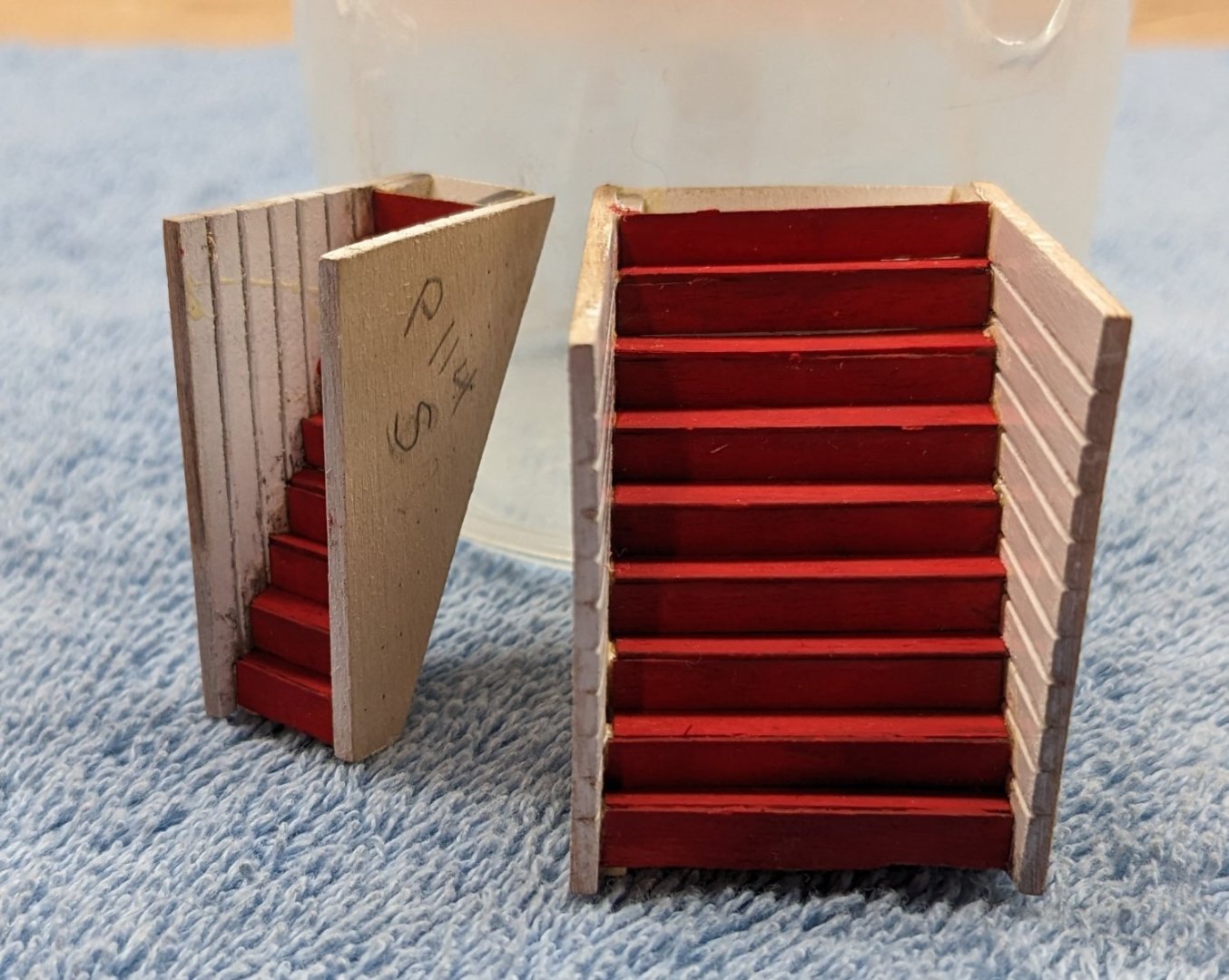
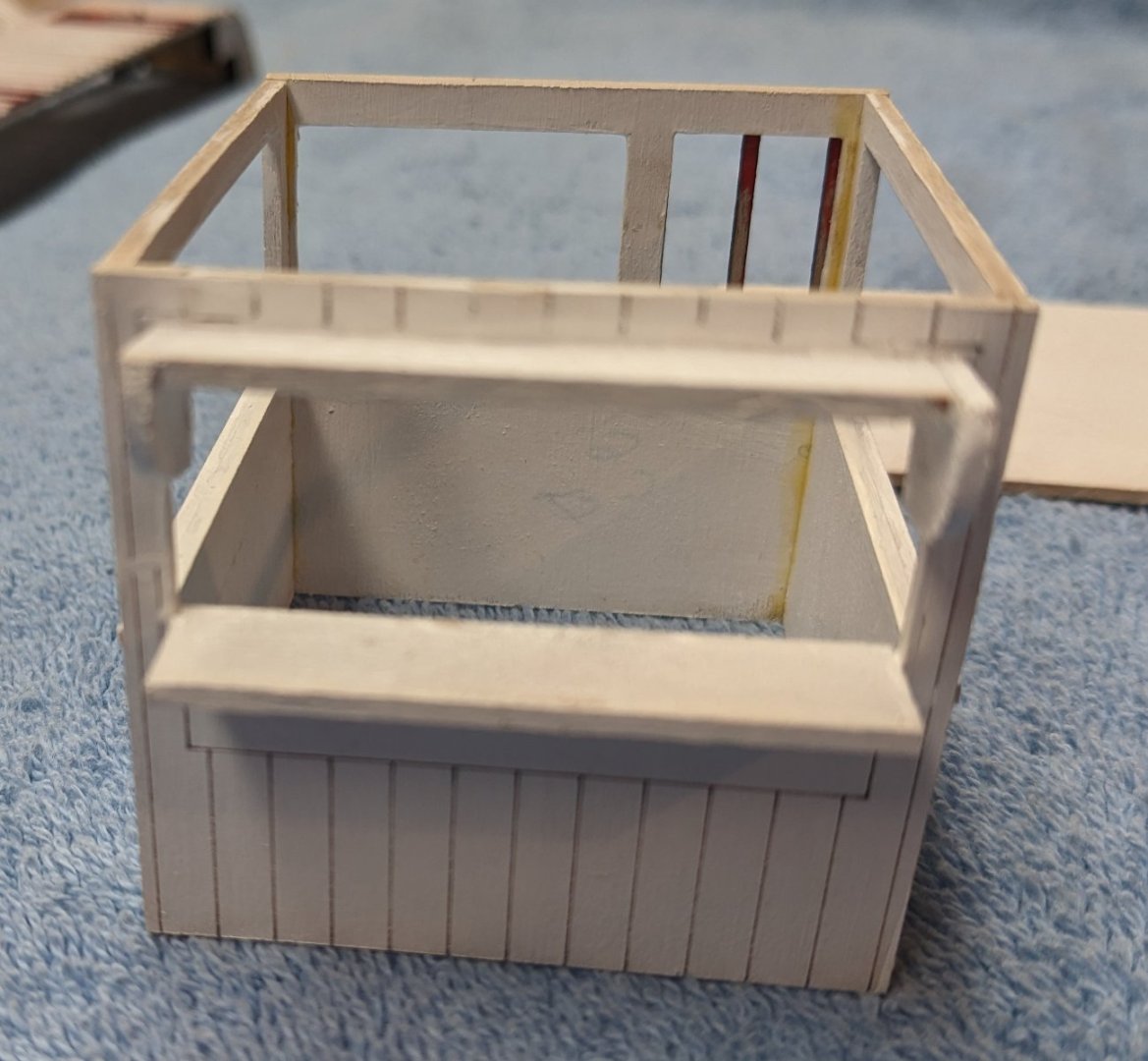
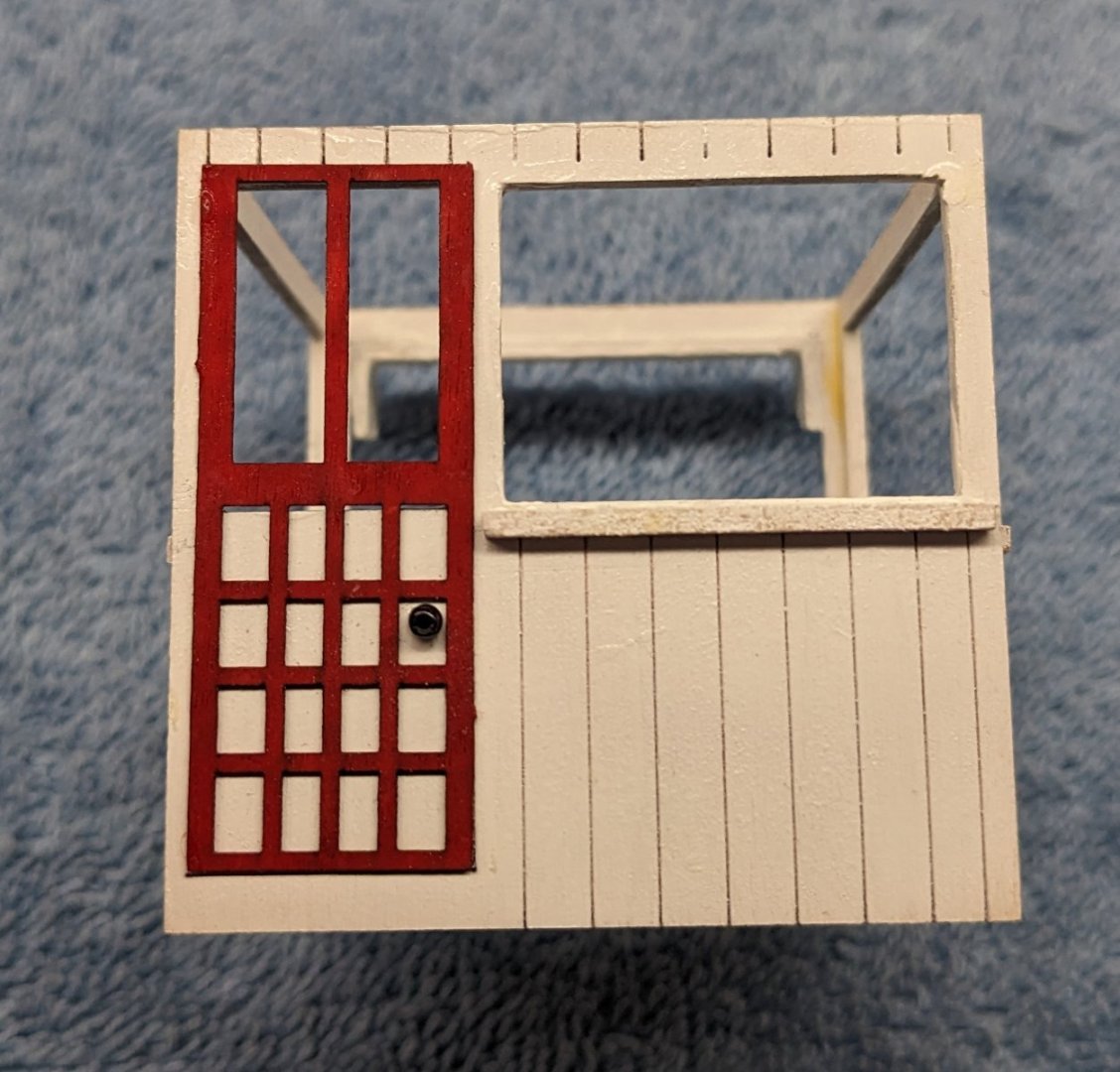
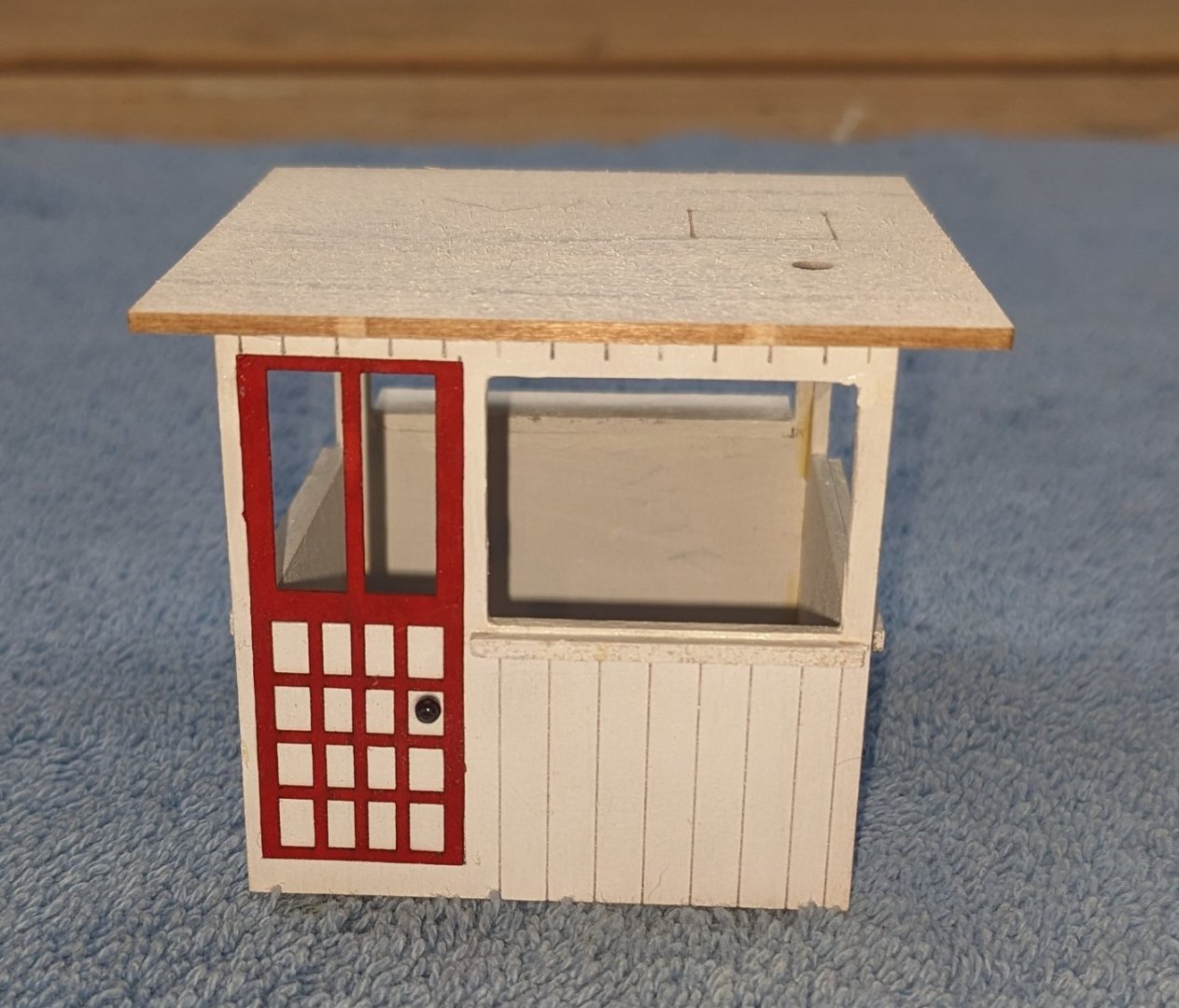
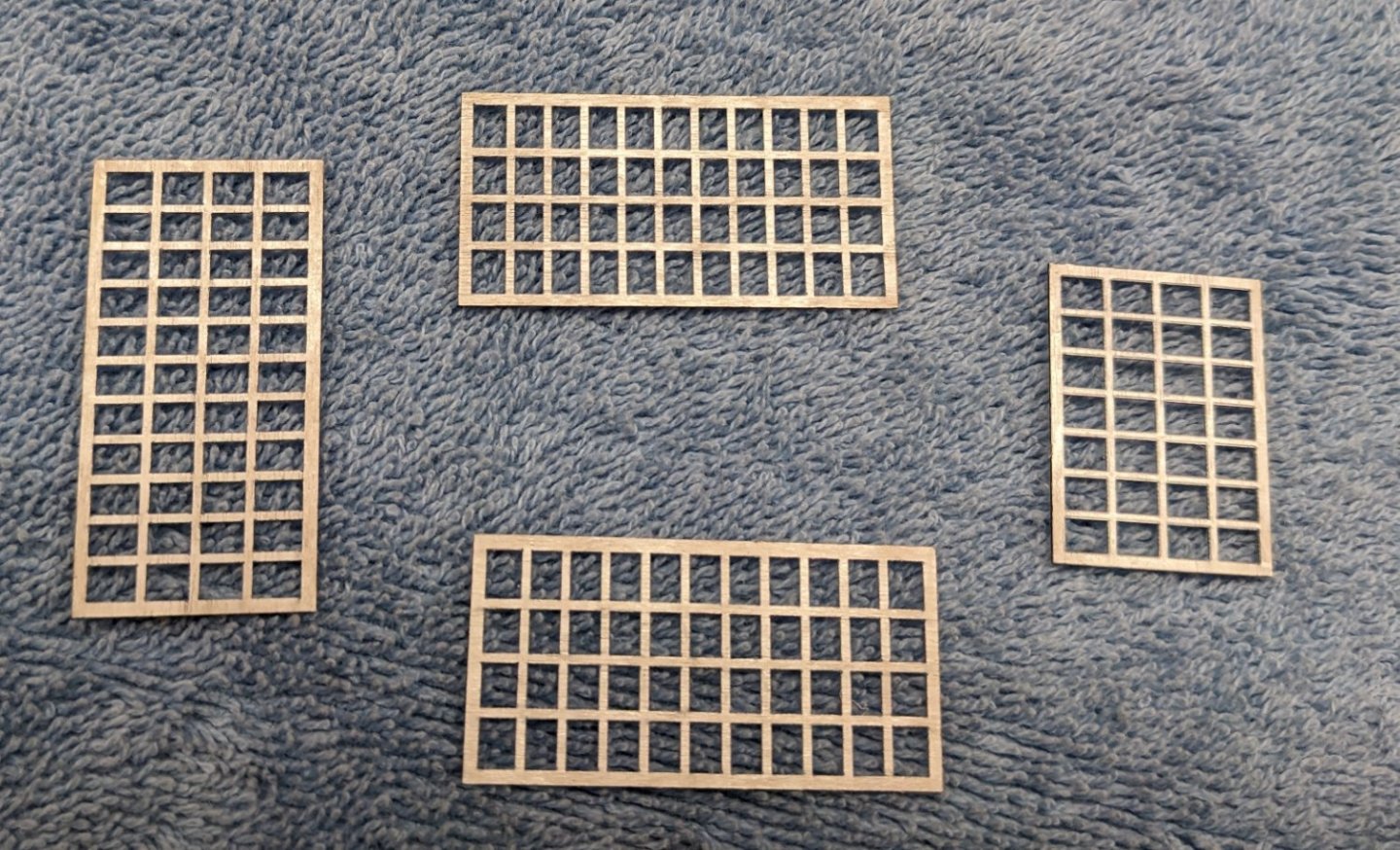
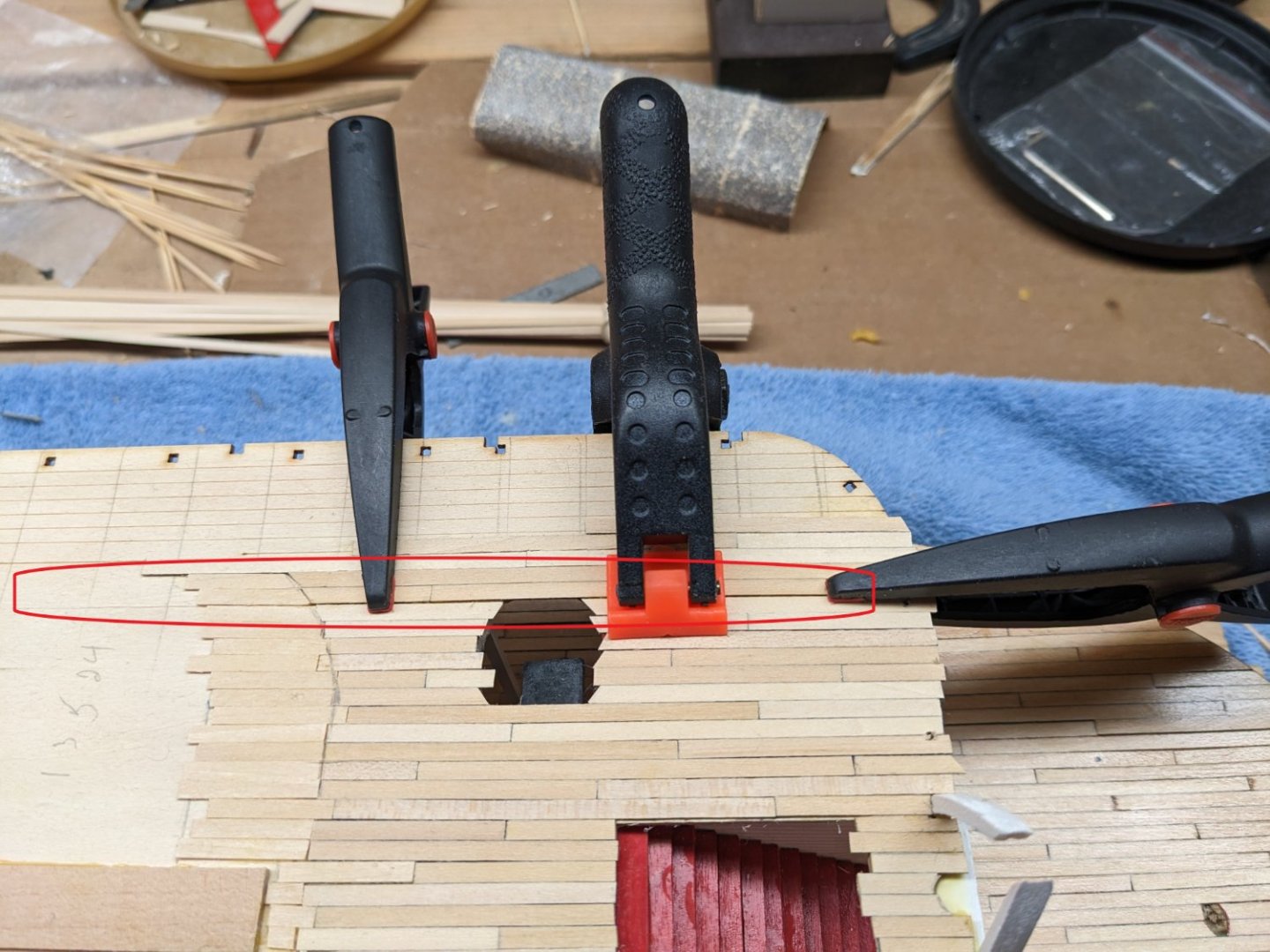
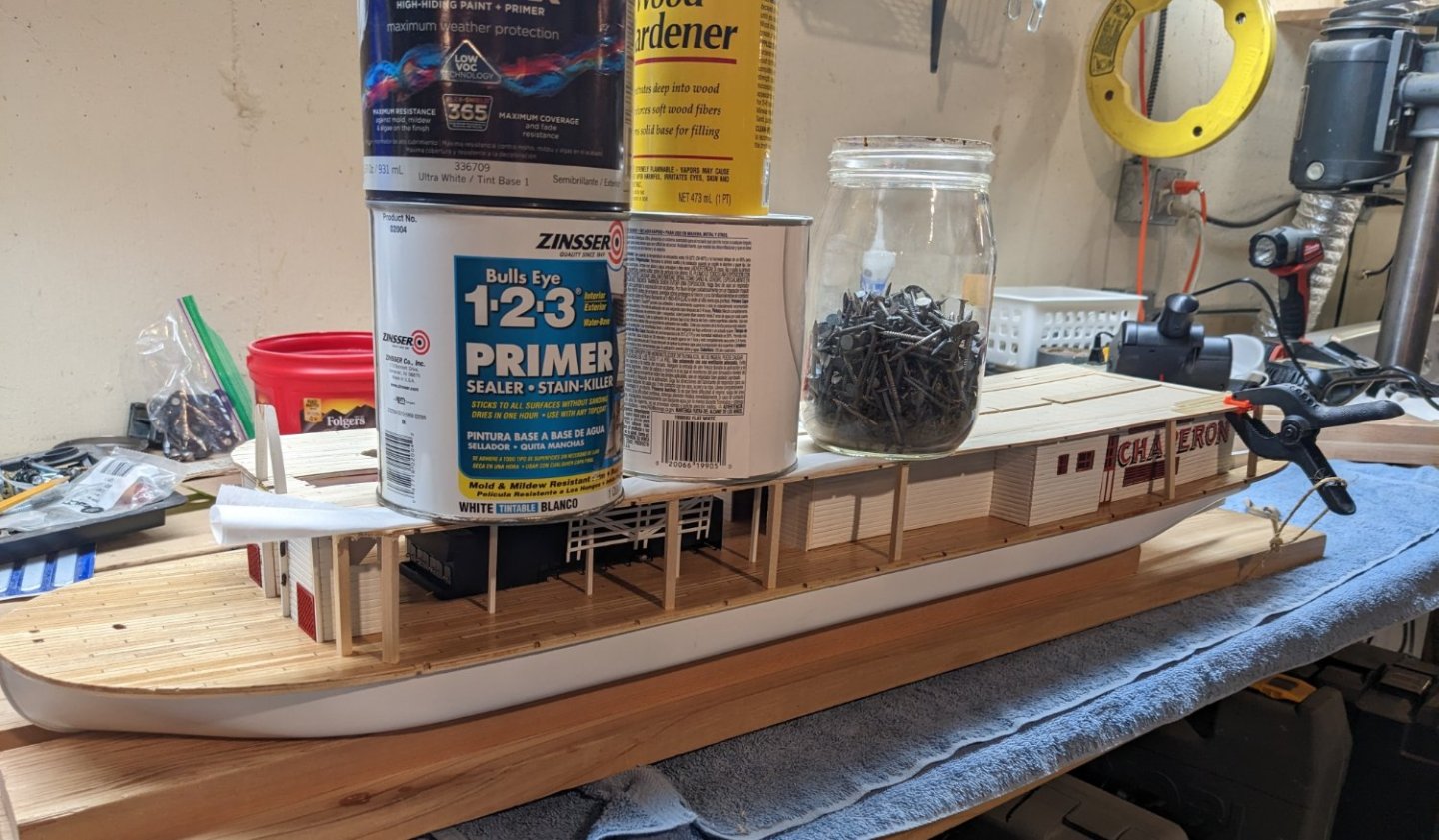

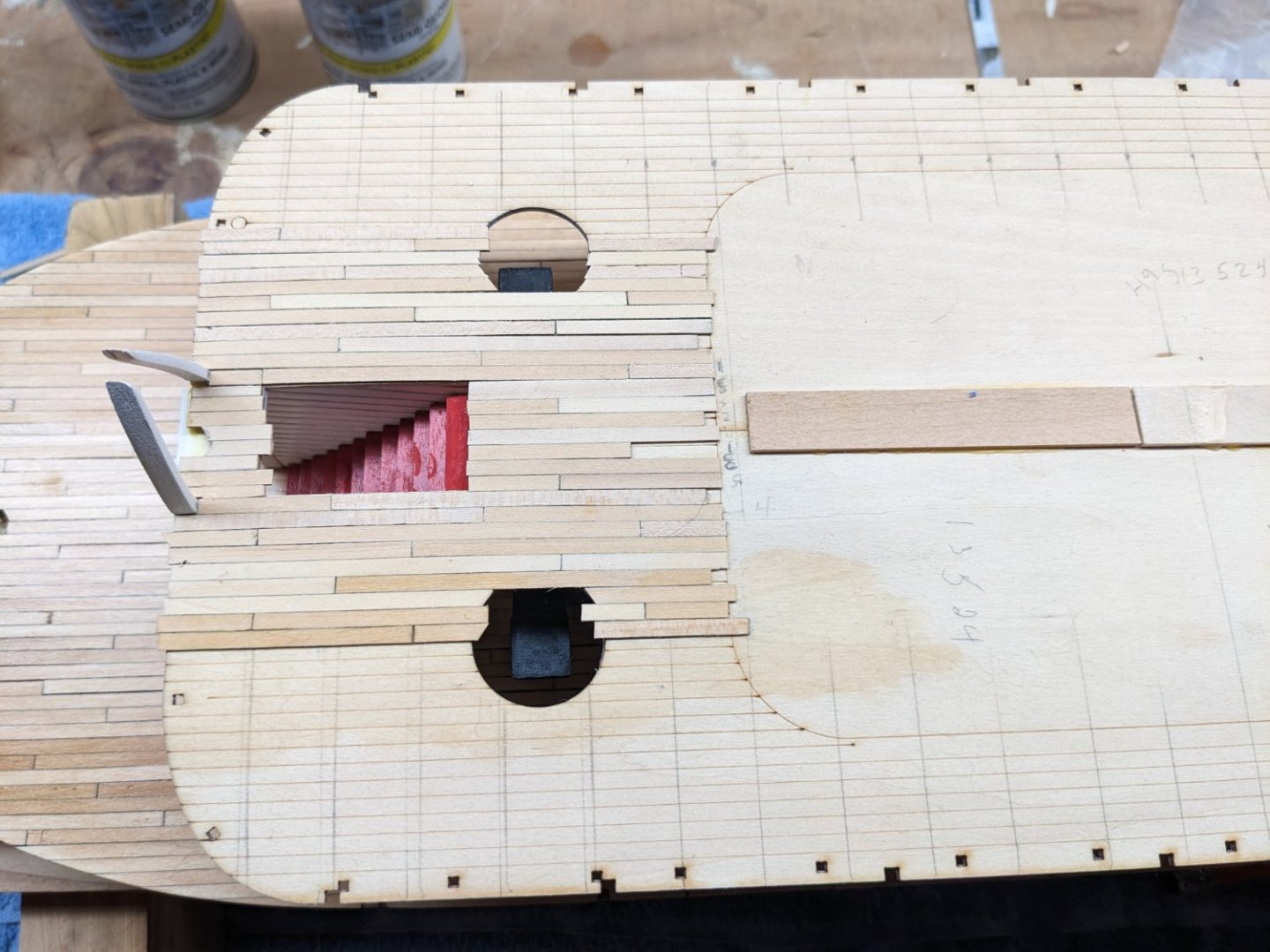

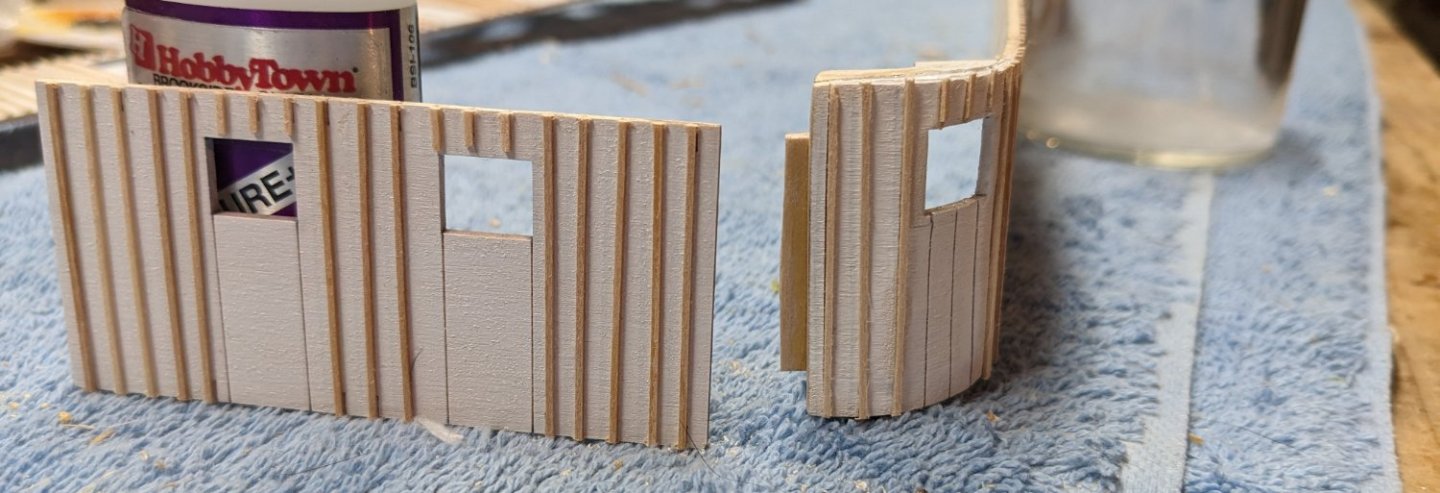
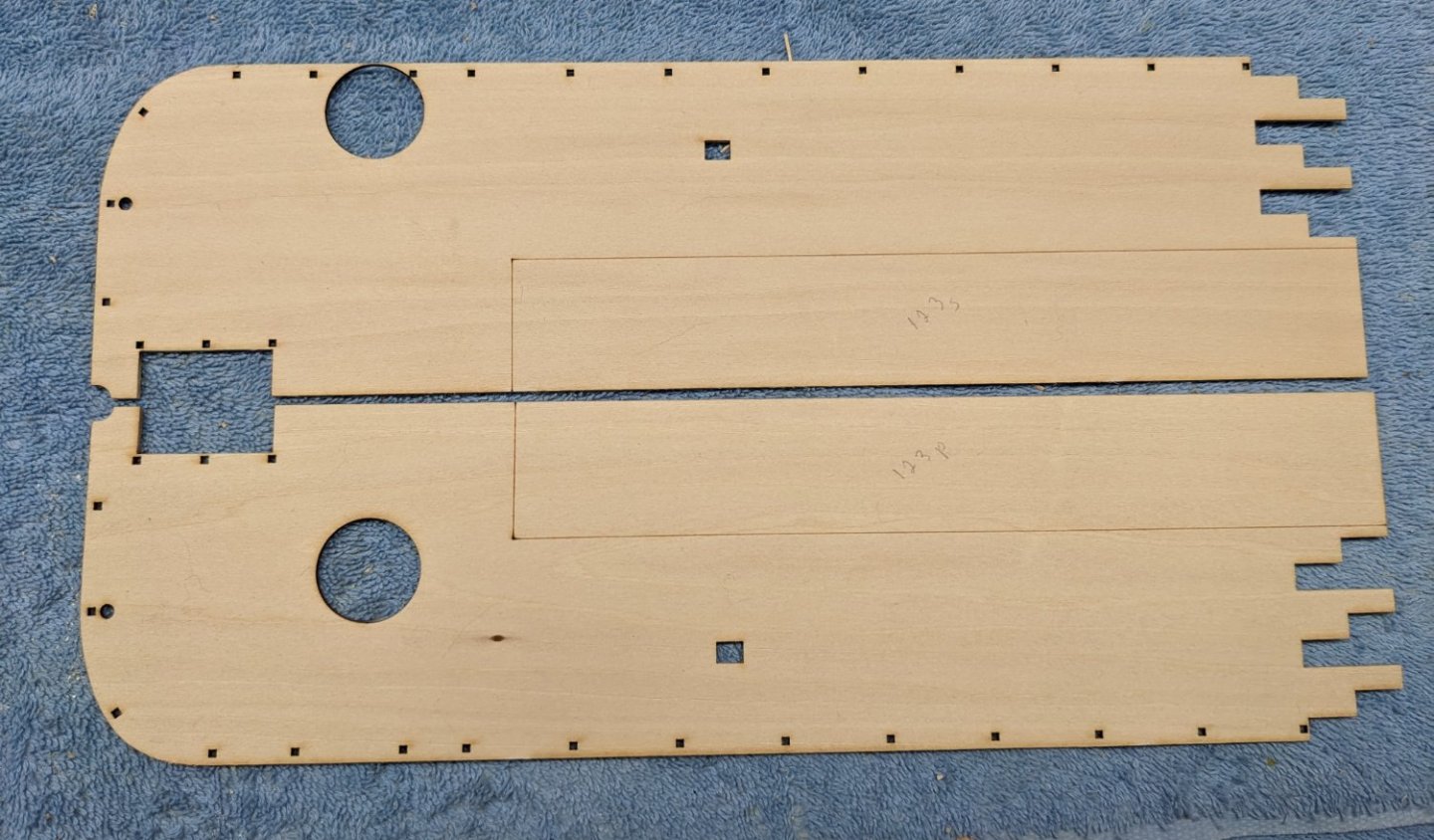
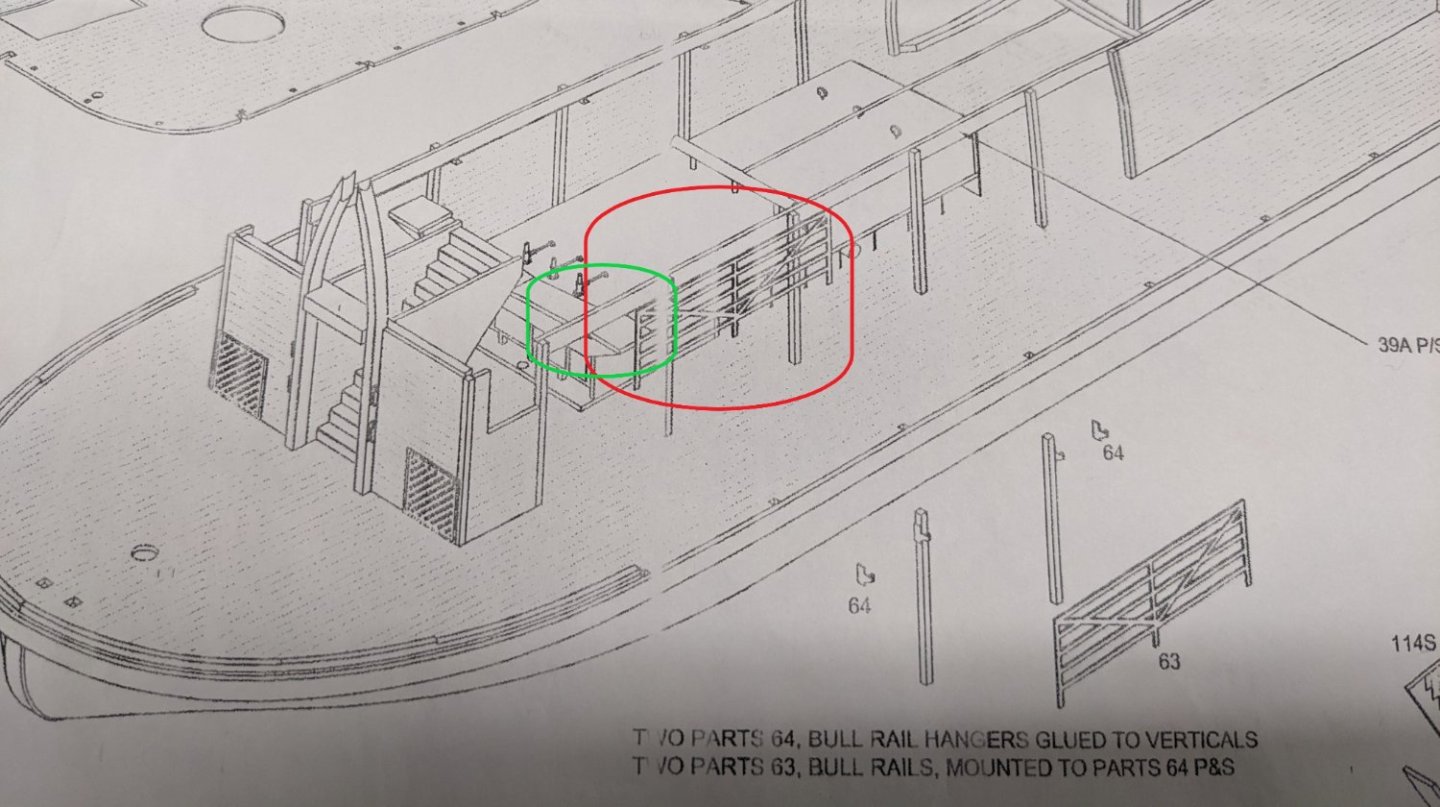

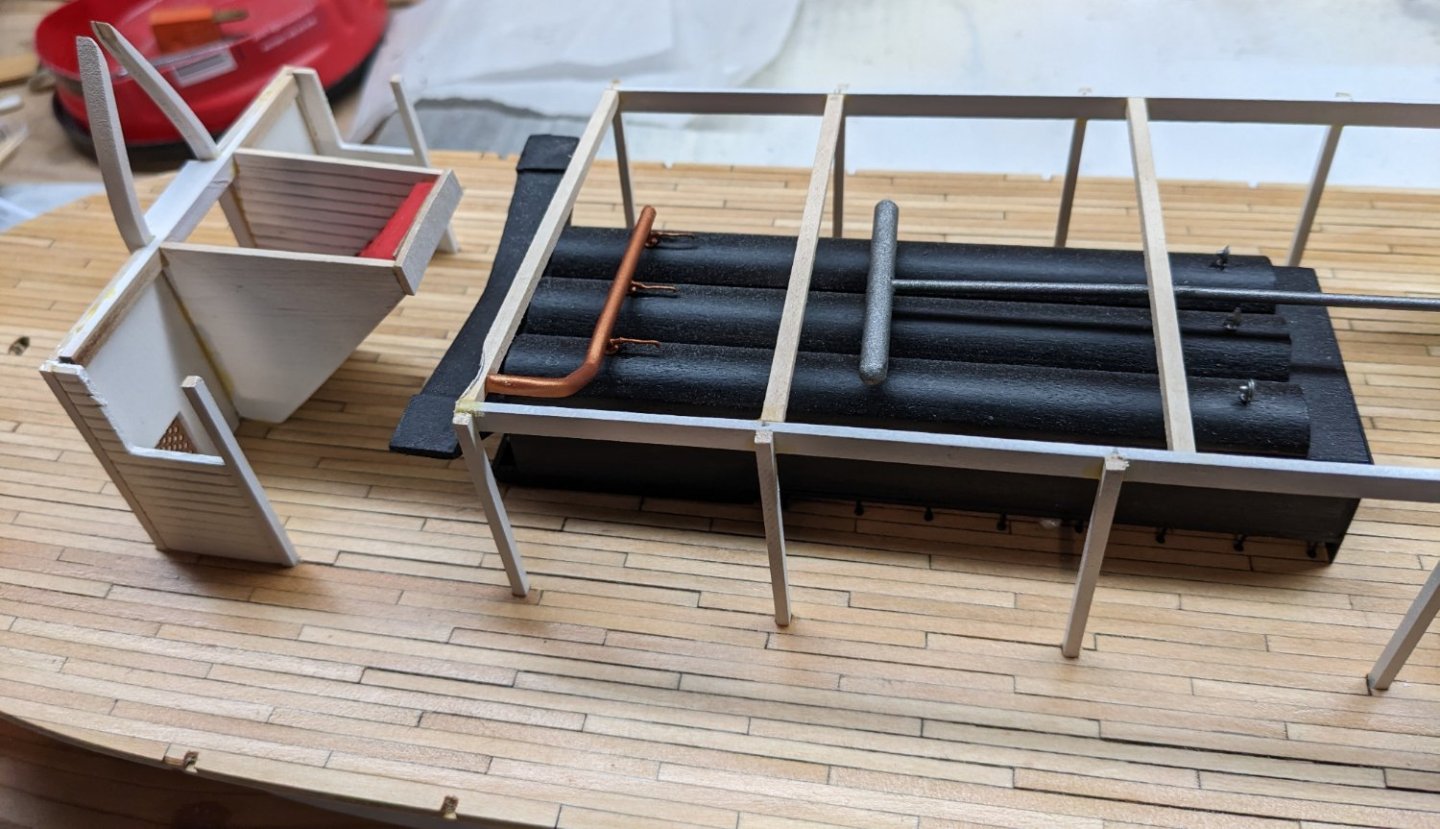
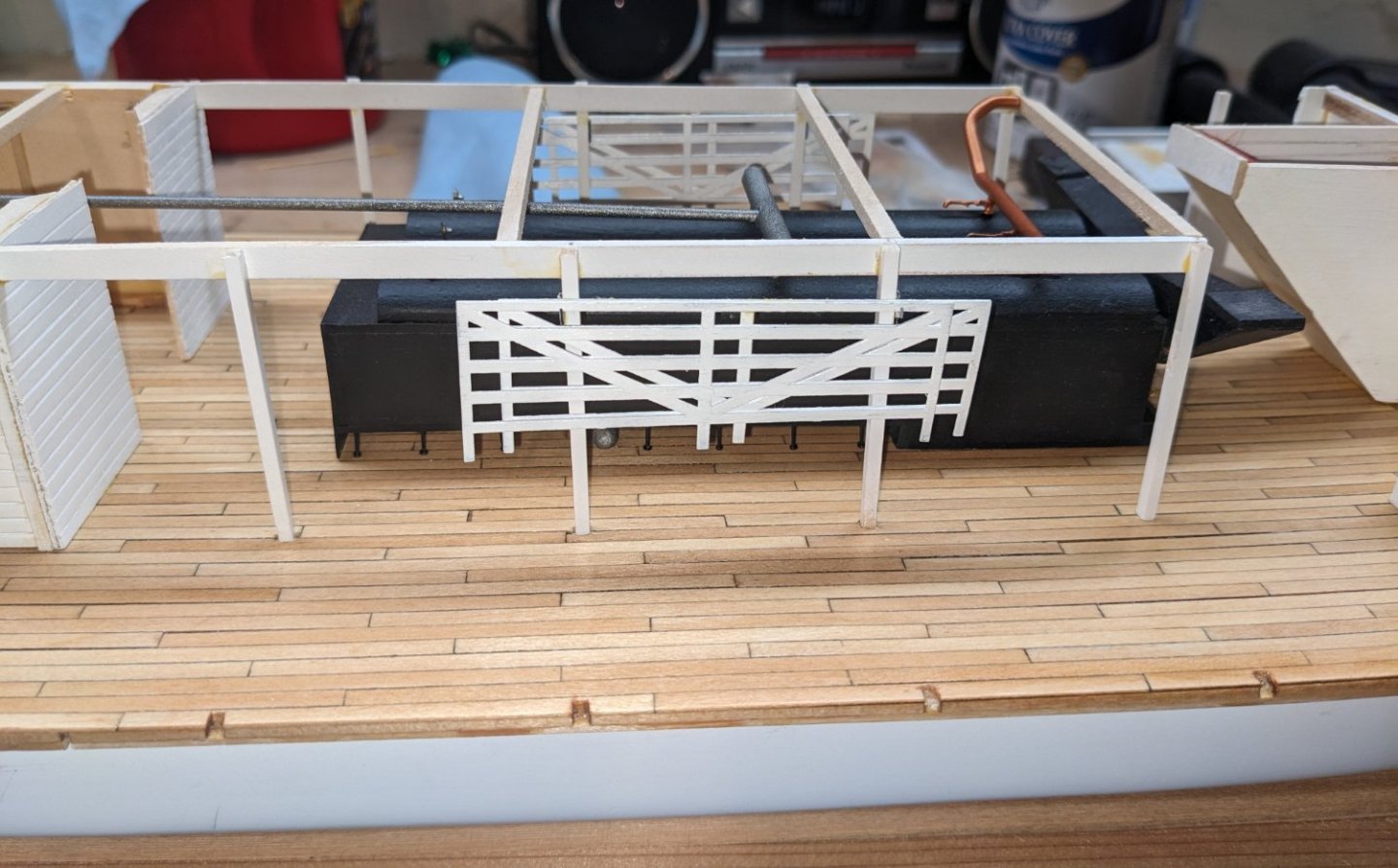
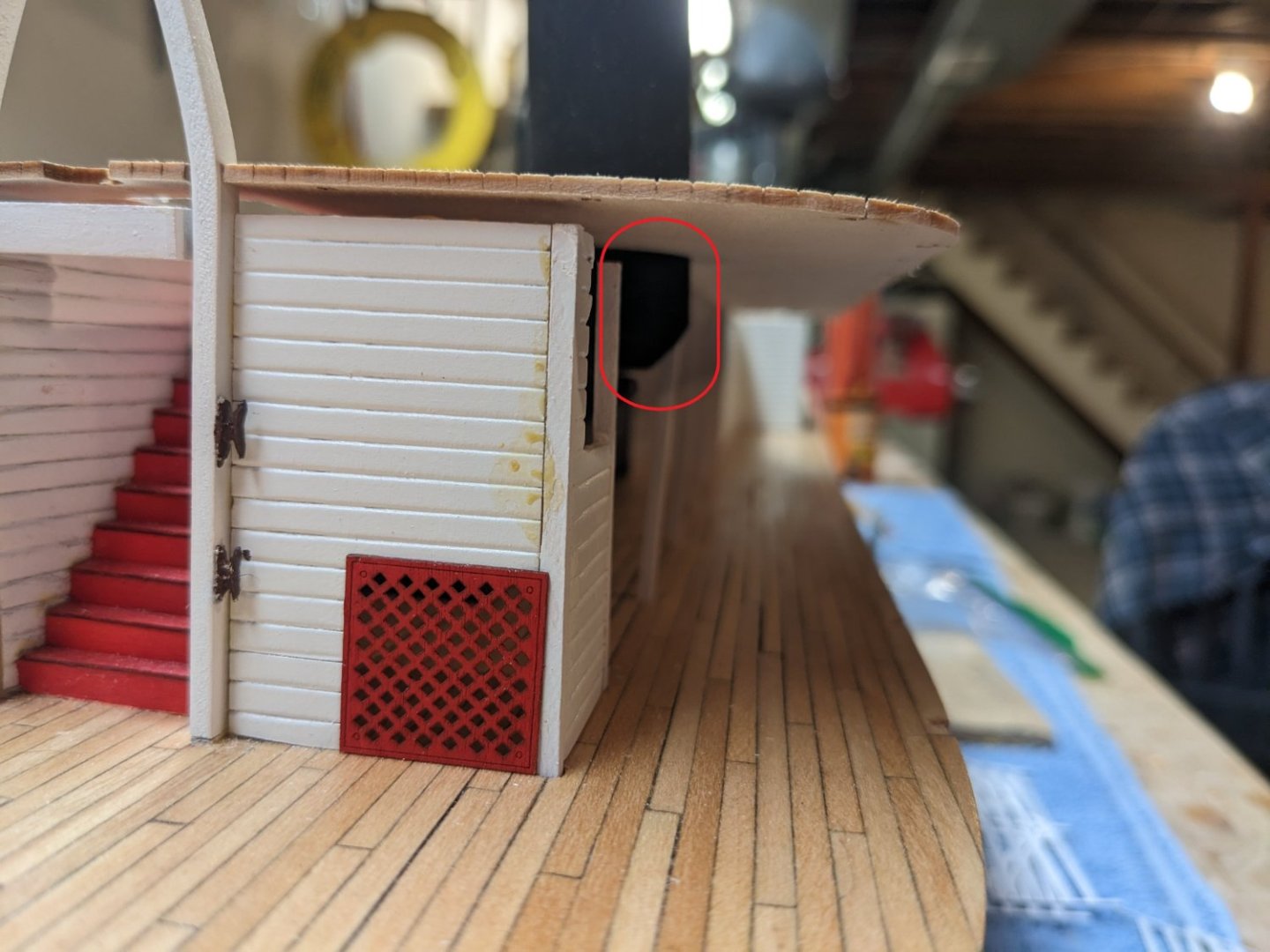
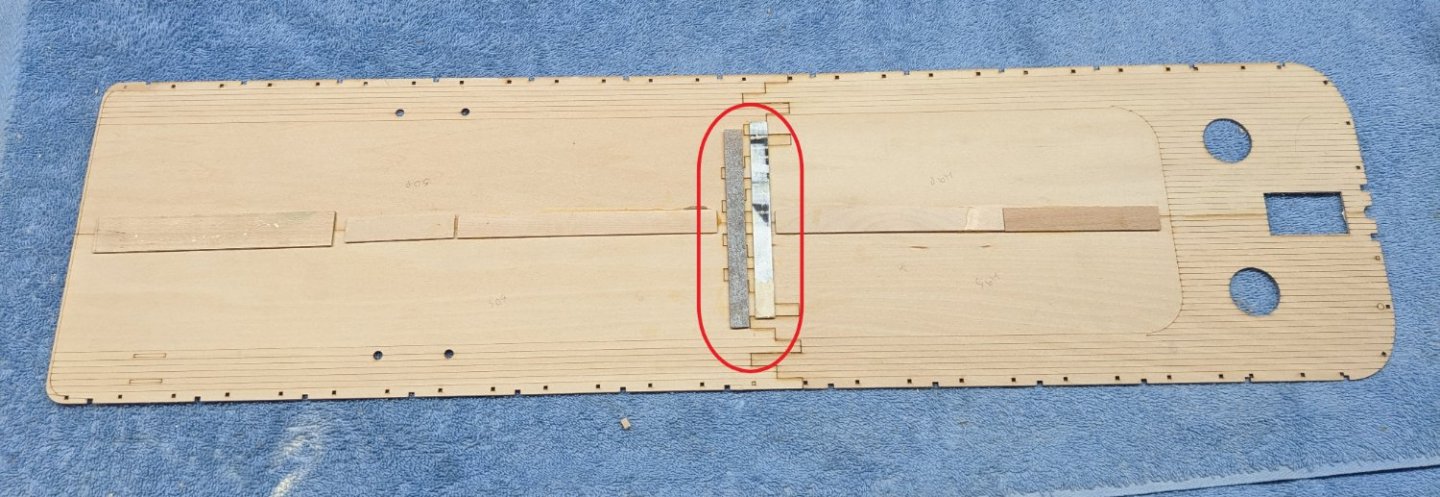
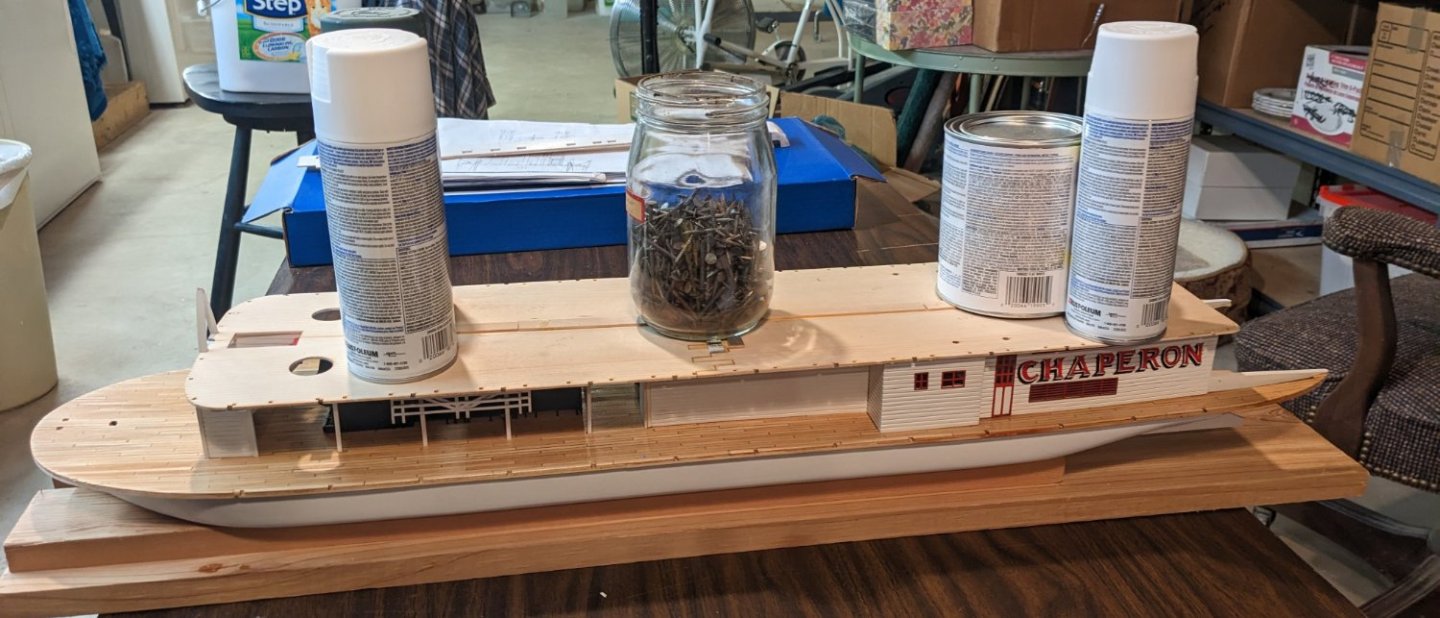

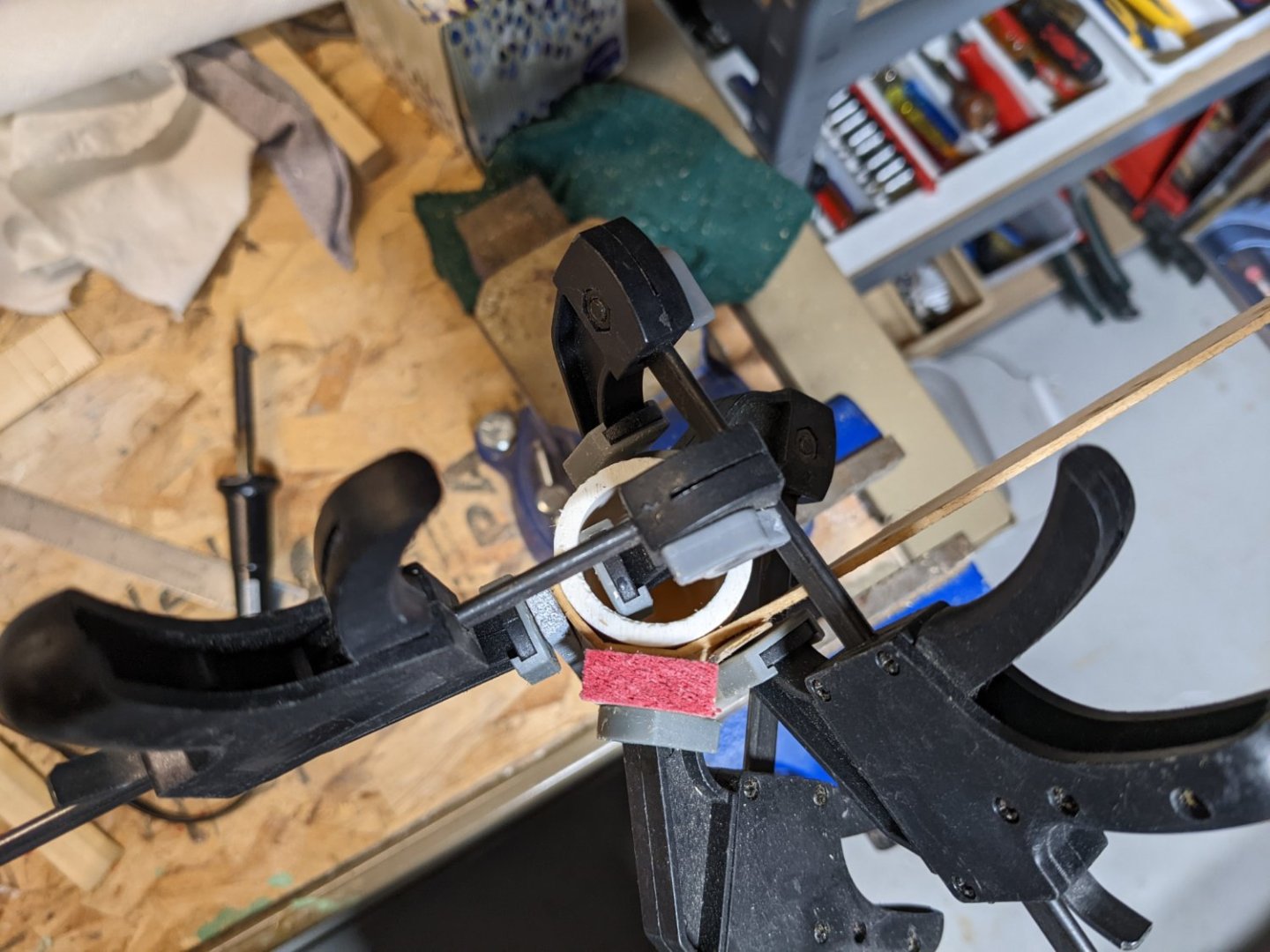
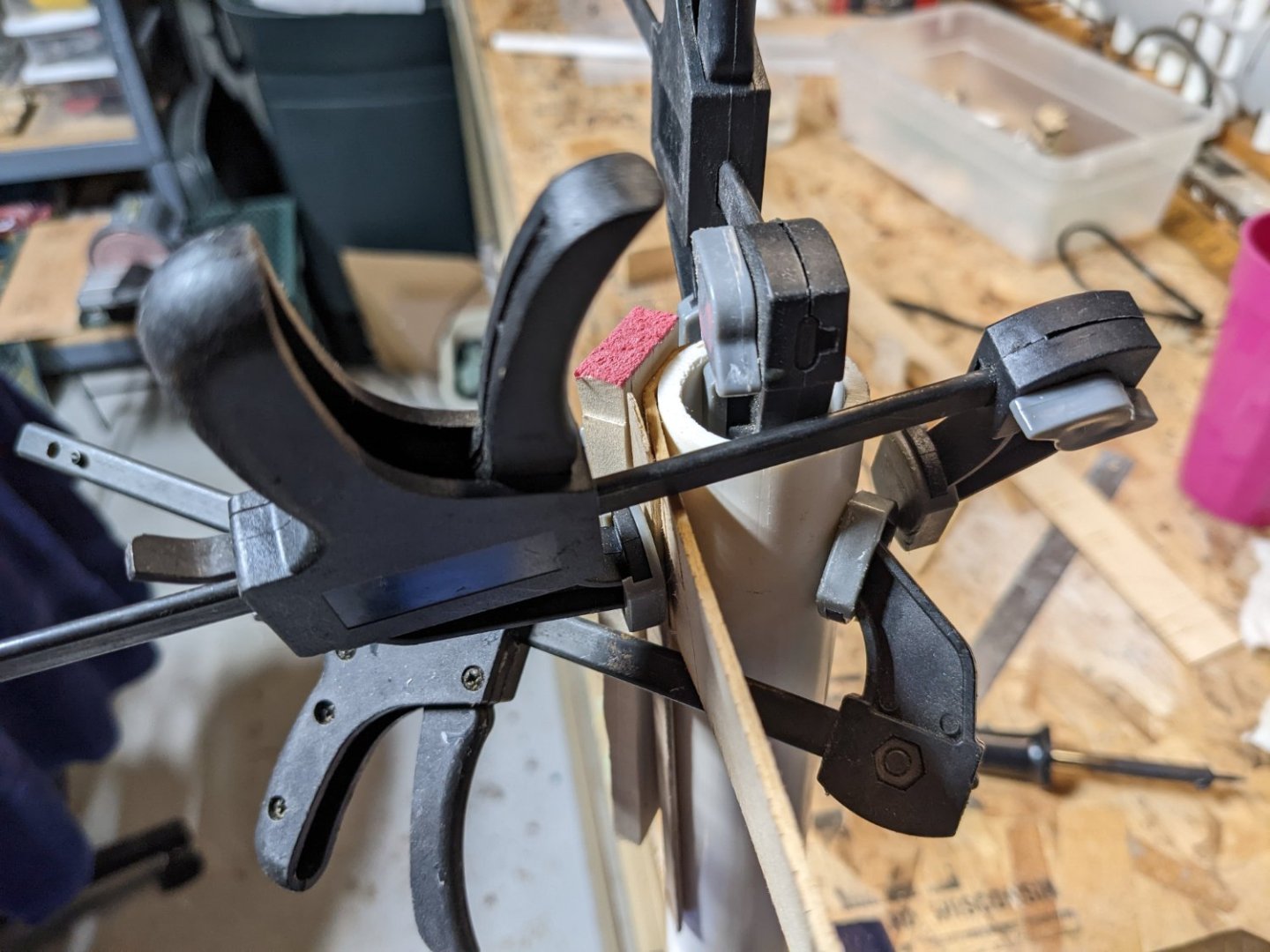
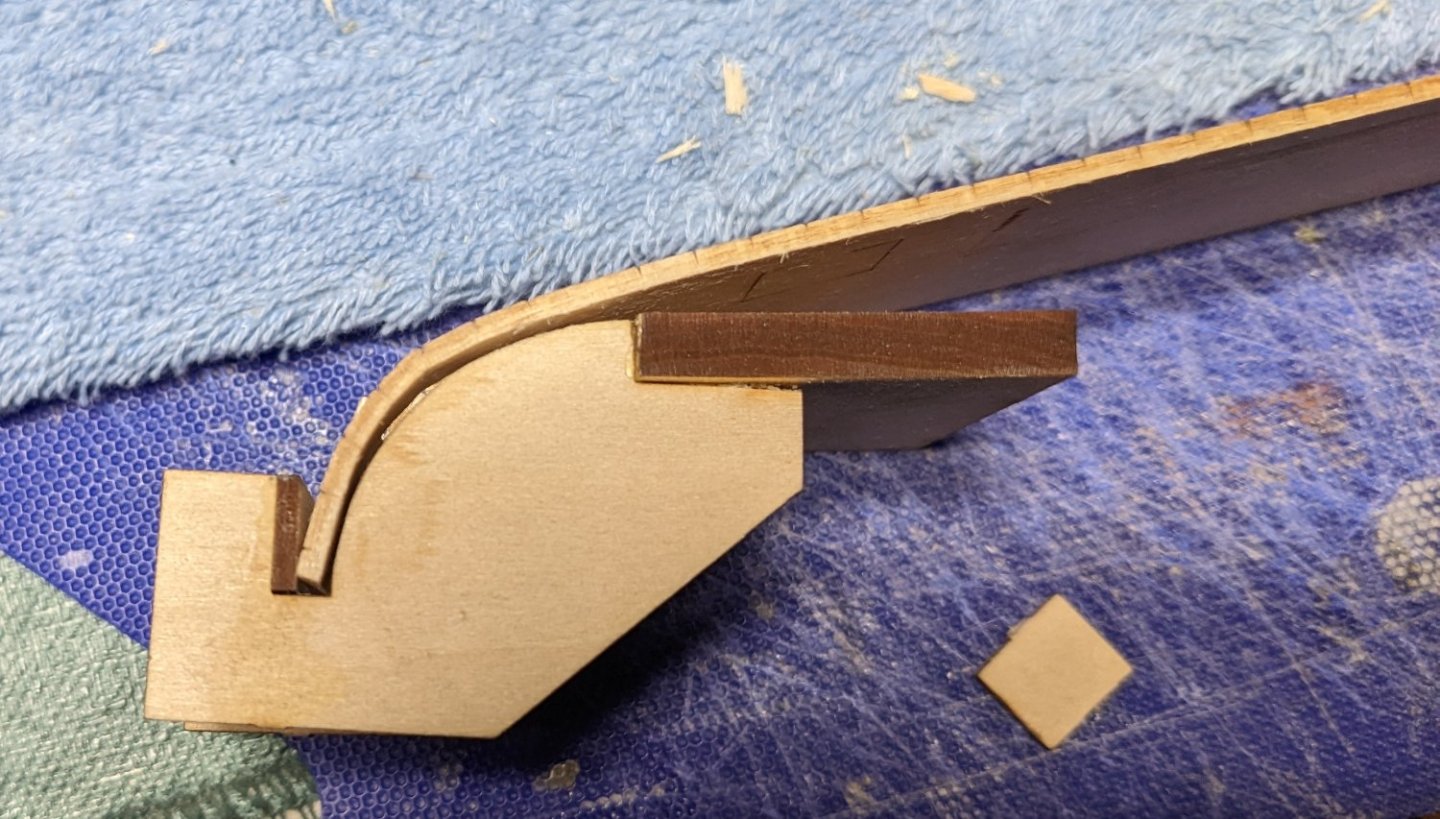
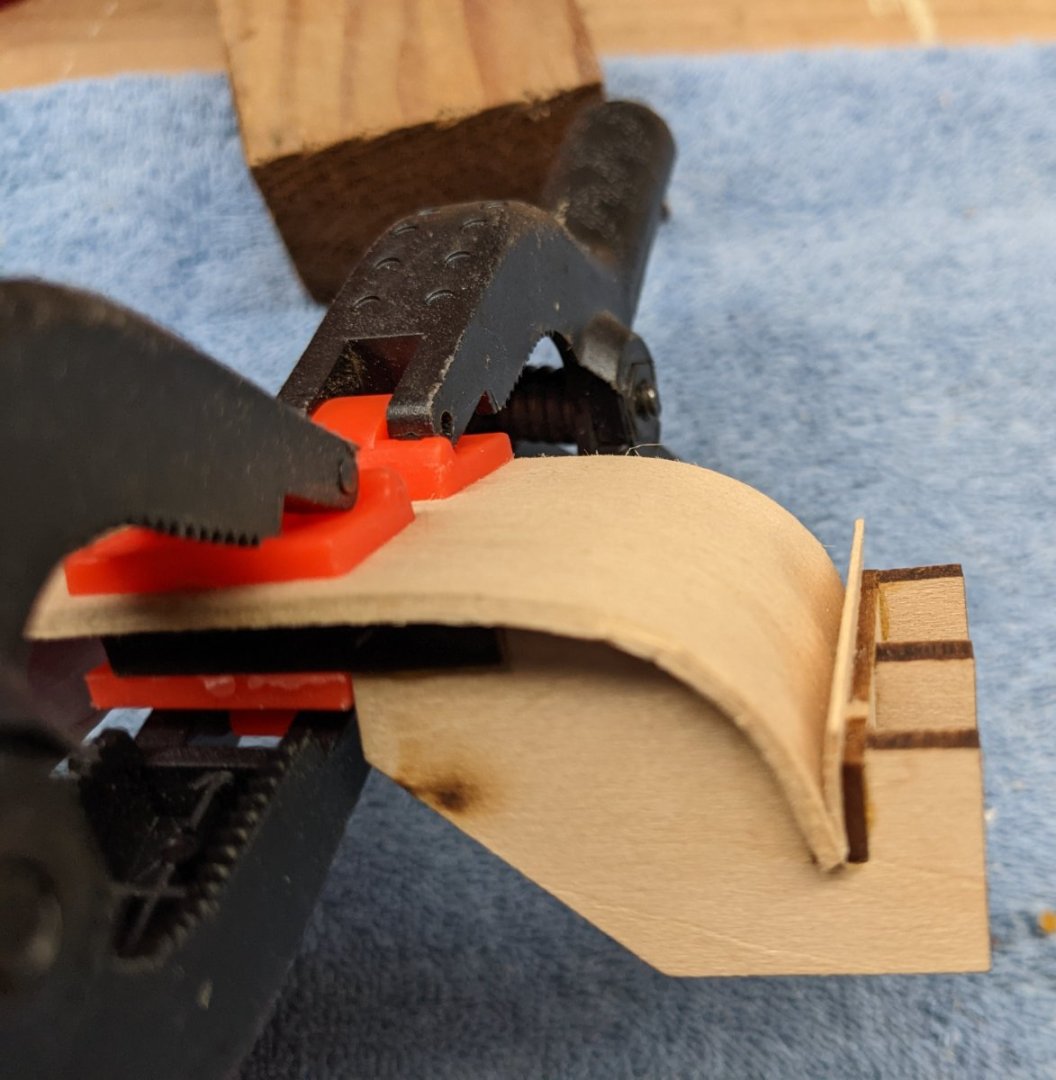
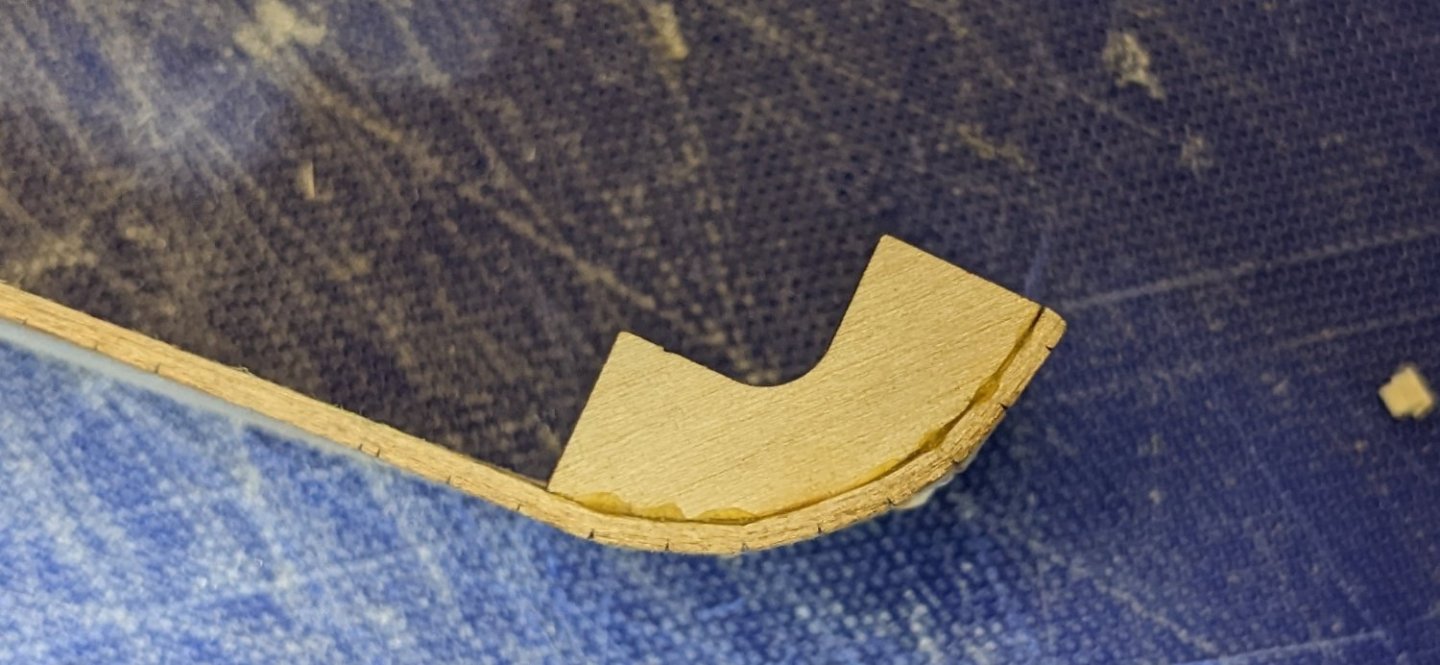
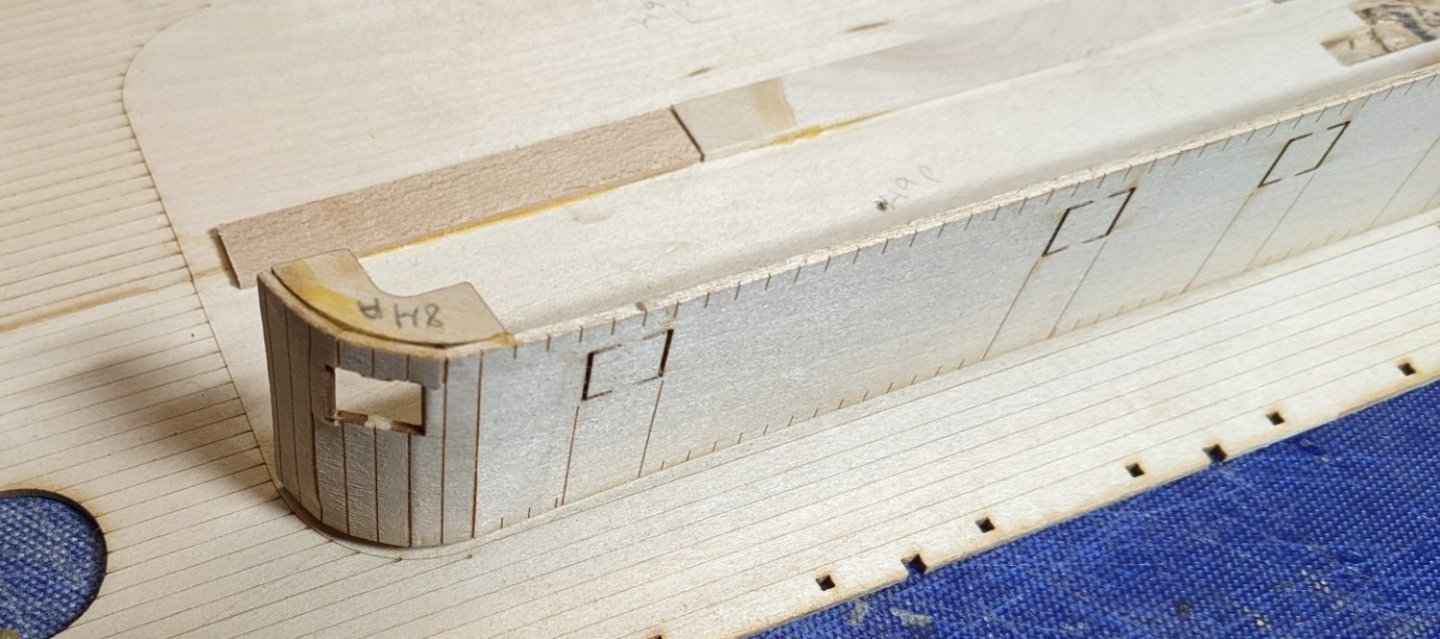
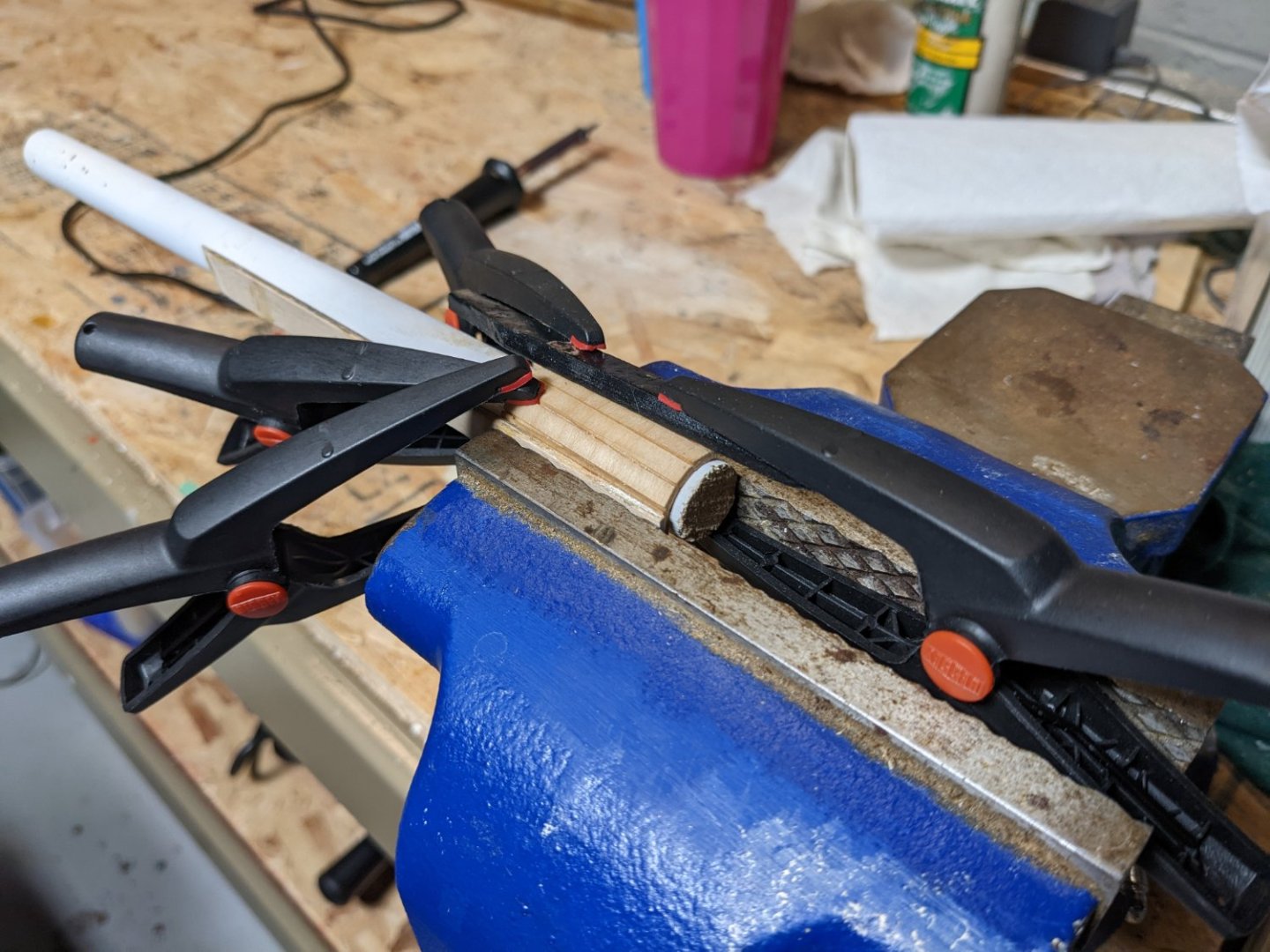

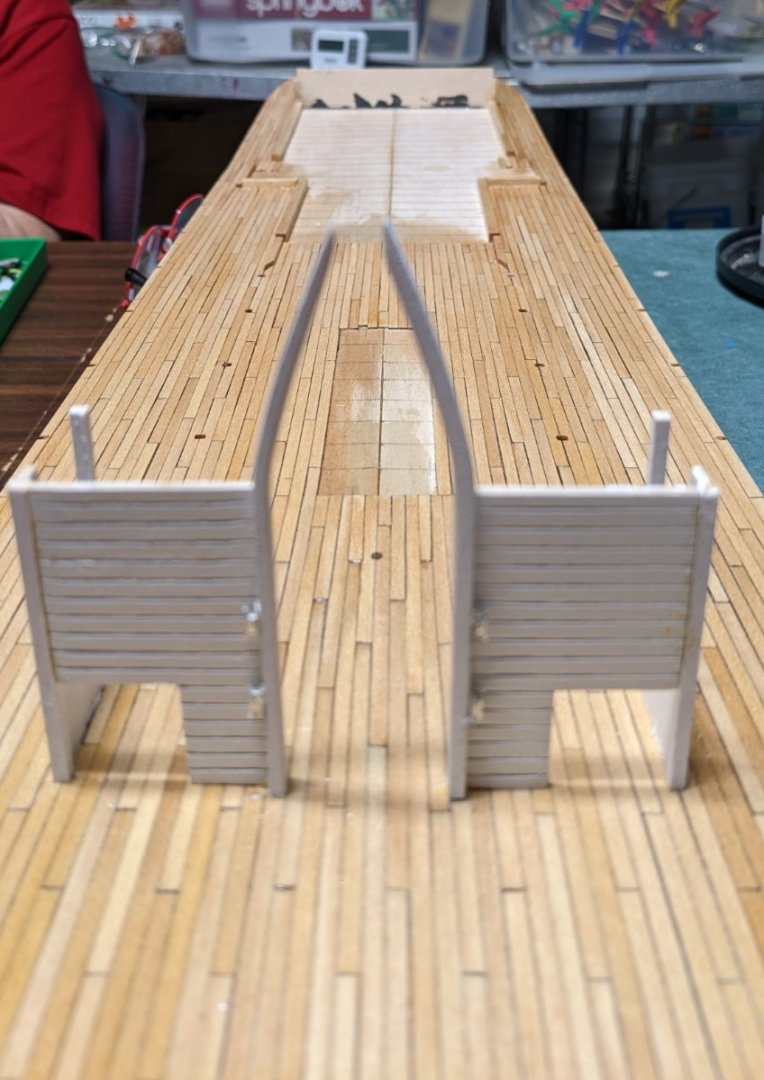

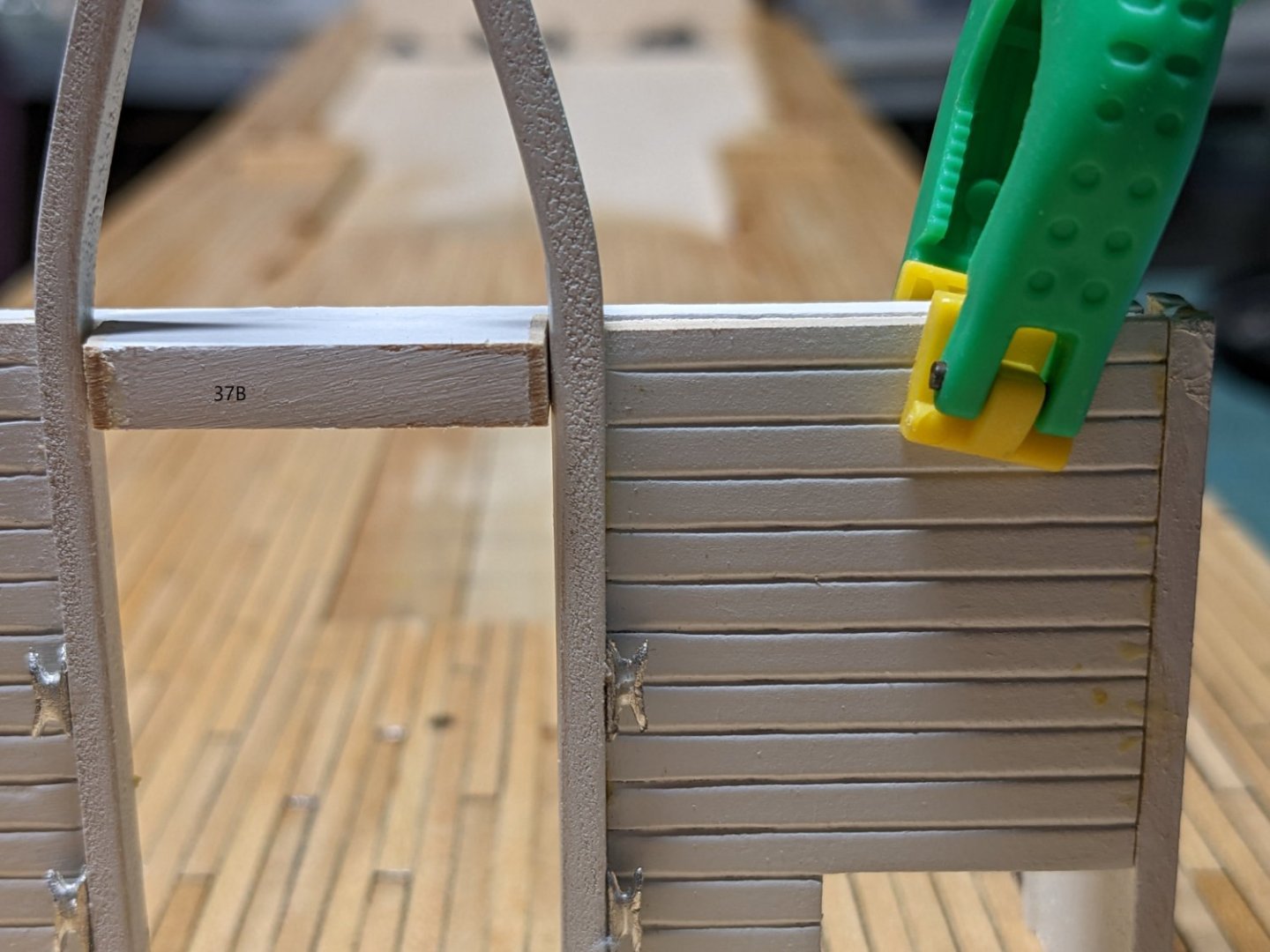
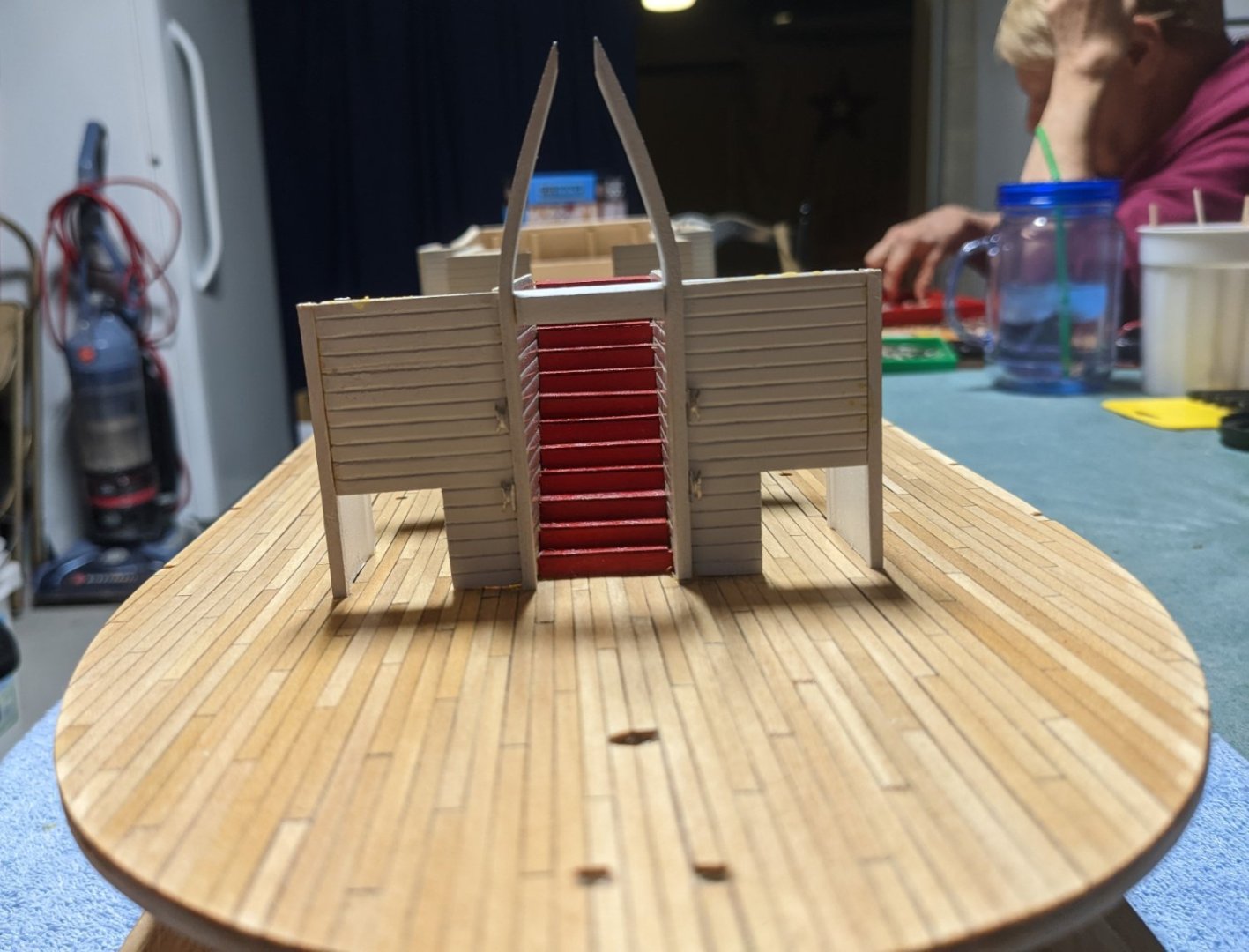


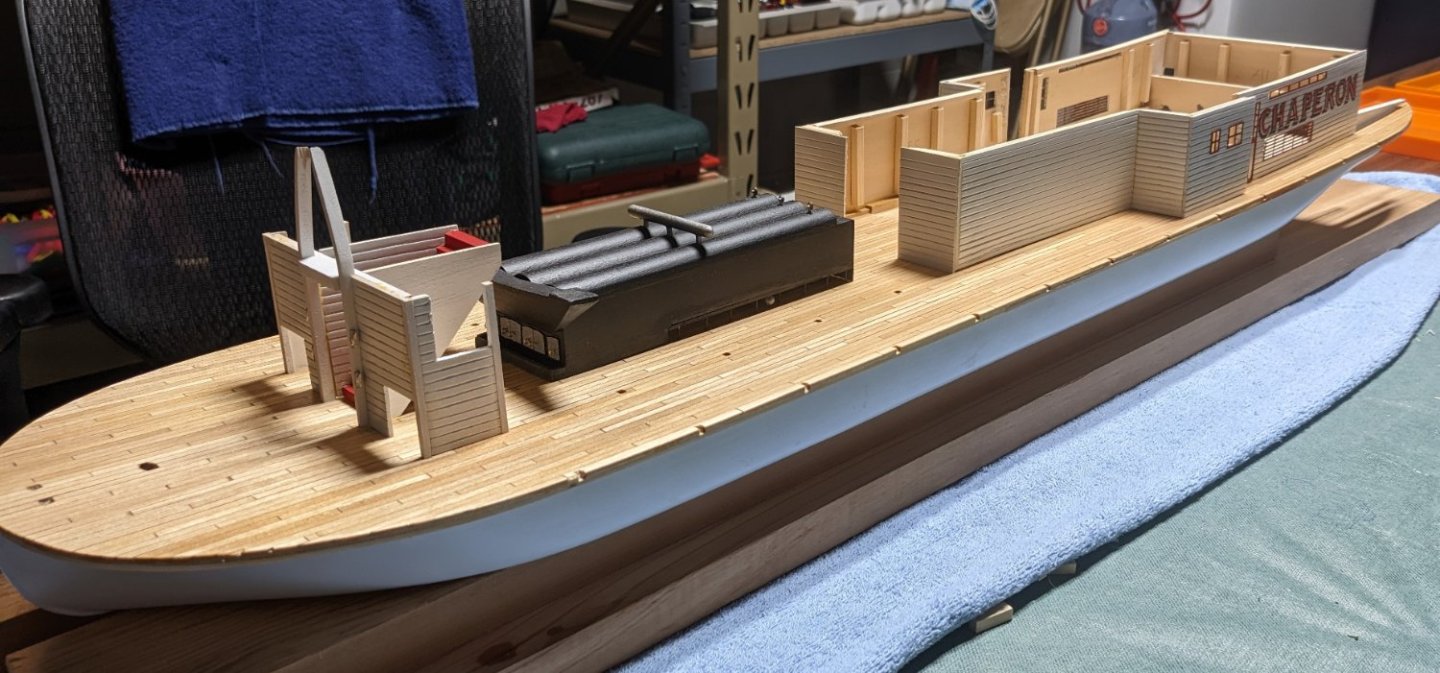
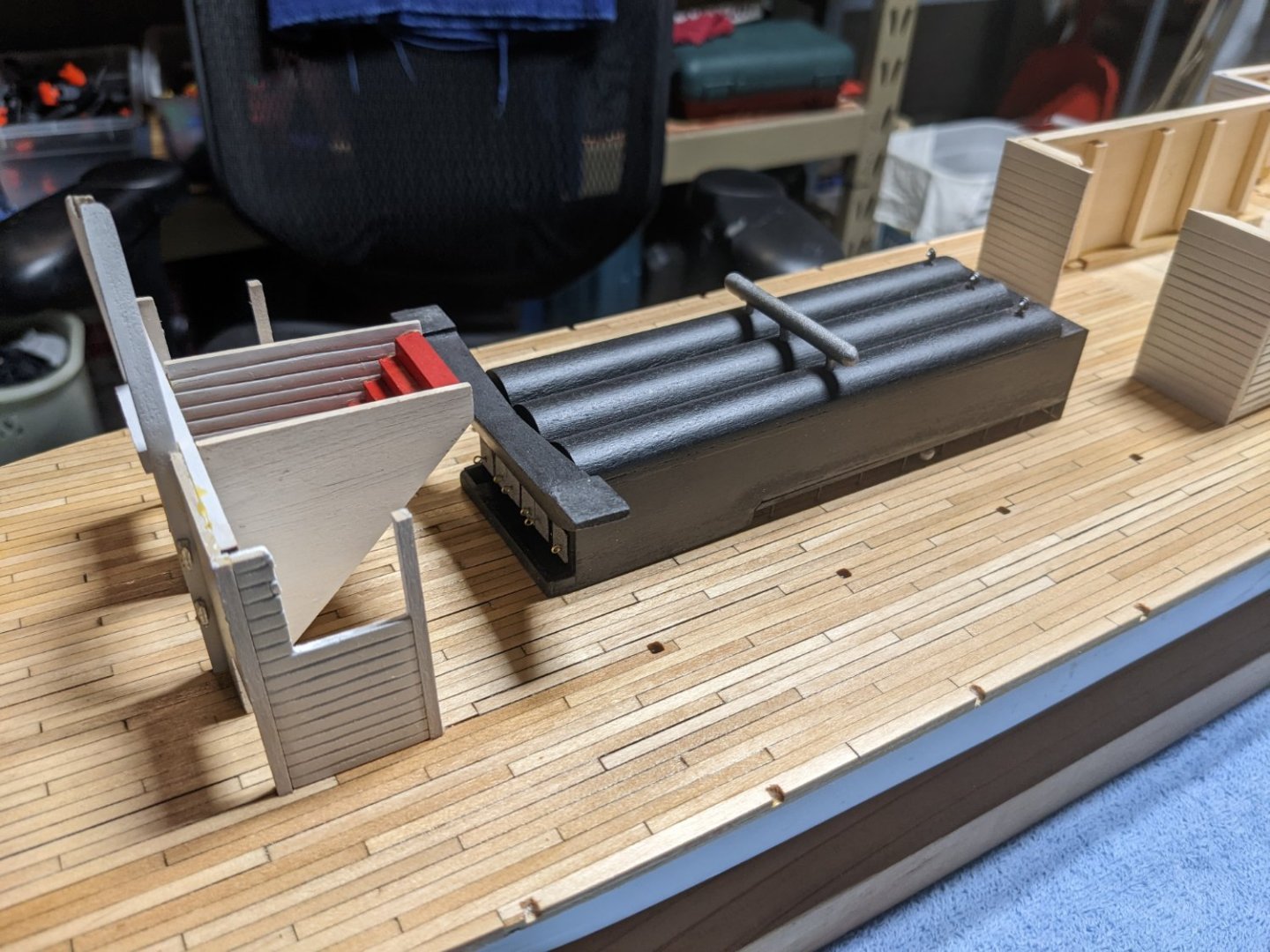
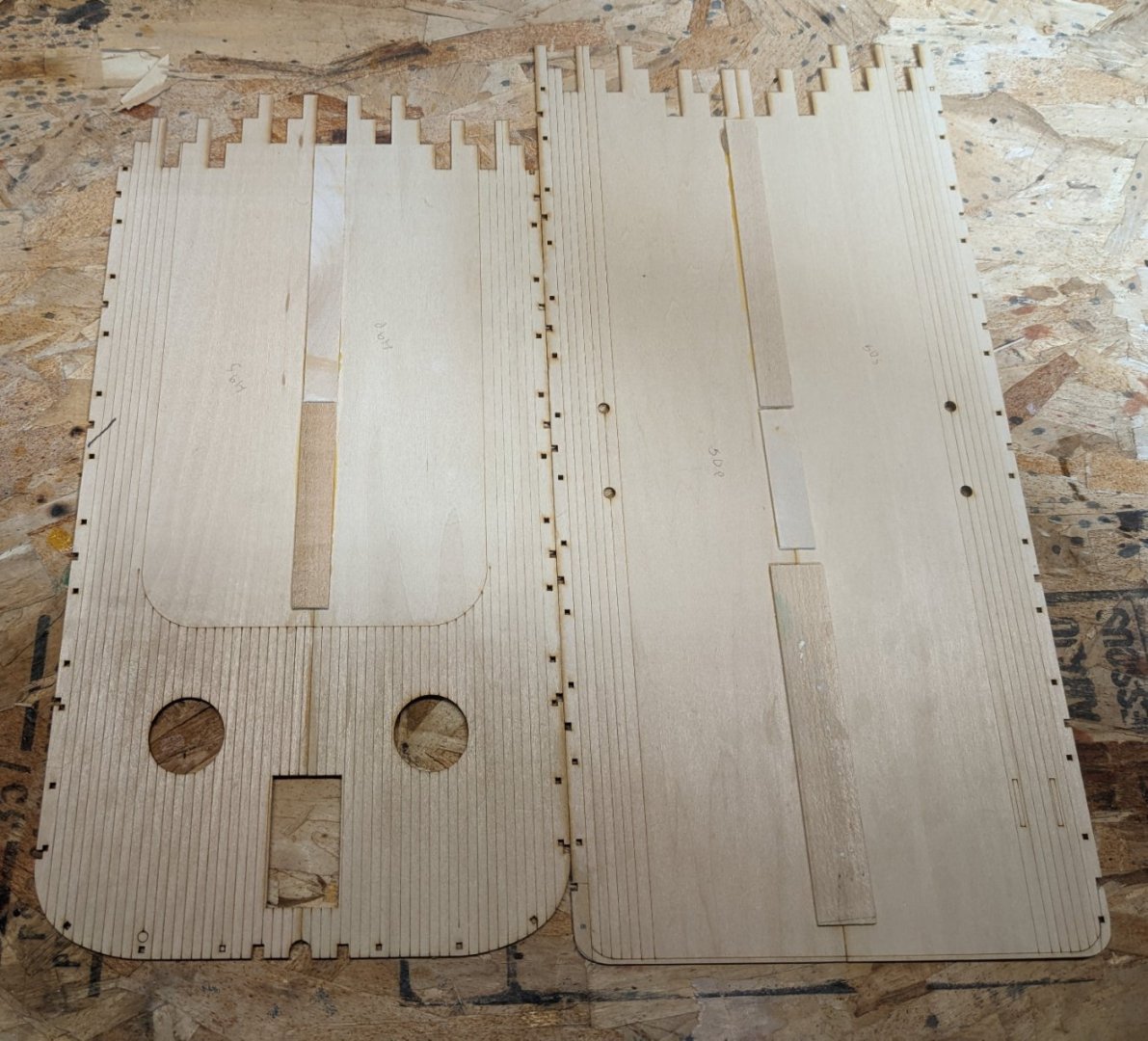
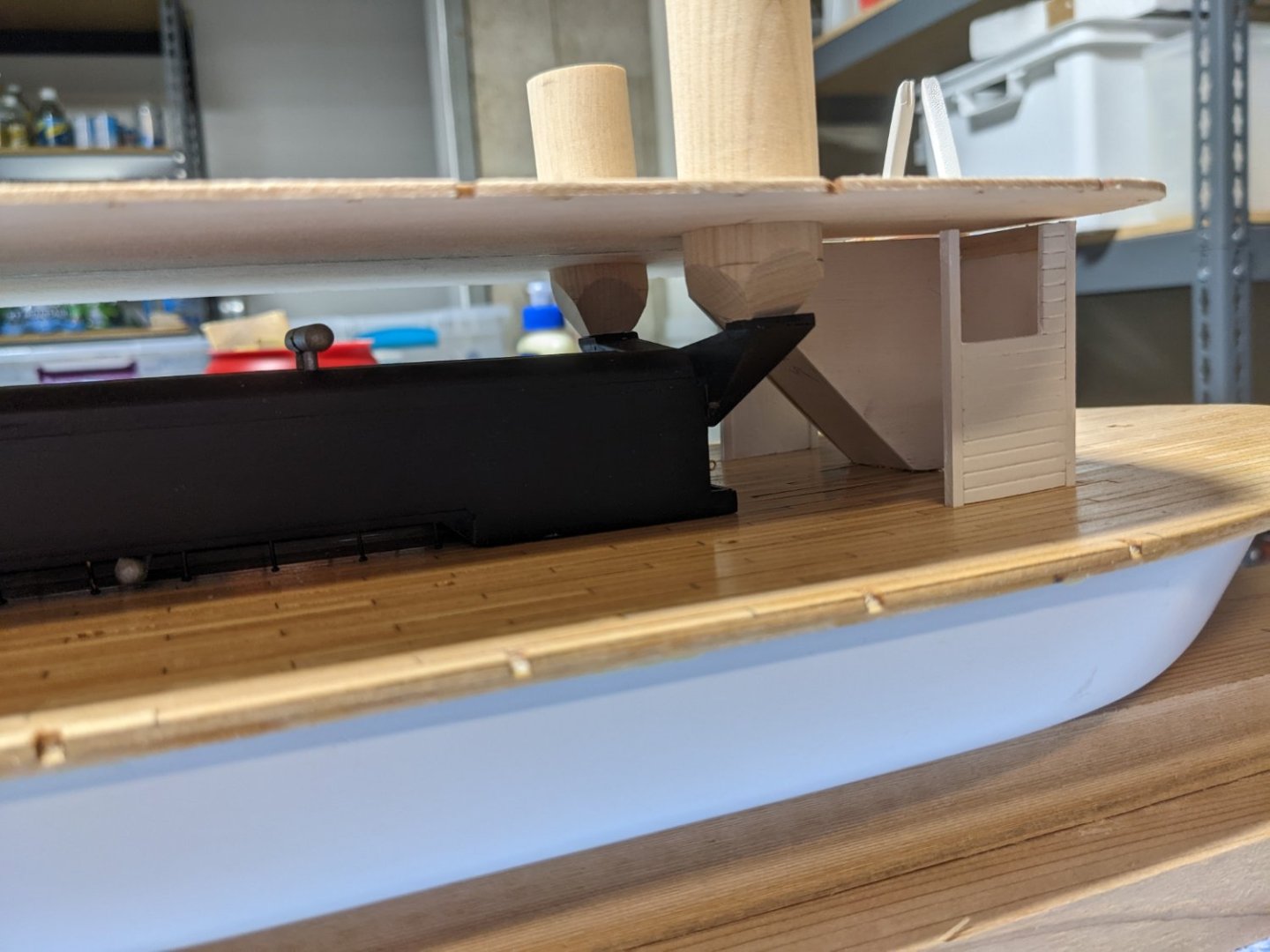

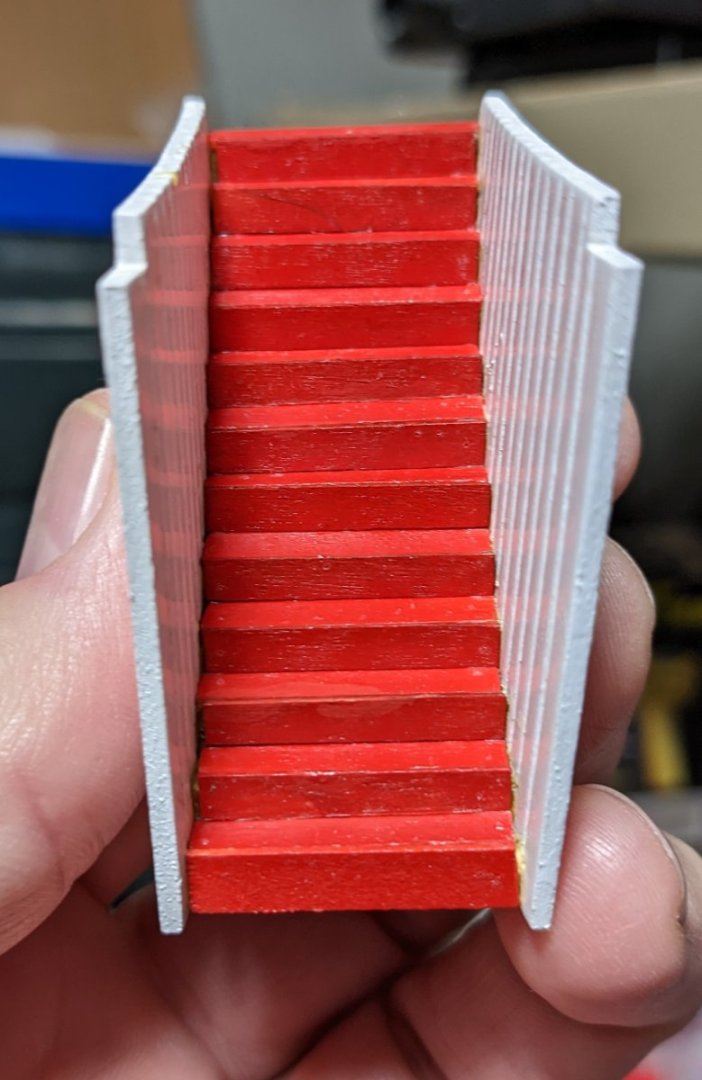
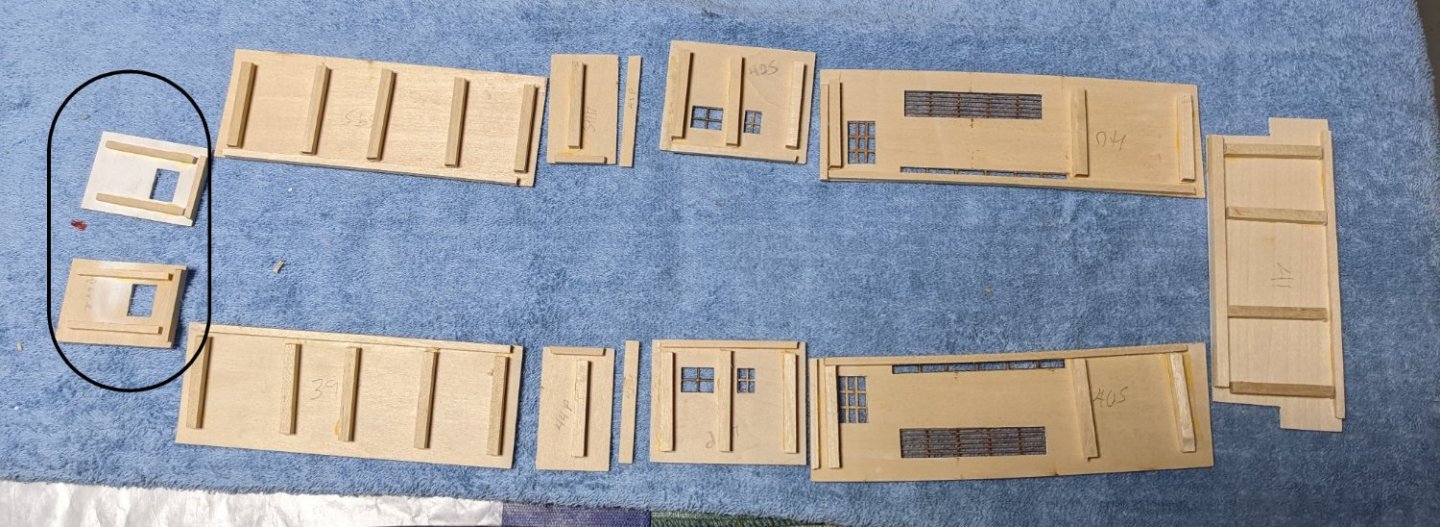
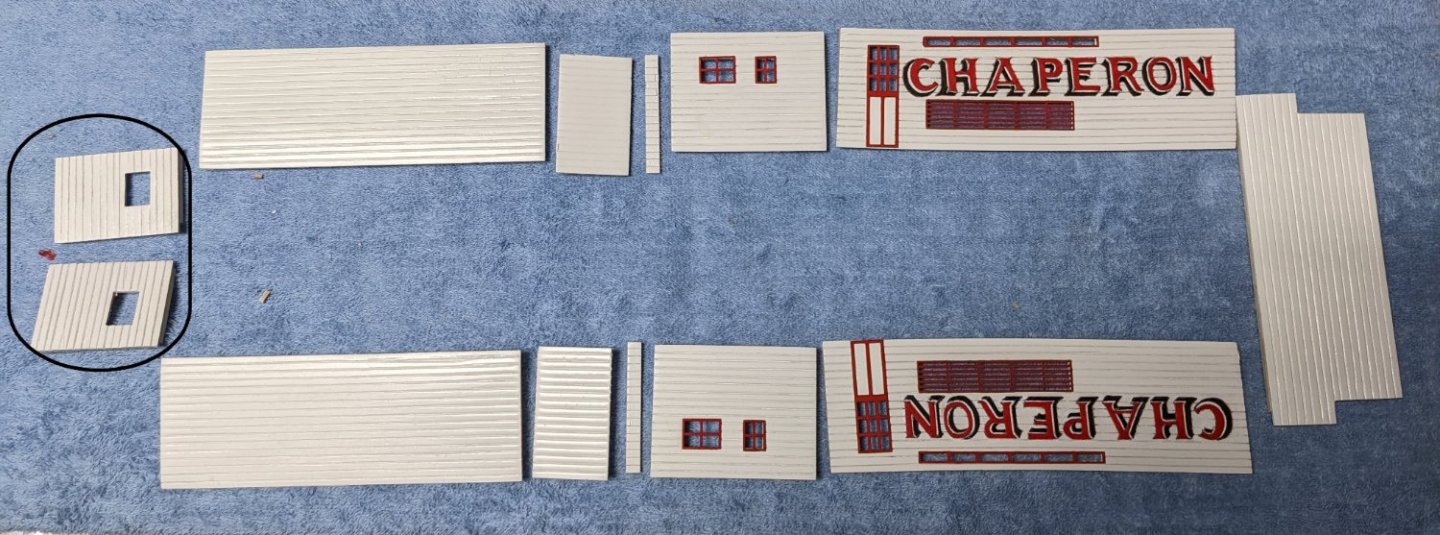
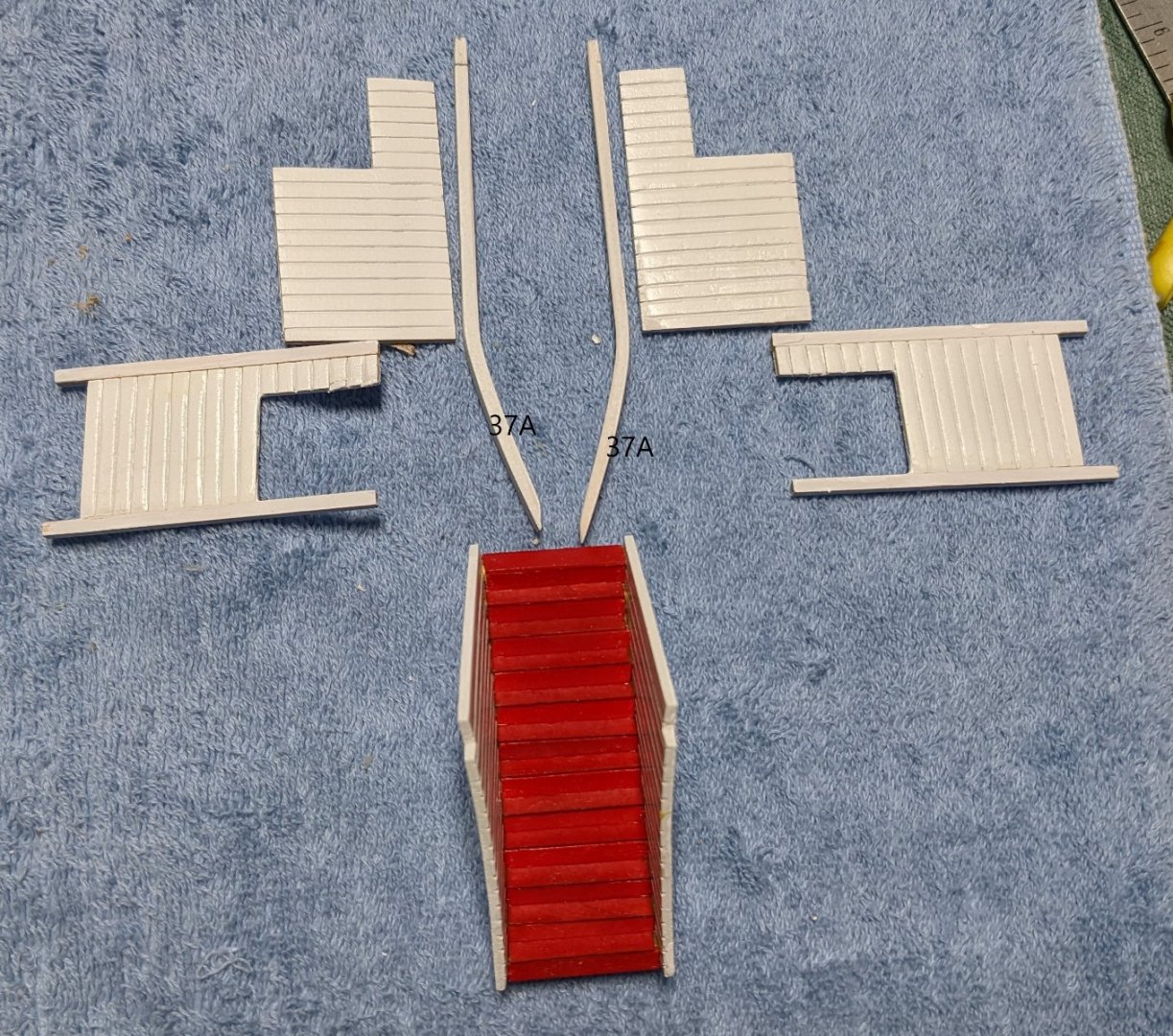
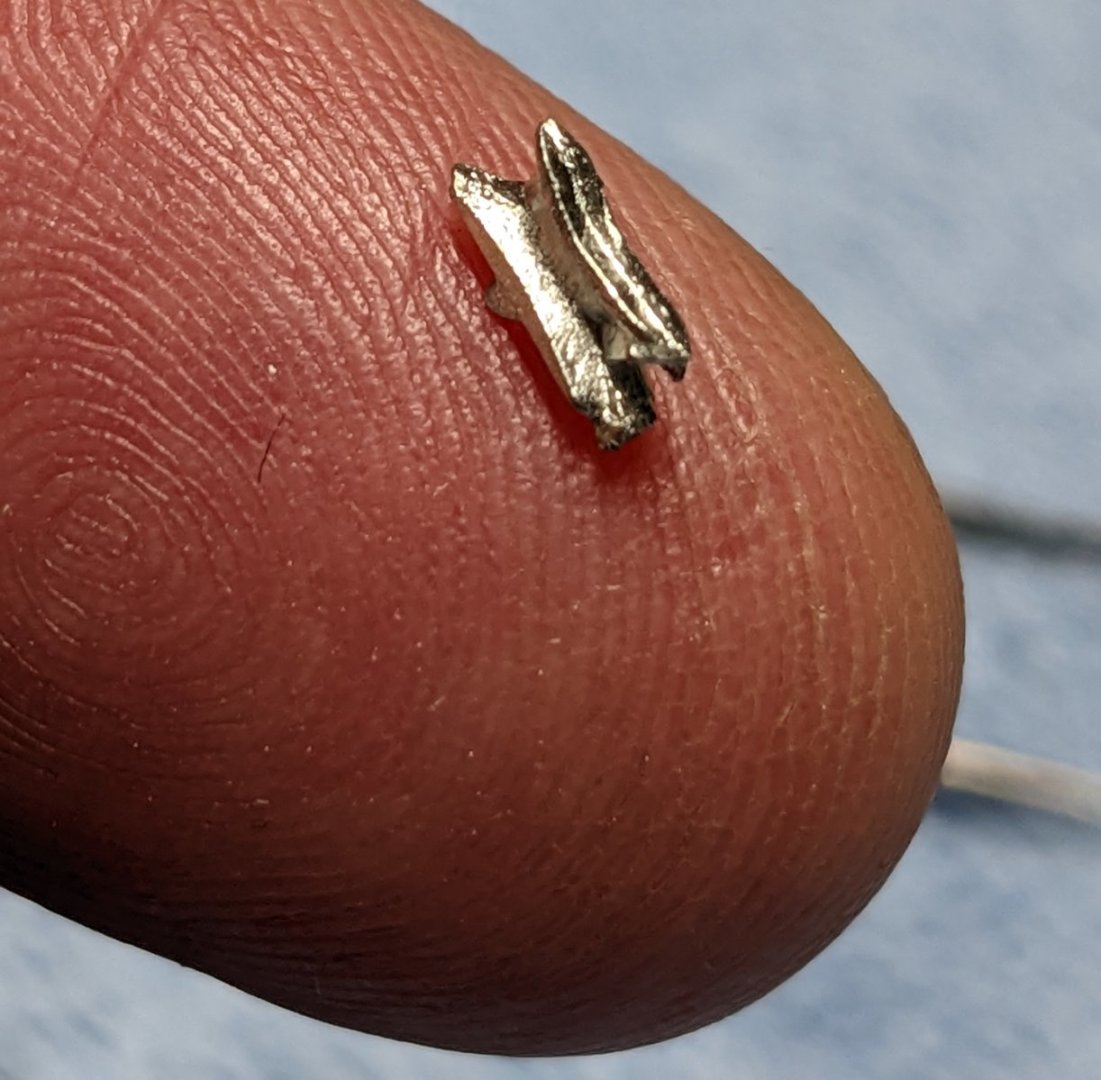

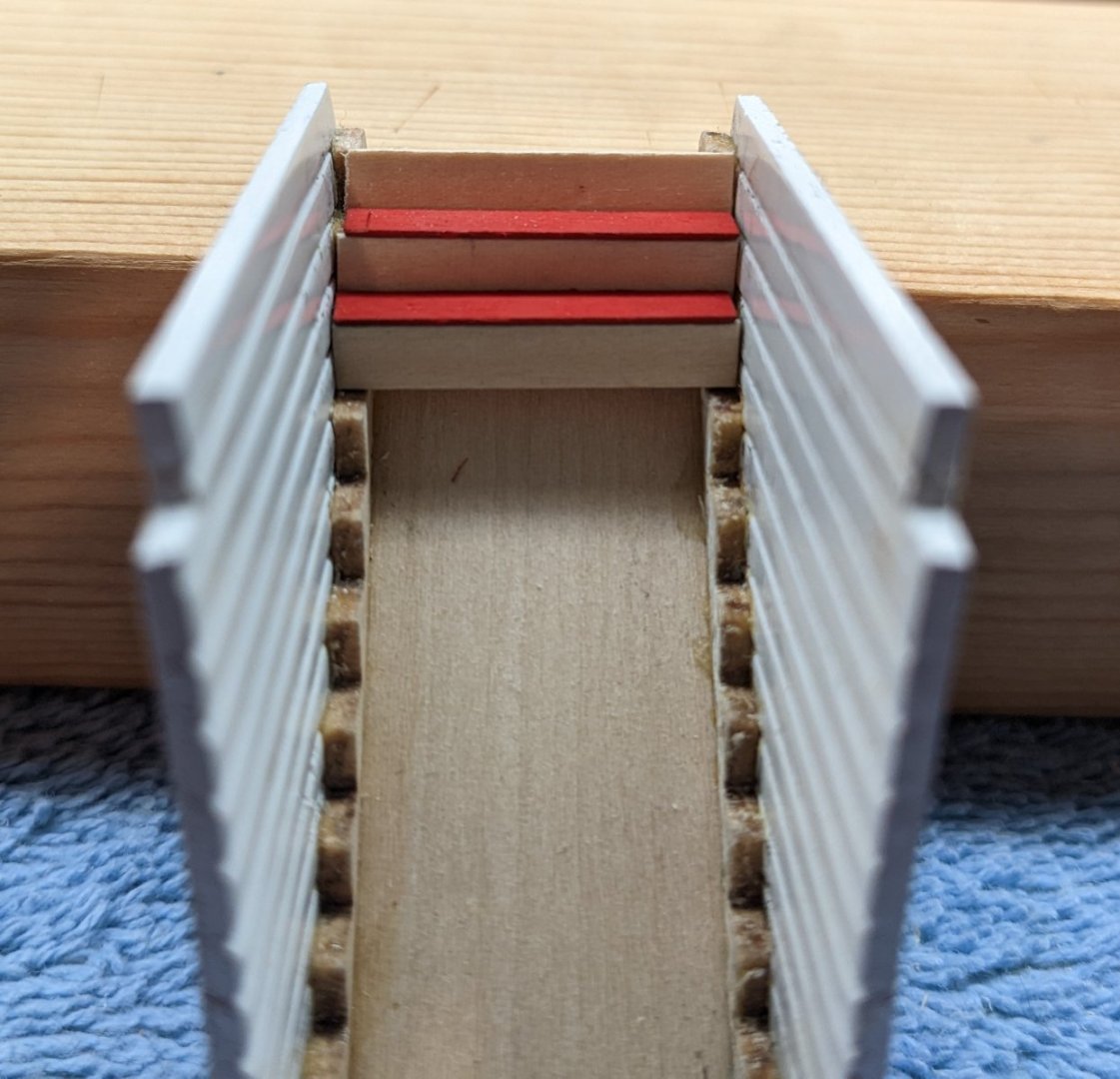
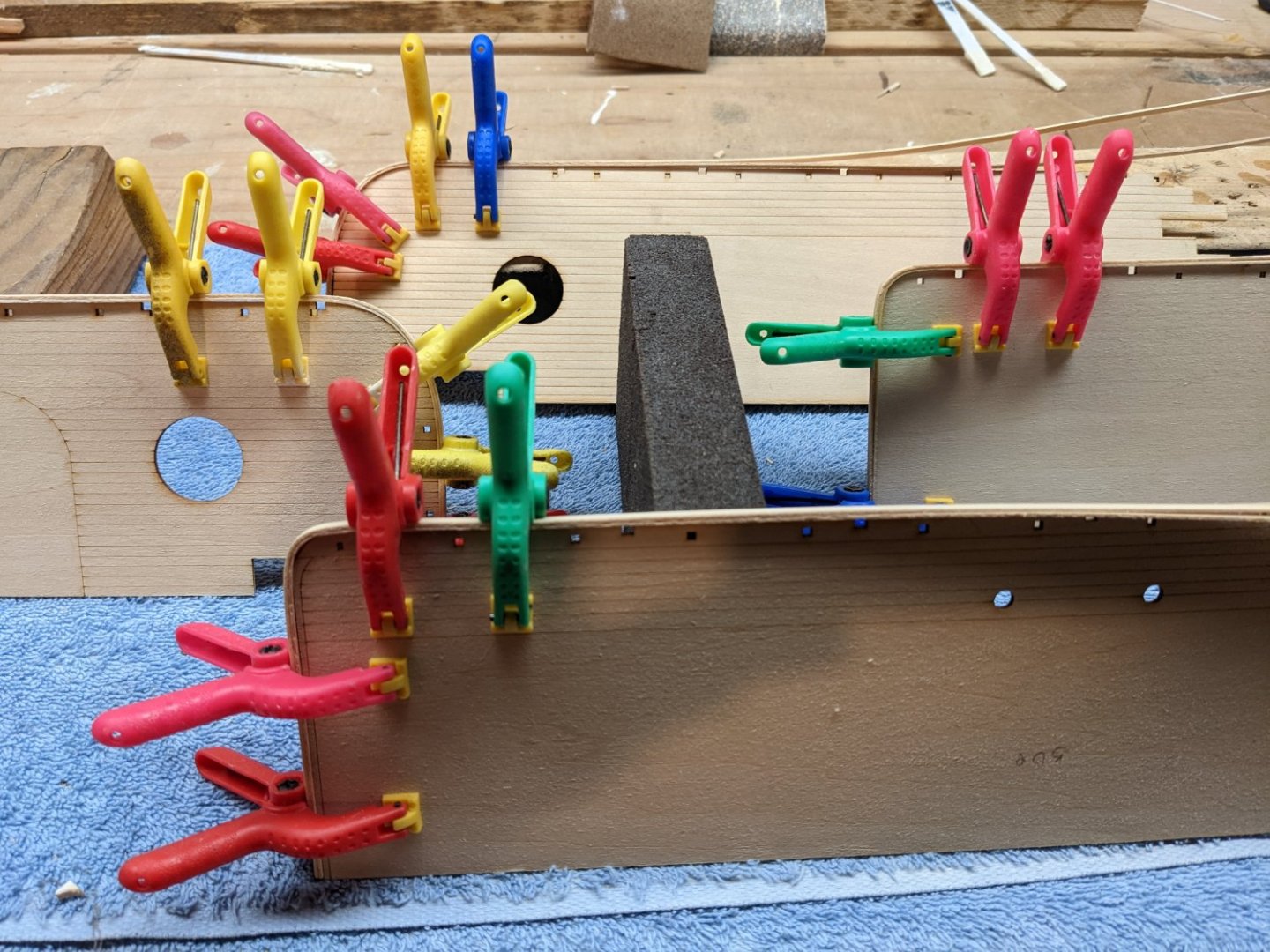
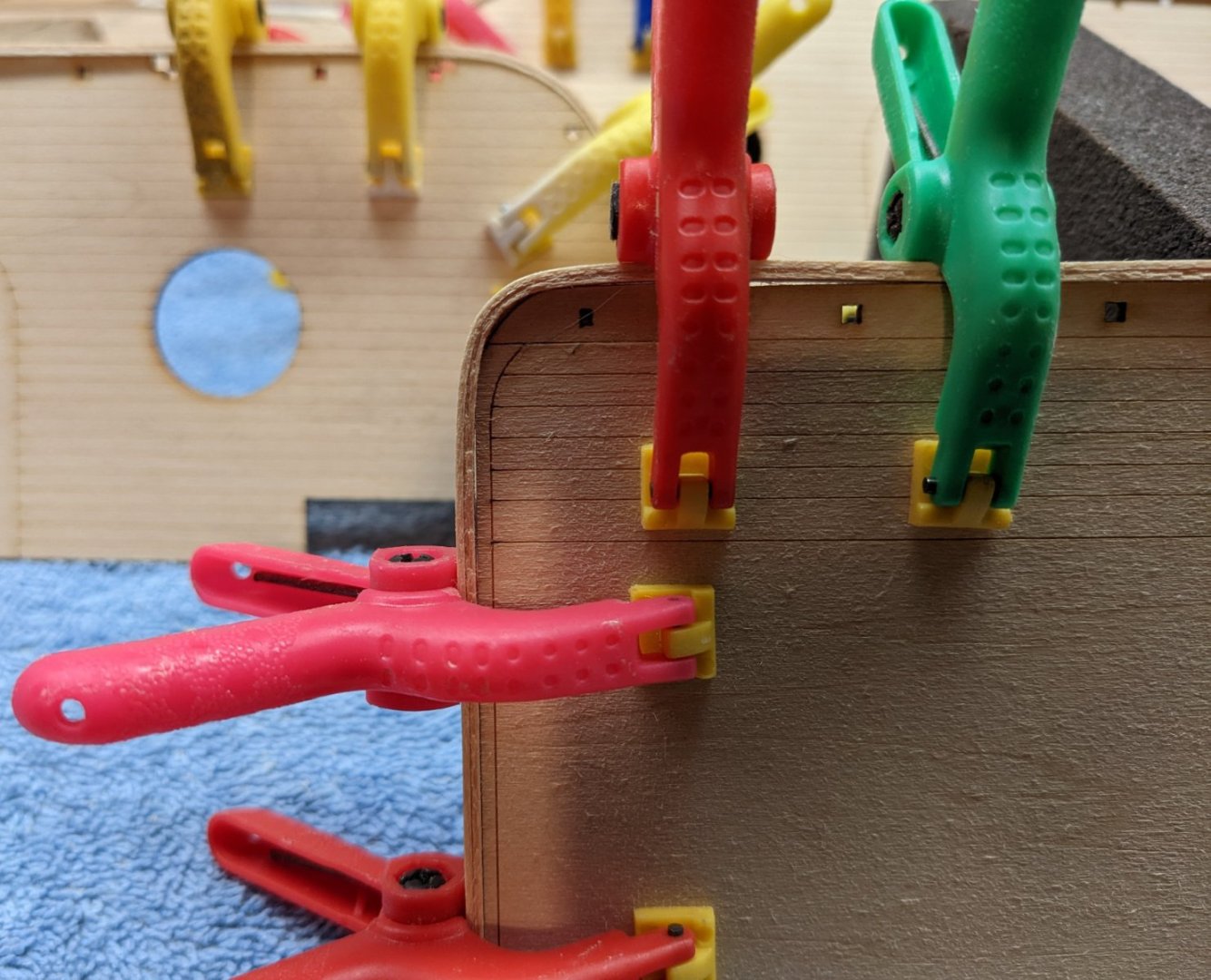
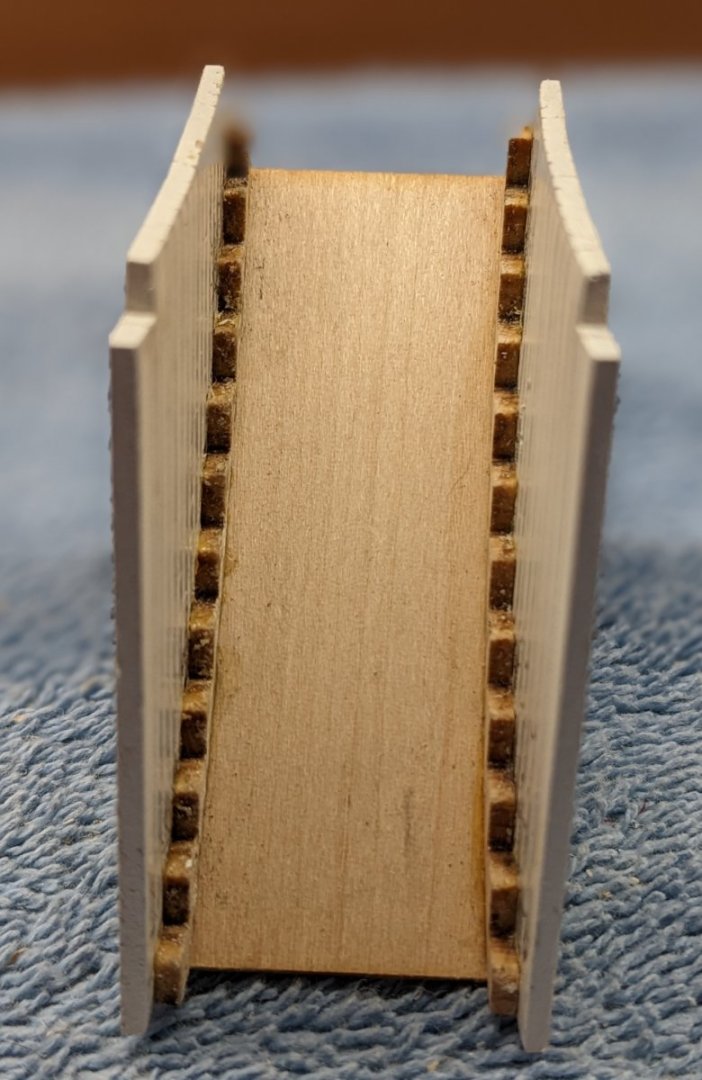
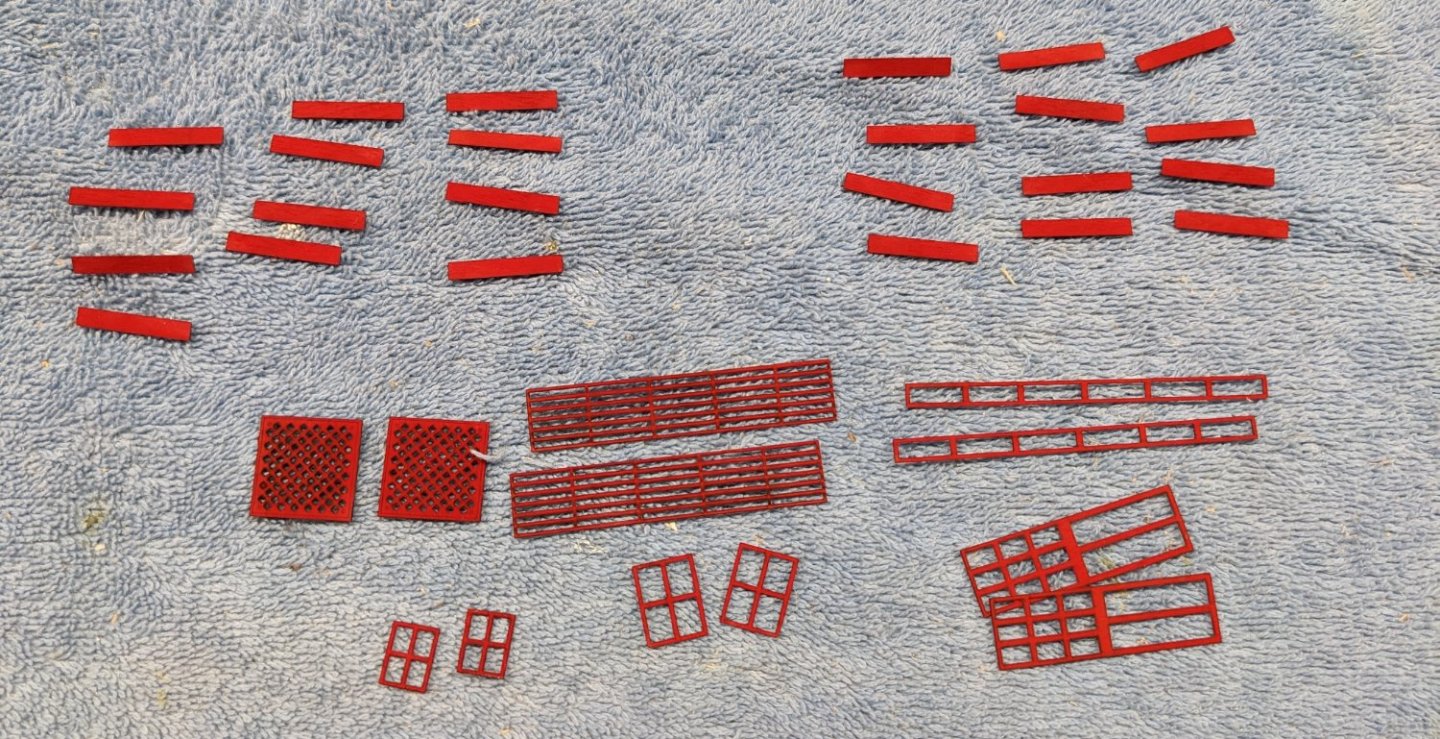
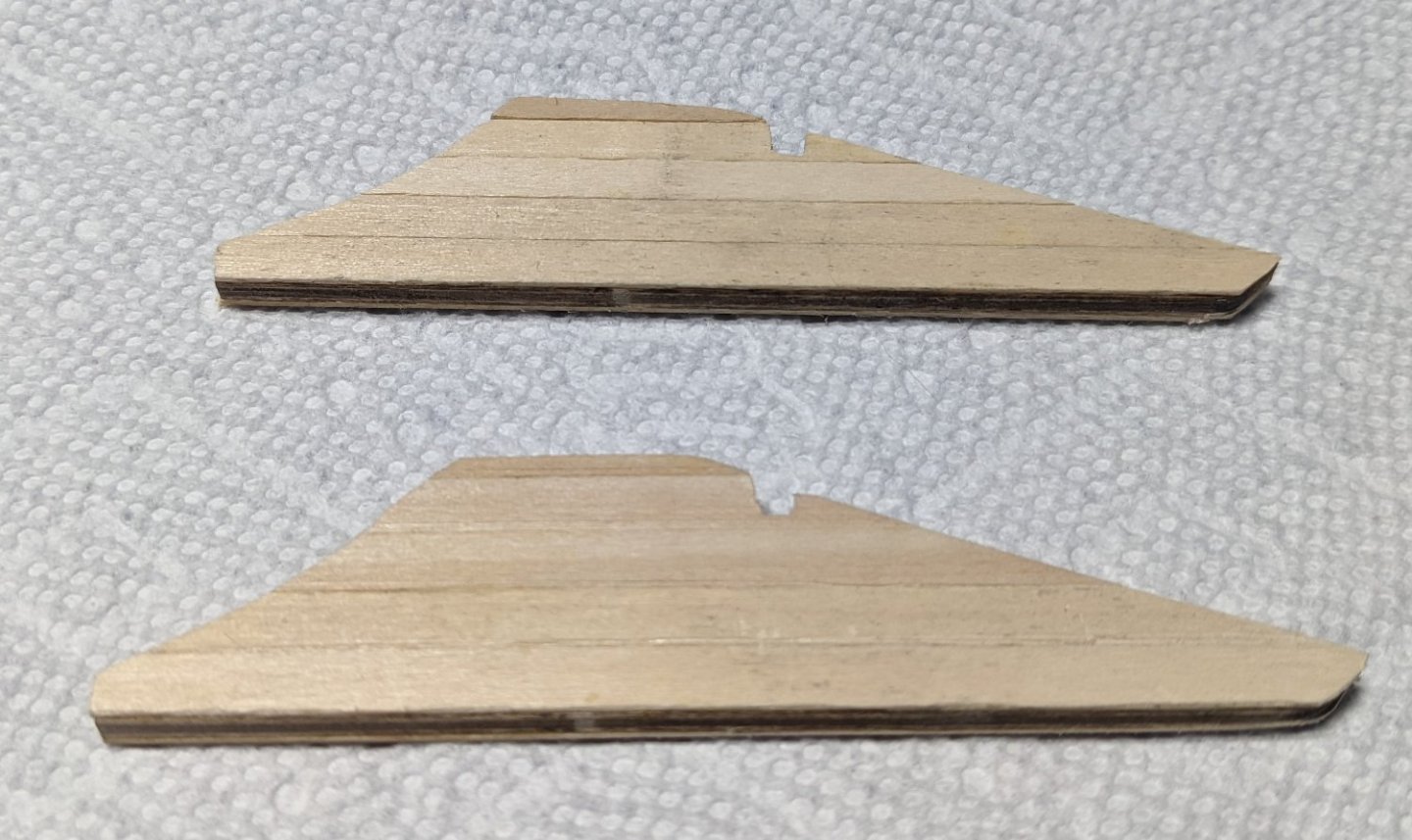
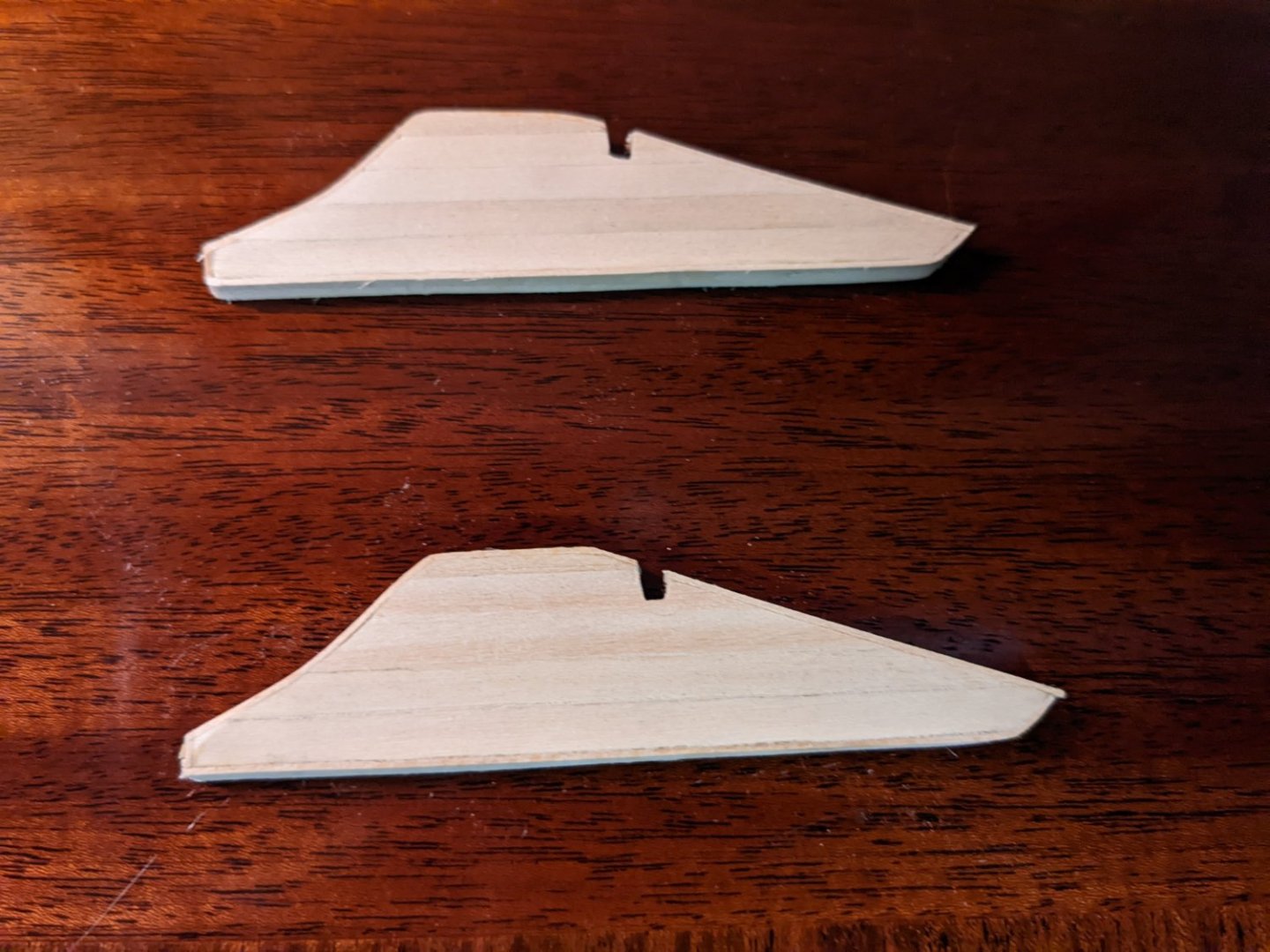

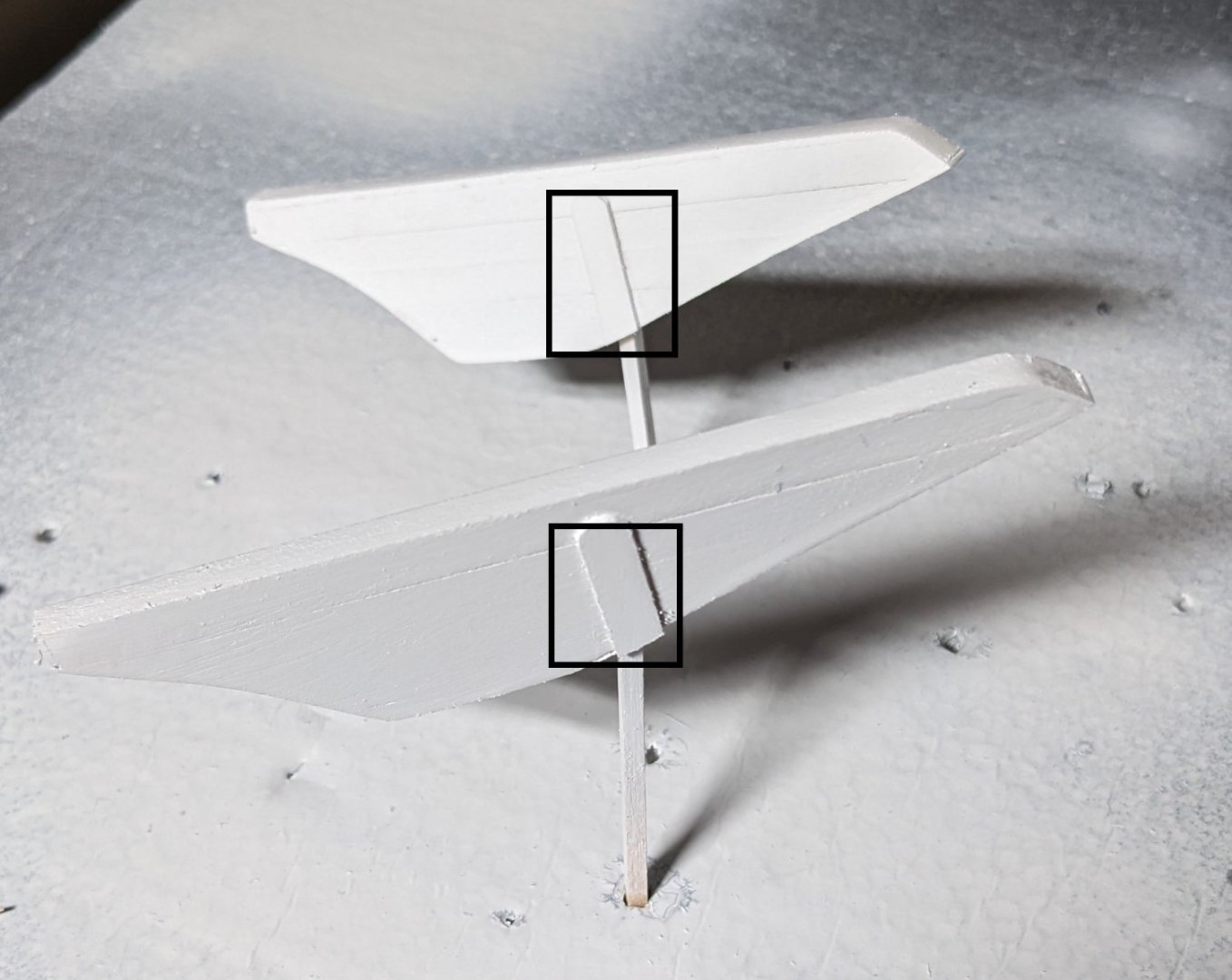

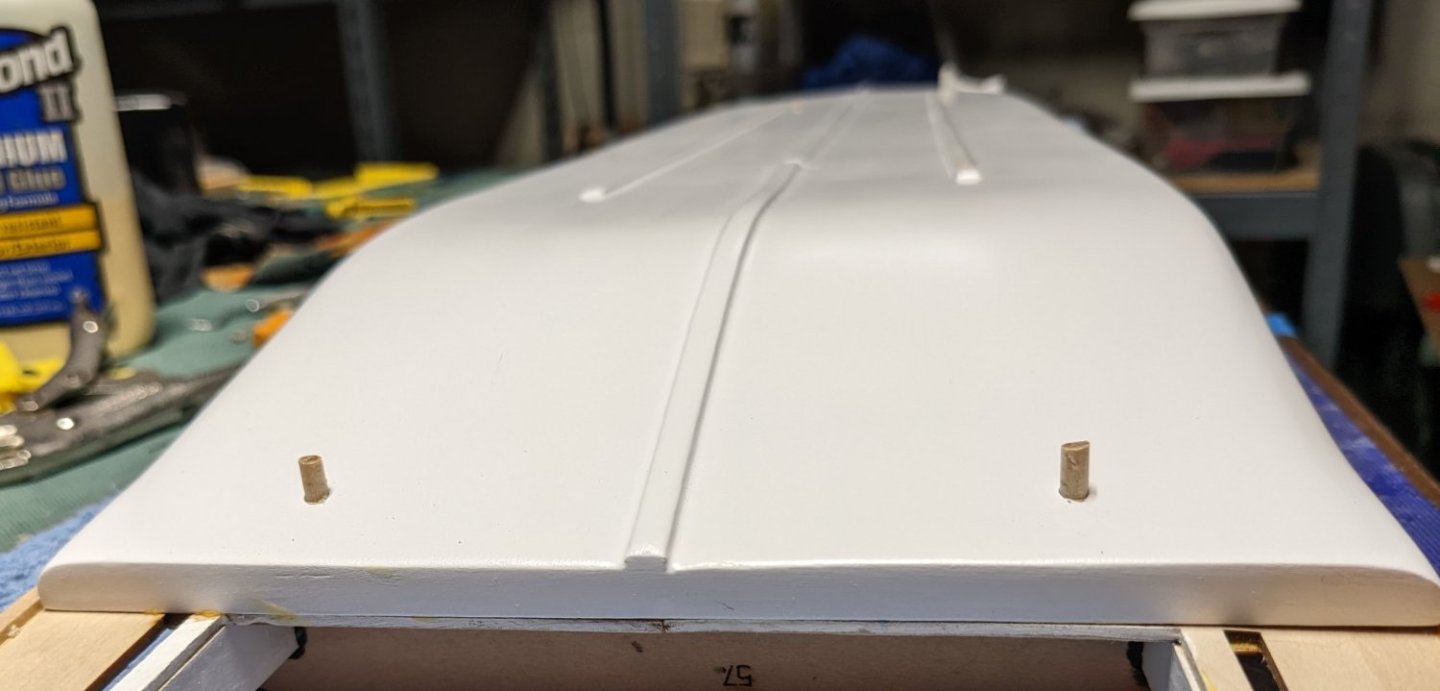
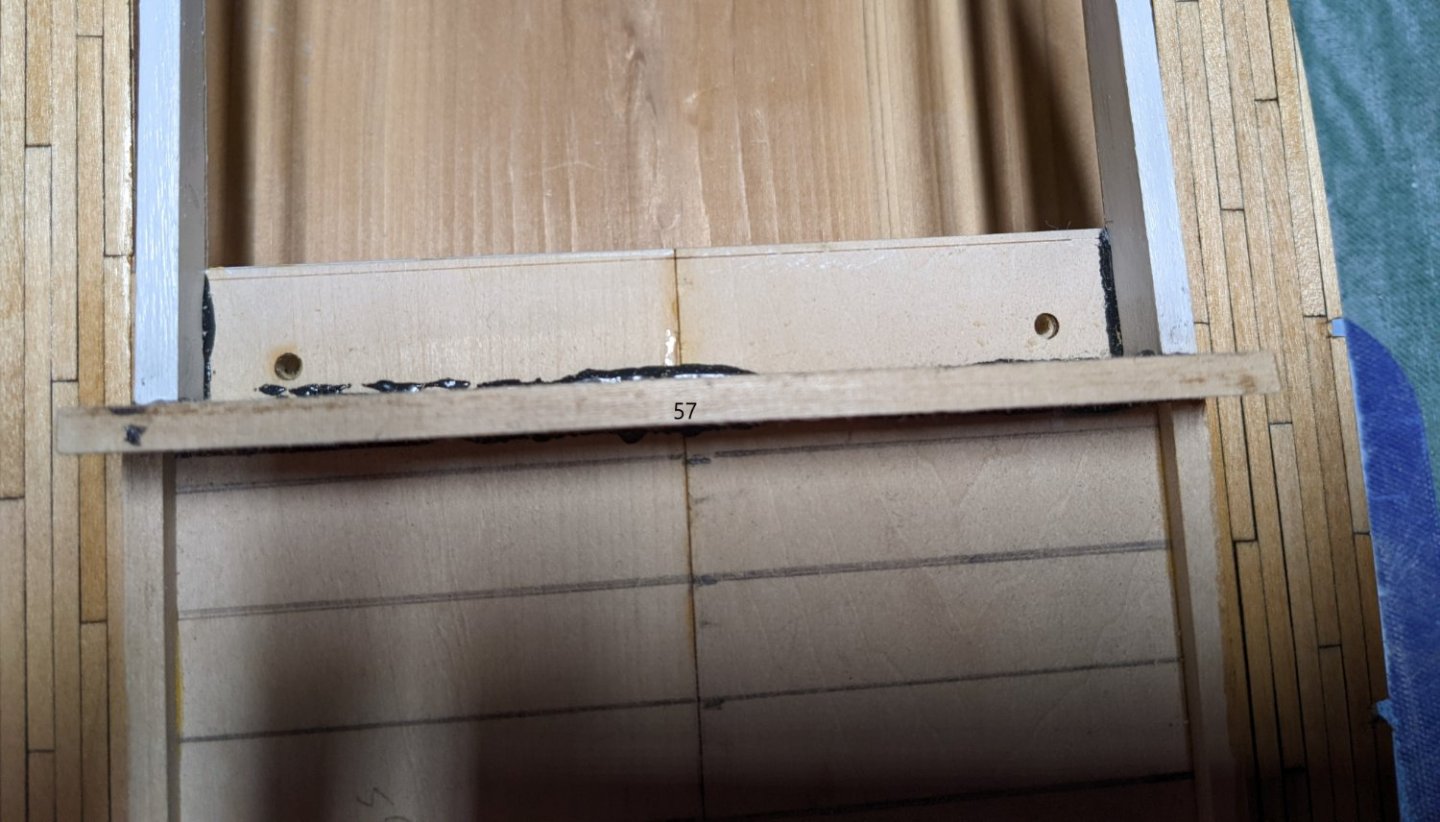
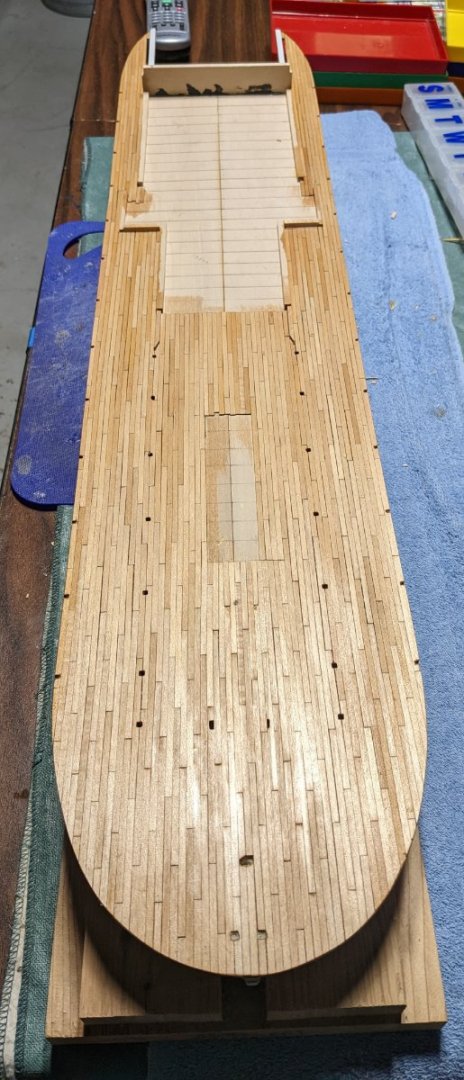
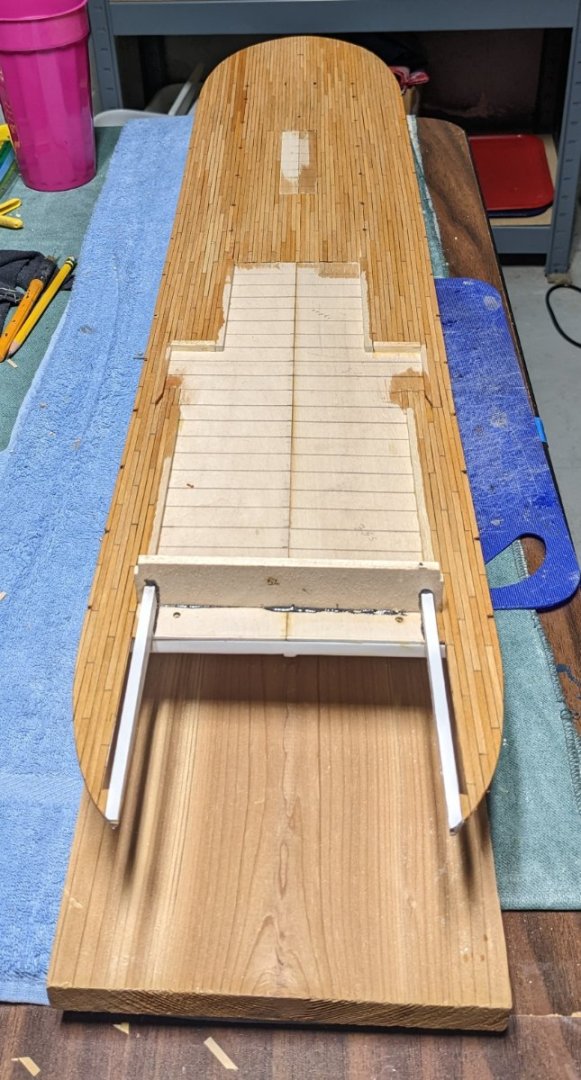
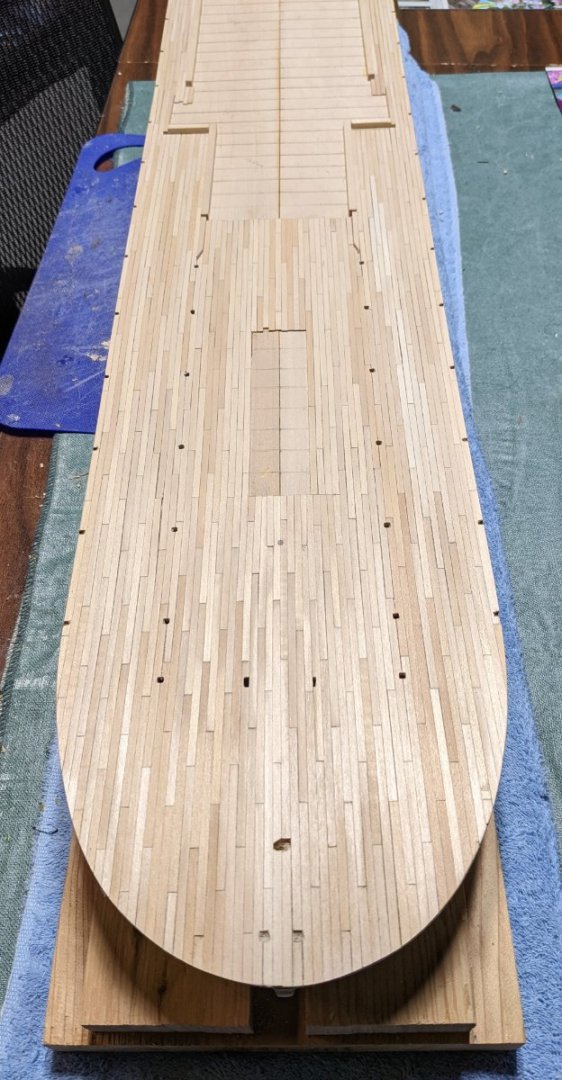
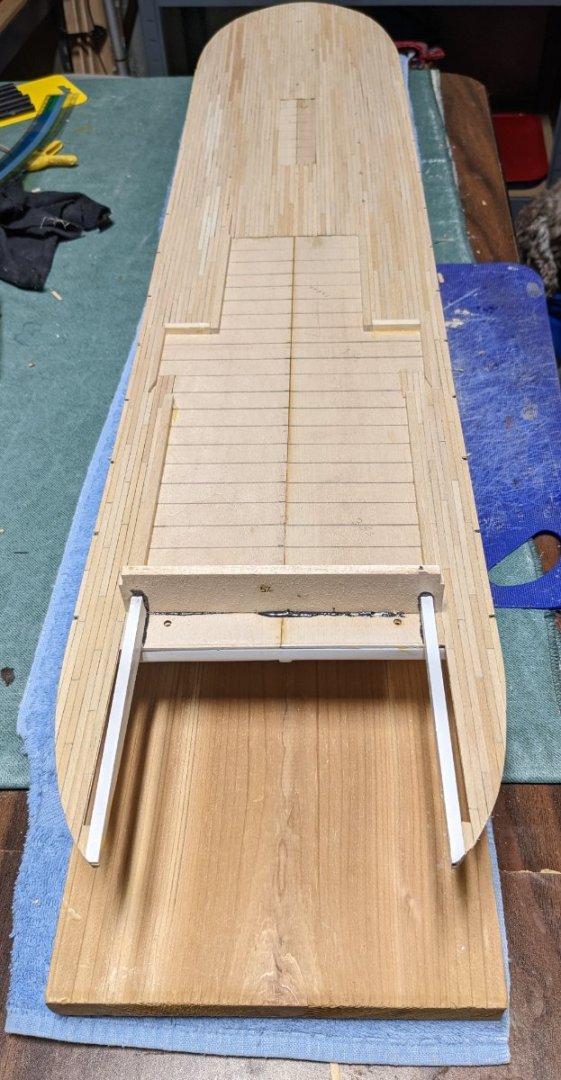

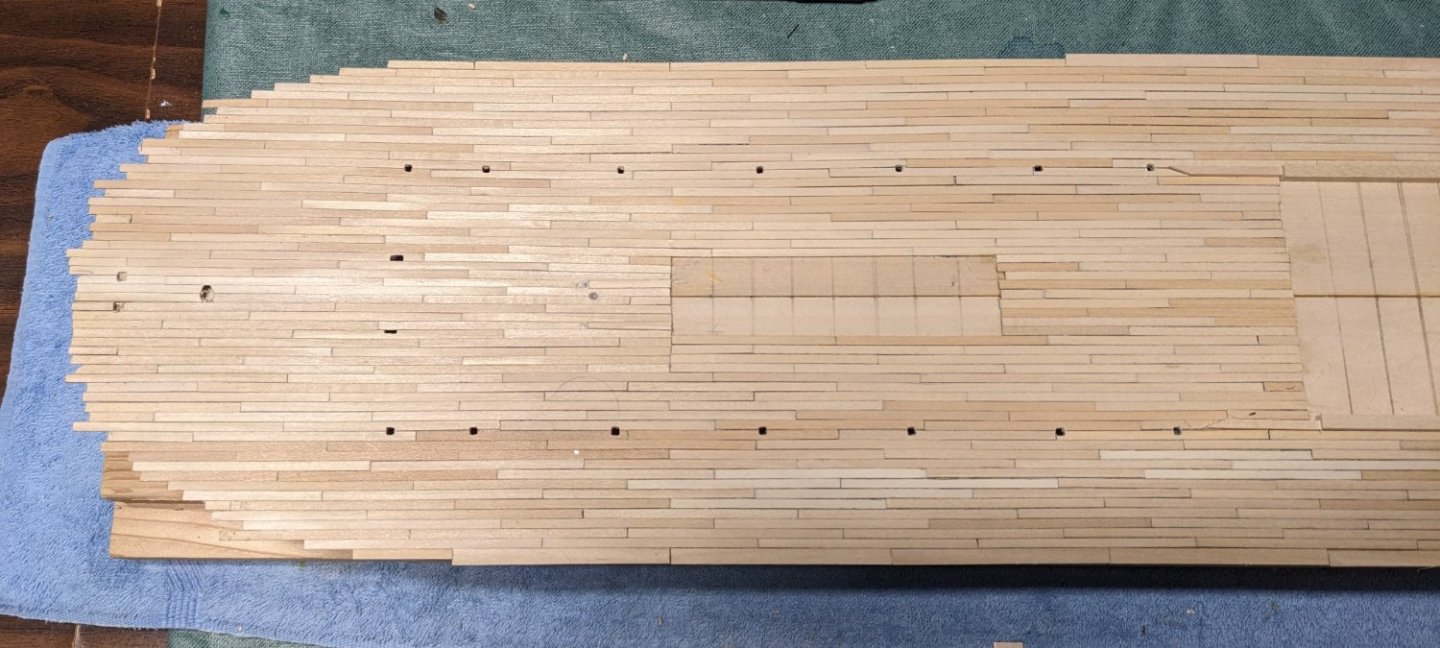
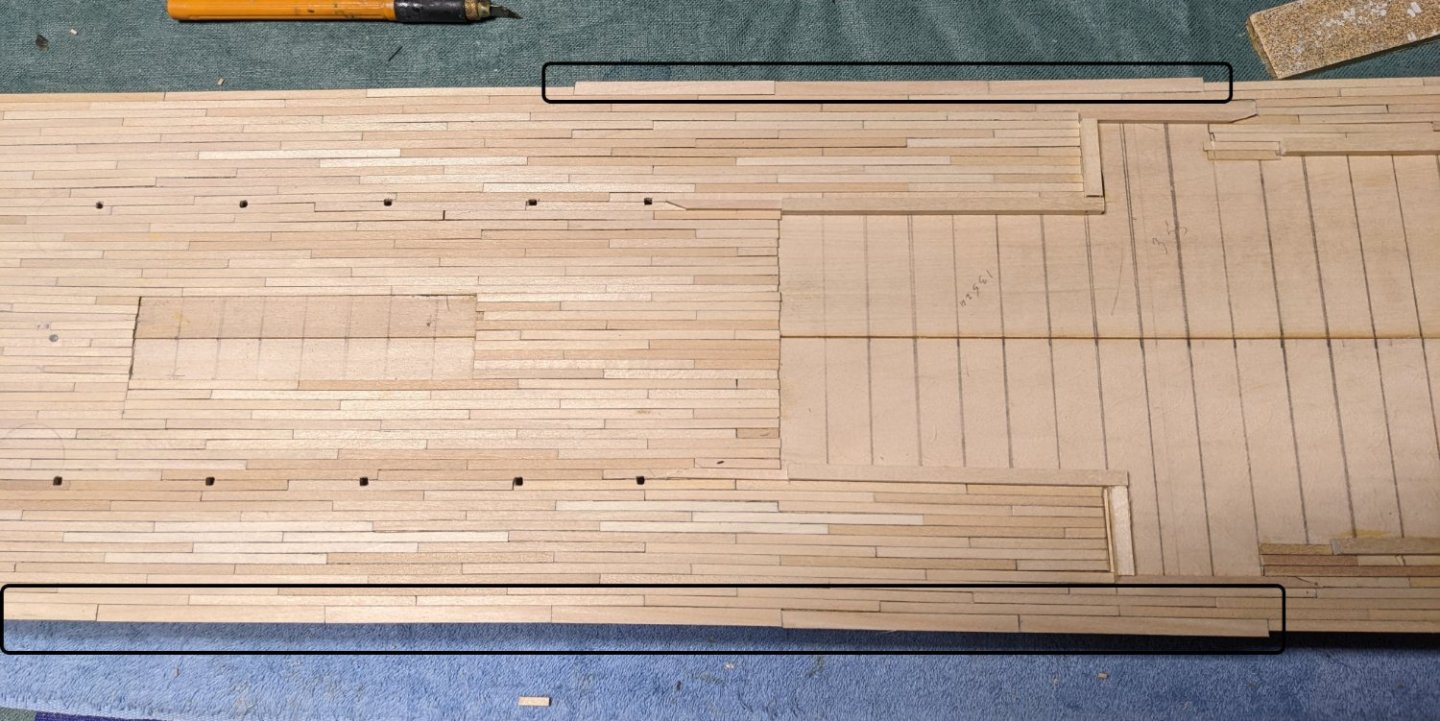
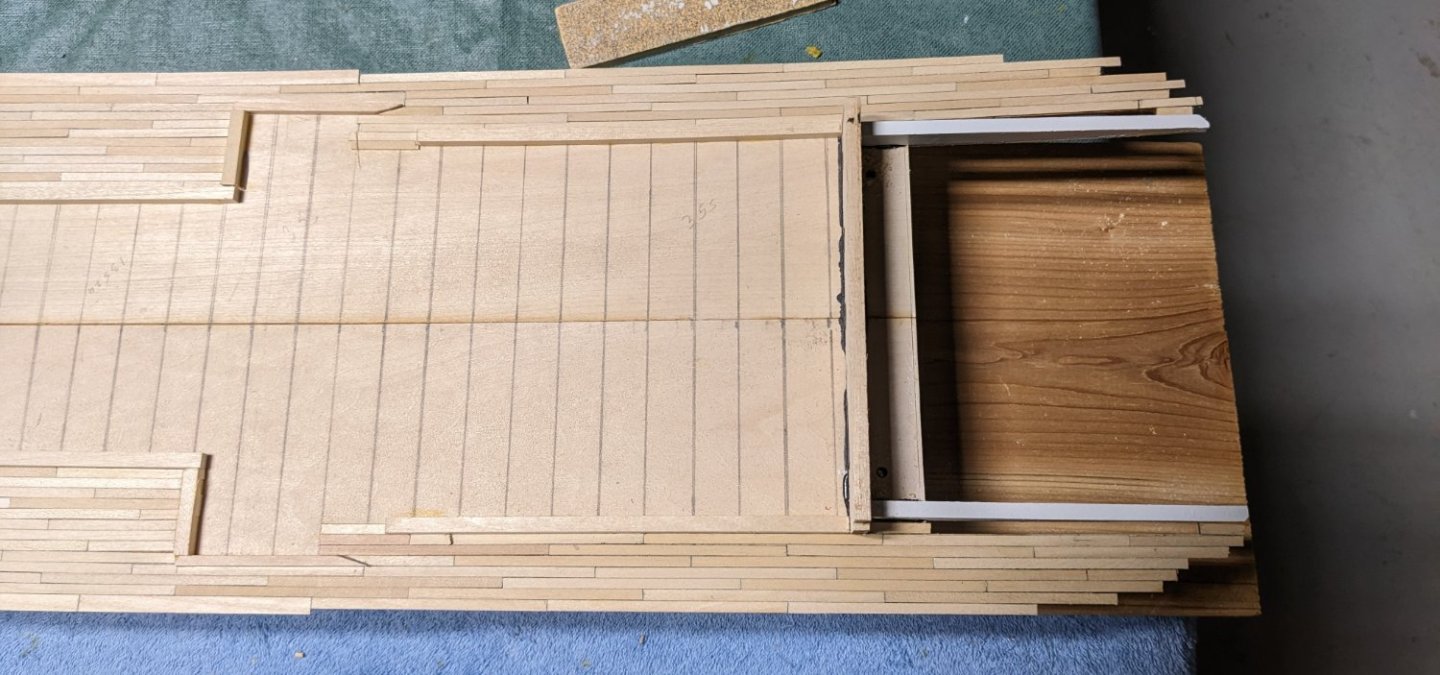
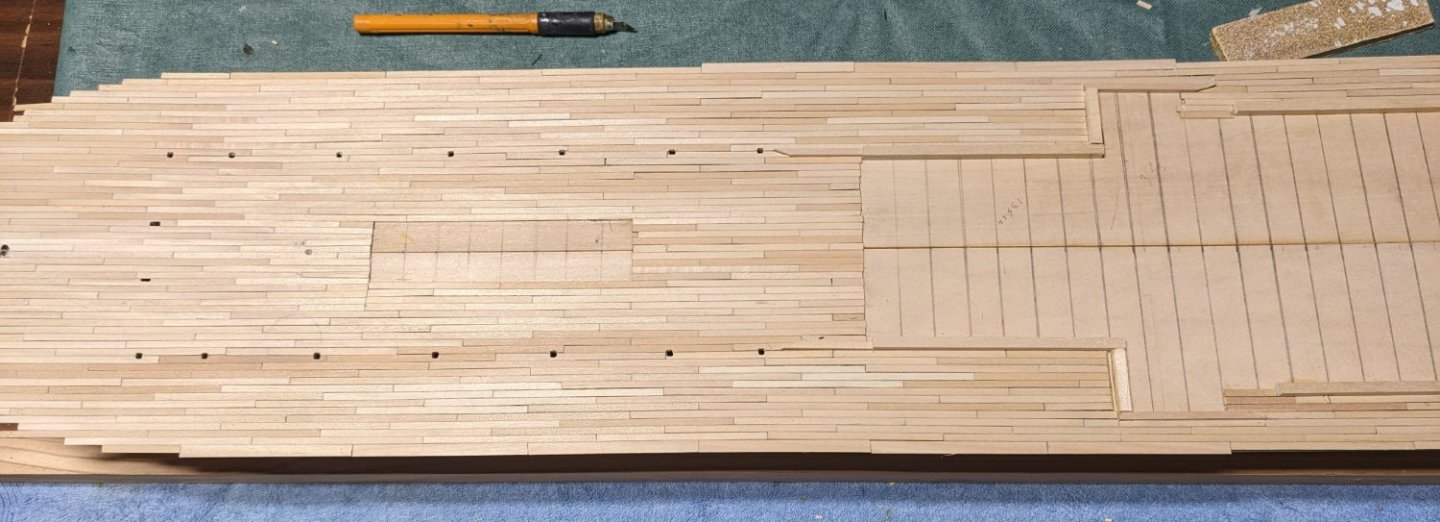
Chaperon by John Gummersall - Model Shipways - Scale 1:48
in - Kit build logs for subjects built from 1851 - 1900
Posted
I appreciate the suggestions of "silk paper used to wrap gifts" and " regular tissue paper and ModgePodge", but I think at this time I am pretty well committed to masking tape. Below are the results after painting them a matte black. After overlapping the tape I sprayed from the opposite side of the wrapped tape to more show the seams... Not real sure I like the result as the seams show up as a lighter color than the black... Not a realistic look for tar seams, but I may leave it vs applying another coat of black and cover up the seams...
Once piece of advice for novices' like my self... If you do cover the hurricane deck flooring with something, before you mount it on the main deck structure, be sure to verify all the holes in the deck have been opened up to later accept the pieces that will be going through them. Much easier now before you glue down the deck ceiling
In preparation for laying the hurricane deck flooring I wanted to double check the alignment of all the posts and stairs that need to line up. In doing so I noticed the back stairs do not exactly line up with the wall etching. From the plans the stairs are supposed to line up against the wall - thus the etchings. When I first put on the vertical strips on the walls I assumed all was good and followed the lines. After seeing about a 1/2" gap between the stairs and wall I decided that needed to change. Others have mentioned this little fact, but I forgot. Since there is about a 1/2" gap that probably was wide enough for a person to slip by, so rather than extend the stair sides to meet the wall I decided to add the strips over the stairs etching in the wall.
In the below picture, it shows the remains of the five partial strips that originally were on the wall. This was in preparation for adding new full strips.
Below shows the new strips added. I probably should have closed up the etching before attaching the strips, and it would have been a lot easier, but closing that gap with a little extra paint can be done now too.
Moral of this lesson is be sure to check the back stairs before you lay the hurricane deck flooring and make a decision as to what you want to do about the gap
With all in place the boiler deck structures can now be attached to top of the main deck. Below are a few pictures of the final result
One thing to note, on some of the raw corners I added some right angle styrene pieces to cover up the raw corner. I have some of them marked below with circles.
Just noticed I have some extra glue showing,,,, need to break out the paint and fine brush 🙂